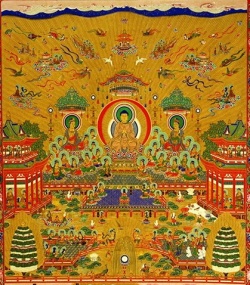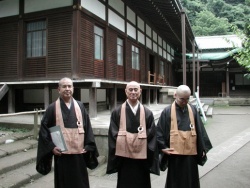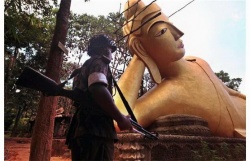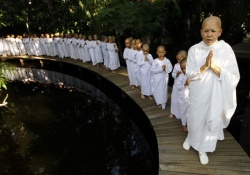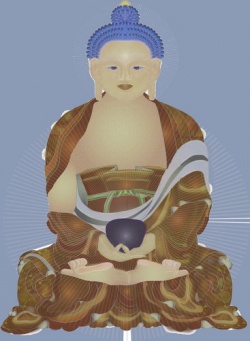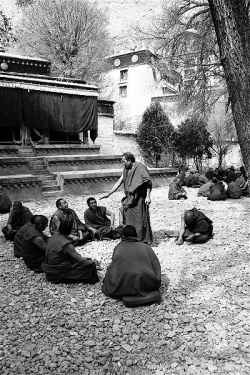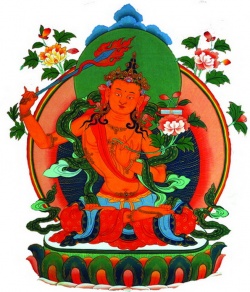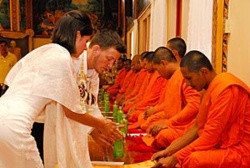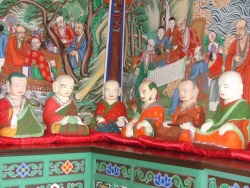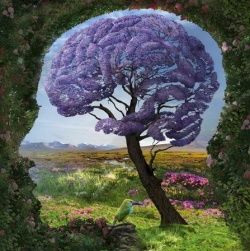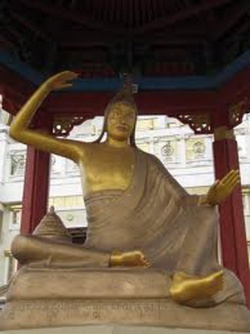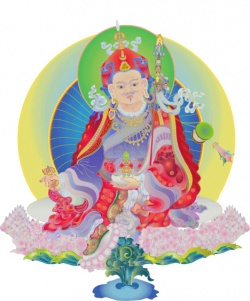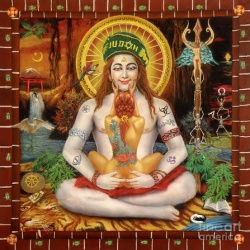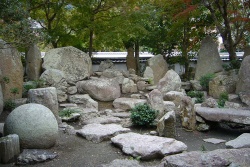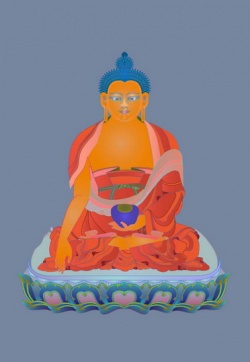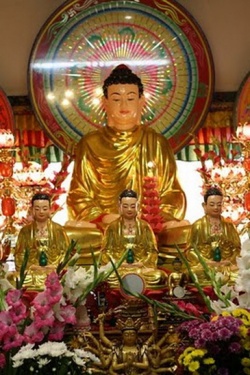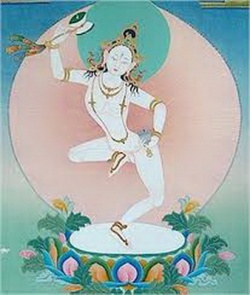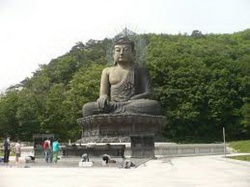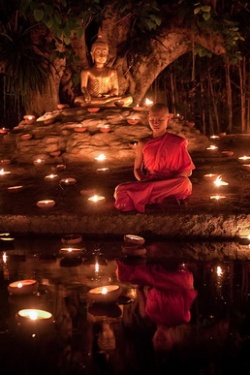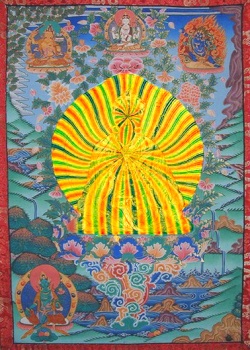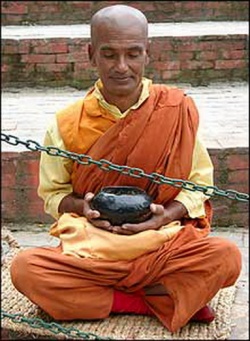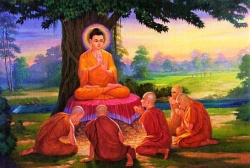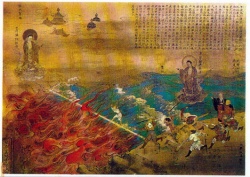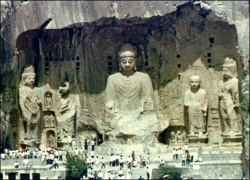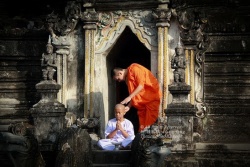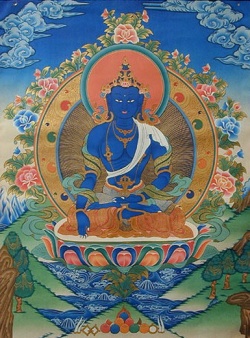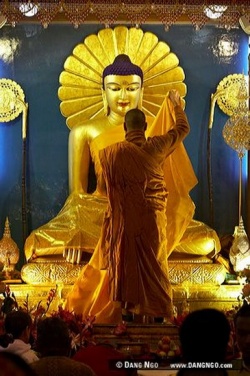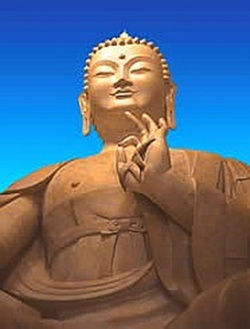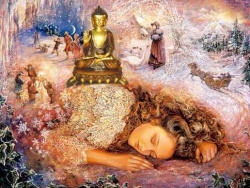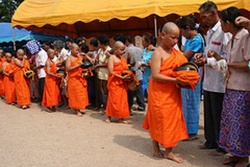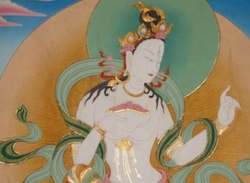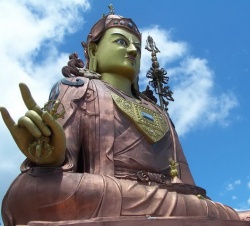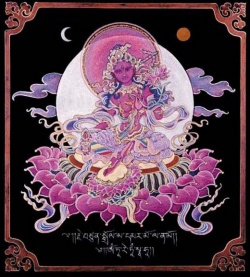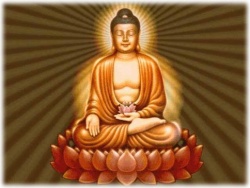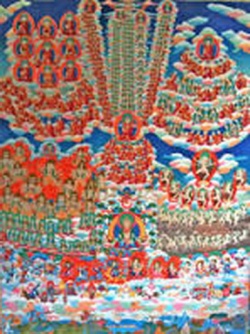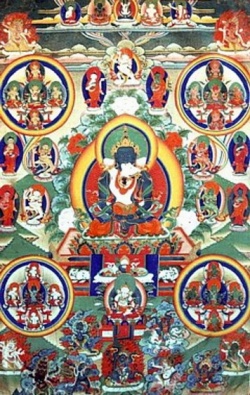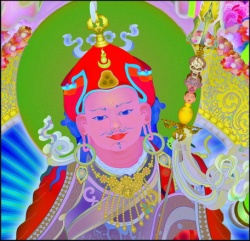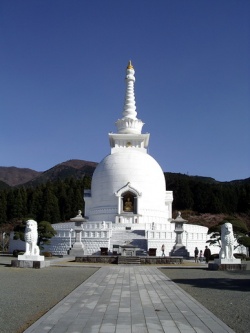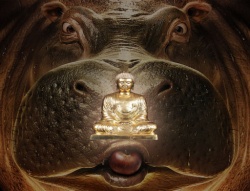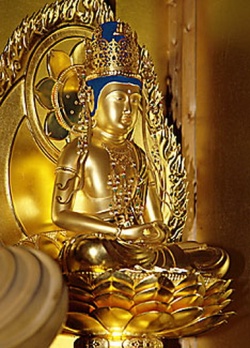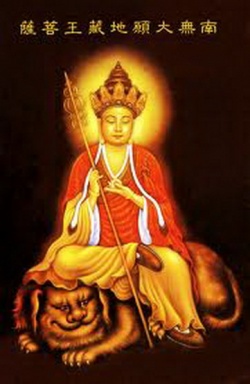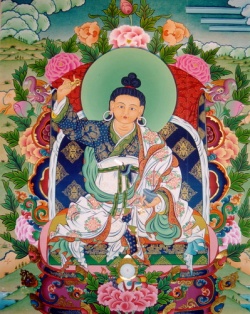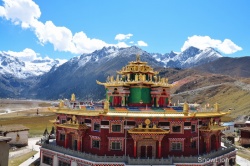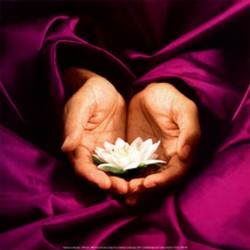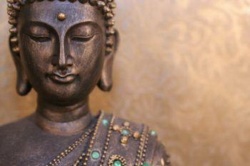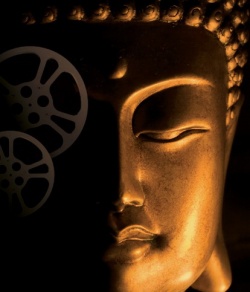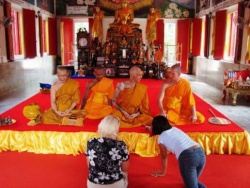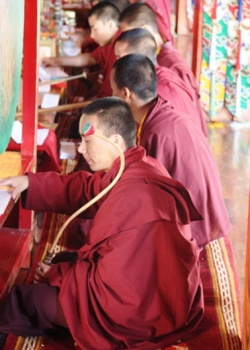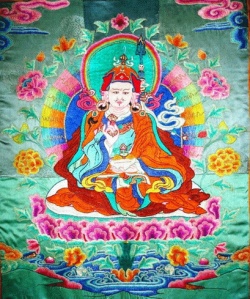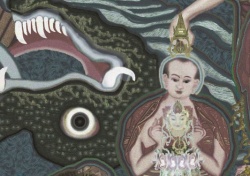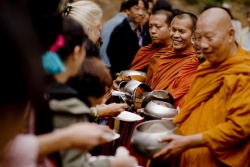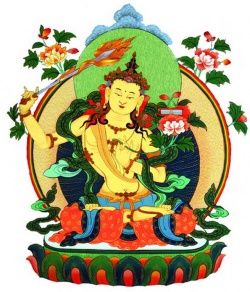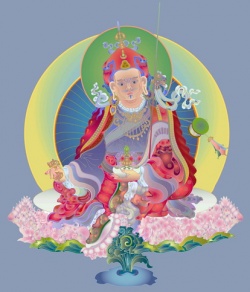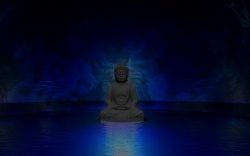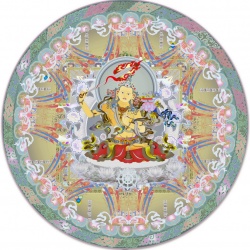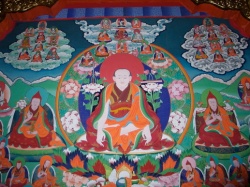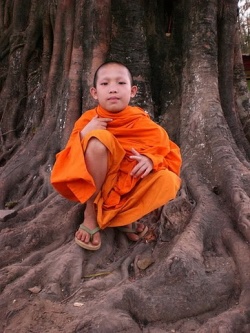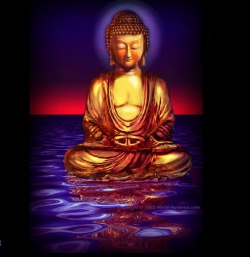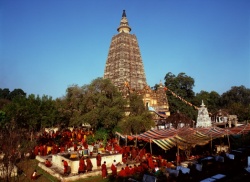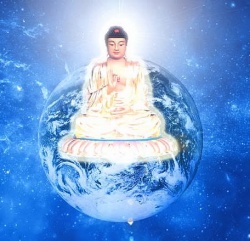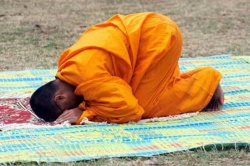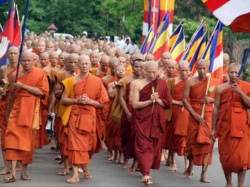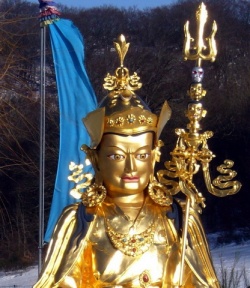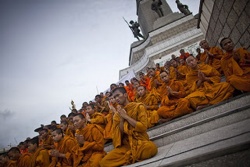Be a Lamp Upon Yourself
A group of over 10,000 earnest intellectuals once requested the Buddha to explain the manner and incidence of life and the Universe. This was followed by a series of daily lectures and demonstrations lasting three months. The Buddha's explanations were given to the complete satisfaction of everyone present.
It is most remarkable that when reduced to basic principles, many statements in the Buddhist scriptures
are in line with modern scientific discoveries. Buddhism is scientific in that it combines objective observation, experiment and analysis in the spirit of free inquiry. Buddhism is beyond Science as it can contribute to modern life by providing the moral and
spiritual guide for the individual in our increasingly technological and materialistic age, showing us the path to True Happiness. As Einstein said, "Religion without Science is blind; Science without Religion is crippled."
YOU ARE SHOT!
In reality, the Buddha never wished to spend time on speculative (or metaphysical) issues of the Universe as they have little value for spiritual development towards True Happiness. He only taught them out of Compassion - either to bring out an underlying teaching, or to satisfy the
curiosity of those who would otherwise not hear His actual Enlightenment, all speculative questions will be answered, and that we have no need to ask them now. The Buddha compared one who keeps asking speculative questions to a man shot by a poisoned arrow, who refuses to
remove it till he knows who shot it, how it was shot, from where was it shot... By the time these were answered, he would be dead. Likewise, we are "shot" by the arrow of impending death and constant dissatisfaction, and should never forget our aim of attaining Enlightenment.
MATTER
The Buddhist teaching, "Form is Emptiness; Emptiness is Form. Form is not different from Emptiness; Emptiness is not different from Form" refers to the fact that matter is neither truly solid nor ultimately different from the "emptiness" of energy, as the material can become immaterial
with no "solid" core and vice versa. It is the Buddhist version of the famous law E=mc2 (E=energy, m=mass, c=speed of light). The atomic bomb is an example of how a little matter can be converted into tremendous energy. Likewise, energy can be converted to matter. Though Science has yet to
discover how, the Buddha was recorded to have performed such "miraculous" feats. He did so only out of Compassion, to humble the proud, that He knew were already ready to listen to His teachings, only being hindered by pride.
The Buddha declared that the primary factor and most powerful force of the Universe is the Mind. Scientists today are seeing this Truth - realising that the Mind of a person can create reality in what is perceived. Mind energy is not yet fully understood by Science. The Buddha however, teaches us in great detail about the dynamics of the Mind. The mastery of the Mind is of the greatest importance as it is the key to True Happiness and liberation.
RELATIVITY
The Buddha, like Einstein, discovered the truth of relativity - that space and time are not absolute but relative, functioning interdependently. Space and time are experienced differently by individuals in different worlds and mindstates. The world experienced in the state of Enlightenment is the vivid awareness of the interpenetration of space and time.
TIME
The Buddha defined time as "the measurement of change." This is scientific as time is linked with the motion of matter (or energy) in space, which creates force. The concept of time is
meaningless when there is no change. Time has no beginning or end in Buddhism as all things (except the state of Enlightenment) undergo constant change. There is only the present central moment of "now" that is meaningful to our existence.
SPACE
In Buddhism, space is defined as the voidness in between matter which allows motion and interaction. As it extends infinitely in all directions, any point in the Universe can be considered central.
Likewise, scientists look into outer space and discover our position in the Universe to be just like any other point in space. There is no special position in the Universe as it is filled homogeneously with other world-systems. There is only the present central place of "here" that is meaningful to our existence.
ATOM
As the atom (pre-supposed to be indivisible) is recently proven to be divisible indefinitely, it is therefore not the basic unit of matter. Thus, an atom is not really an atom; it is called so for convenience. Likewise, the Buddha says that when He speaks of the "Universe" (made up of energy and atoms), He does not really mean "Universe" - He calls it so only nominally.
QUANTUM PHYSICS
Scientists discovered in quantum physics that atoms and subatomic particles do not have definite locations or "meaningful" motion, appearing random and unpredictable. This led them to conclude that the "building blocks of reality" are "imaginary ghosts". The way an observer chooses to view an
experiment determines the part of the observed phenomena to be manifested. The manifested properties are nothing but intersection and interaction of the observer's Mind with the phenomena. The theory also suggests that reality is not merely constructed by the Mind of the observer, but that there are countless realities constructed by countless Mind - each equally real or equally unreal. They may be very much
resemble each other, or be virtually opposite in nature. Likewise, in Buddhism, it is the Mind that constructs the indeterminate nature of the
manifestation of ultimate reality in a particular way. Given particular conditions, the Mind constructs reality in a determinate way, generally in terms of existence or non-existence and more specifically in the form of the six realms of existence or the thirty-one planes of existence.
INTERDEPENDENCE
The constituents of the material and mental Universe interact with one another and are inseparable such that nothing (no single thing) exists individually, each being equally important. The Buddha taught this as the interdependent origination of all phenomena.
CHANGE
The existence of any object is an illusion as the Universe is simply a complex process of unceasing interconnected activities in which nothing moves independently of the others. The Buddha taught this as the constant fluctuation and transient nature of all conditioned things - even to the level of minuest atomic matter.
MICROORGANISMS
The Buddha once held up a cup and remarked that there were 84,000 (a number to denote "many" or "countless") beings in it. No one understood what He meant. Today, we use a microscope and see that He referred to invisible microorganisms.
EVOLUTION OF THE UNIVERSE
The Buddha taught that the Universe undergoes two major periods of change that repeat endlessly - expansion and contraction. This is like the model of the Oscillating Universe, which says that the Universe began with a Big Bang, when all explodes and expands, forming galaxies. When the force of expansion is
depleted, the Universe closes in on itself through gravity with a Big Crunch, before expanding once more. Thus, it is likely that there have been, and will be, infinite Universes. The evolution of the
Universe is a closed cycle - not unlike the water cycle where water evaporates to form clouds before falling as rain and evaporating again. Thus, the existence of water (and all other phenomena) does not require a creator as it is a natural self-contained process.
UNIVERSE STRUCTURE
According to the Buddha, the Universe exists in tiers, the smallest being the Thousand-fold Minor World System - this describes a galaxy (eg. the Milky Way), which contains millions of stars and planets. The next tier is called a Twice-a-Thousand Middling World System - this
describes galactic clusters (eg. Coma Berenices). The Middling World System consists of up to a hundred or thousand galactic clusters. Next is the Major World System, formed by clusters of Middling
World Systems - this describes a Metagalaxy (eg.the Big Dipper that "frames" at least a million galaxies). Though this is the farthest that modern scientific instruments can observe only recently, the Buddha taught this cosmic view long before the invention of the telescope.
GALAXIES
The Buddhist scriptures described that there are "worlds shaped like flowers" - this corresponds to billowy intergalactic gas clouds (that contain billions of stars) observed by radio-telescopes. "Some are vast as the ocean, spinning like a turning wheel. Some are slender (eg. galaxies observable in Cetus,
Pegasus and Hercules). Some are small. For they have countless forms. (Galaxies have countless shapes.) And they spin in various ways (Galaxies revolve around their nuclei.)... Some worlds are like a glowing wheel (Some galaxies have strong luminosity)."
QUASARS
Some world systems (galaxies) are described in the Buddhist scriptures to erupt violently like volcanoes. This corresponds to quasars that actively explode, ejecting incredible amounts of matter from the nuclei of galaxies.
BLACK HOLES
Some cosmic worlds are described in the Buddhist scriptures to be like the "Lion's mouth" which eat everything - this corresponds to Black Holes that devour everything within its gravitational reach.
PLANETS
The Buddhist scriptures describe that, "Many world-systems are full of rock-torn earth - dangerous and destroying." While this may be true of planets of other star-systems, it is proven for our Solar System's planets such as Mars and Venus. The Earth was also described to have formed out of a mass of heavy thick matter that gradually hardened to solidify - this is agreed by Science.
EVOLUTION
The Buddha's teaching agree with Darwin's theory of Evolution and Natural Selection to a certain extent. It teaches that all sentient beings, by their instinctal will to survive, continuously evolve either into higher (and more intelligent) life forms or "de-evolve" into lower life forms (through the force of Karma - in a single life or through rebirth). This carries on indefinitely till one attains the highest state of evolution, becoming a Buddha - having fully evolved both mentally and physically.
The Buddha's account of how life arose and developed in out world is startlingly similar to parts of the theory of evolution as proposed by Charles Darwin. In the Aganna Sutta, the Buddha relates the becoming and re-becoming of the Universe over a period of countless millions of years in relation to the evolution of Human Beings, the arising of good and evil in society, and how such a society progressed. The Buddha also taught on how the first life formed on the surface of the water of the Earth, and again, over countless millions of years, evolved from simple to complex organisms. All these processes are without beginning or end, and are set in motion by natural causes. In the Brahmajala Sutra, it is also recorded on how the previous Universe ended and stabilised, re-evolved and restabilised with the appearance of the beings of the different planes of existence.
ENERGY
Buddhism believes in the indestructibility or preservation of energy. This is in line with the law of conservation of energy, which states that energy can neither be created nor destroyed; it can only be transformed from one form to another. The teaching of rebirth, is an example of the transfer of imperishable Mind or mental energy from one body into another.
ALIENS
The Buddha described worlds beyond ours in the vastness of outer space and other dimensions which are inhabited by many other intelligent sentient life forms, many of which are not unlike ours. The possible existence of extra-terrestrial life is highly agreeable among scientists today.
CAUSALITY
The Buddha taught that all physical and mental phenomena are brought about by the combination of causes and conditions. The law of Karma (the Buddhist law of cause and effect) is equivalent to the law of causality (causation) in Science. It is the belief that there is a cause for every single thing (effect) that occurs or exists. With the right conditions, every effect can in turn be the cause of another effect. There are no unexplainable, random or supernatural phenomena in Buddhism. The supernatural is only nature yet understood by the unenlightened.
The Buddha was the first to look in depth into the human psyche and its experience. His teaching is a radical cure for mental dissatisfaction. The West is discovering that modern psychology is but a recent extension of Buddhism. Buddhist meditation undeniably offers the most timeless yet advanced methods for self-healing and psycho-therapy.
PSYCHIC POWERS
E.S.P. (Extra Sensory Perception), telekinesis and other such phenomena are explained by the Buddha as psychic powers are achievable by anyone who trains to concentrate and focus the Mind (this is "Mind over matter"). As the Mind is the most powerful force in the Universe, mastery of the Mind opens the gates to unlimited power. The Buddha Himself was fully capable of psychic powers as He had mastered His Mind perfectly. However, knowing that psychic powers do not bring "sideshows" to inspire faith, being secondary to His teachings.
ELECTRON
In the words of the famous American physicist J. Robert Oppenheimer, "If we ask, for instance, whether the position of the electron remains the same, we must say 'no'; if we ask whether the electron's position changes with time, we must say 'no'. The Buddha has given such answers when interrogated as to the conditions of a man's self after his death..."
A Bodhisattva's Right Attitude Toward Other Bodhisattvas A Dharma Talk by Ryuei July 2003
Good morning. Today I would like to share with a page from the Perfection of Wisdom in 8,000 Lines. This page has become important to me because I ran across it at exactly the right time when I needed to reflect on my own attitudes and ways of interacting with others, especially other Buddhists. Let's read this together and then discuss it. "I have, Ananda, demonstrated a dharma which includes the possibility of escape, - for persons of the Disciple-vehicle, for persons of the Pratyekabuddha-vehicle, for persons of the Bodhisattva-vehicle. As to the person who belongs to the vehicle of the Bodhisattvas and has quarreled with someone else who belongs to the vehicle of the Bodhisattvas, - if he does not confess his fault, does not promise restraint in future, harbors a latent bias towards hate, and dwells tied to that bias, - of that person I do not teach the escape [i.e. from the consequences of his action), but he is definitely condemned to go on putting on the armor [which enables him to struggle against it] for all that length of time.
But I teach his escape if he confesses his fault, promises restraint in future, and reflects as follows: "I whose duty it is to drive away, to pacify and appease the quarrels, disputes and conflicts of all beings, yet I myself engage in disputes! It is indeed a loss to me, and not a gain, that I should answer back as I am spoken to. When I should be to all beings a bridge across the sea of birth-and-death, I nevertheless say to another, 'the same to you,' or return a harsh and rough answer. This is not the way in which I should speak. In fights, quarrels and disputes I should not behave like a senseless idiot, or like a dumb sheep. When I hear someone using offensive, abusive, insulting words towards me, my heart should not cherish malice for others. It is not meet and proper for me to perceive the faults of others, or to think that what is being said about the faults of others is worth listening to.
For I, since I am earnestly intent [on full enlightenment), should not do harm to others. When I should make all beings happy by giving them everything that brings happiness, when I should lead them to Nirvana after having won full enlightenment, - yet nevertheless I bear ill will! I should not bear ill will even against those those who have offended against me, and I must avoid getting into a rage, and I must make a firm effort in that direction. Even when my life is in danger I must not get into a rage, and no frown should appear on my face." Of such a Bodhisattva I teach the escape. This is the attitude which a Bodhisattva should adopt also towards persons who belong to the vehicle of the Disciples.
Never to get angry with any being, that is the attitude of mind one should adopt towards all beings. What attitude then should a Bodhisattva have towards other persons belonging to the vehicle of the Bodhisattvas? The same as towards the Teacher. He should have the attitude that "these bodhisattvas are my teachers." Surely, they have mounted on the same vehicle as I, have ascended by the same path, are of like intention with me, have set out in the same vehicle as I. Wherein should they be trained, that is the method by which I should be trained. But if some of them dwell in a dwelling contaminated [by the ideas of Disciples and Pratyekabuddhas), then I should not do likewise. If, however, they dwell in an uncontaminated dwelling, in mental activities associated with all-knowledge, then I also should train as they do. No obstacles to full enlightenment can arise to a Bodhisattva who trains himself in this way in all-knowledge, and he quickly knows enlightenment."
(The Perfection of Wisdom in 8,000 Lines pp. 247-8)
Originally, this page jumped out at me in my readings of the Perfection of Wisdom because it seemed so familiar, especially the phrase "the same to you." How often have I felt the very same feelings, or used those words or something like it myself. It is very difficult to avoid sometimes, especially when we feel that we are justified, that we have been wronged, or that we have been patient far too long. But it is easy to read passages like this or the story of Bodhisattva Never Despise in the Lotus Sutra - the Bodhisattva who greeted all people with respect even when he was abused in return - it is another thing to actually be able to live in accord with these teachings. Of course this is where the practice of Odaimoku comes in.
The practice of Odaimoku allows us to step back from our situation. We move away from our sense of being wronged and our self-justifications of our own intentions, words, and actions. Instead, we put these aside and center ourselves back on the Dharma through our practice. In this way we can begin to cool down and get a more objective view. This may not be automatic. It may take a lot of chanting to get some emotional distance from the problems we are having with others. But I have found that it does work. Of course, when you get back into the situation new things may be said or new aggravations may arise, and so one must go back again and again to the Odaimoku.
Through chanting and reflection however I have learned a few things. One is that one must be very careful not to attribute motives to others. One may feel that others have it in for you, or that they are being condescending or that they are trying to put you down and get others to pick sides against you. But this may just be one's own fear and projection. And even if it is not, to retaliate and harbor resentment only adds fuel to the fire. Sometimes the best thing to do is to just let people be who they are. And as the passage says, act dumb. In other words, reserve judgement and try not to take things personally. In the end, our ego, the very one that is hurt and which we are trying to defend, is a much worse enemy than anyone else.
Others may or may not be out to get us, but our ego will trip us up every time if we don't keep a careful watch on it. What I have found is that if we can set the ego aside, most problems can be seen to arise from misunderstandings and/or impatience.
In the end, I am discovering that giving others the benefit of the doubt and taking the time to really listen and understand what the other person is saying can be invaluable. Even if you do not agree at least take the time to hear them out so that you can discover why they think or feel a certain way. Sometimes a seemingly sharp disagreement can disappear altogether when one does this - as one sees that the other person is using words differently than you might, or that a further explanation will clarify where they are coming from and enable you to see something you might have missed. So in the end, I am trying to take this passage to heart through Odaimoku and the practice of patient and active listening.
Copyright by Ryuei Michael McCormick. 2003.
Alayavijnana - Store Consciousness By Venerable Dr.Walpola Rahula
In the Yogacara (Vijnanavada) School of Buddhism, alayavijnana is one of the most important doctrines developed by Asanga (fourth century A.C.). He divides the vijnanaskandha (Aggregate of Conciousness) the fifth of the five skandhas, into three different aspects or layers, namely, citta, manas and vijnana. In the Theravada Tipitaka as well as in the Pali Commentaries, these three terms - citta, manas, vijnana - are considered as synonyms denoting the same thing. The Sarvistivada also takes them as synonyms. Even the Lankavatarasutra, which is purely a Mahayana text, calls them synonyms although their separate functions are mentioned elsewhere in the same sutra.
Vasubandhu, too, in his Vimsatikavijnapti-matratasiddhi considers them as synonyms. Since any one of these three terms - citta, manas, vijnanas - represents some aspect, even though not all aspects, of the fifth Aggregate vijnanaskandha, they may roughly be considered as synonyms. However, for Asanga, citta, manas and vijnana are three different and distinct aspects of the vyjnanaskandha. He defines this Aggregate as follows: 'What is the definition of the Aggregate of Consciousness (vijnanaskandha)? It is mind (citta), mental organ (manas) and also consciousness (vijnana).
"And there what is mind (citta)? It is alayavijnana (Store-Consciousness) containing all seeds (sarvabijaka), impregnated with the traces (impressions) (vasanaparibhavita) of Aggregates (skandha), Elements (dhatu) and Spheres (ayatana) . . . 'What is mental organ (manas)? It is the object of alayavijnana always having the nature of self-notion (self-conceit) (manyanatmaka) associated with four defilements, viz. the false idea of self (atmadrsti), self-love (atmasneha), the conceit of 'I am' (asmimana) and ignorance (avidya) ...
'What is consciousness (vijnana)? It consists of the six groups of consciousness (sad vijnanakayah), viz. visual consciousness (caksurvijnana), auditory (srotra), olfactory (ghrana), gustatory (jihva), tactile (kaya), and mental consciousness (manovijnana) Thus we can see that vijnana represents the simple reaction or response of the sense-organs when they come in contact with external objects. This is the uppermost or superficial aspect or layer of the vijnanaskandha. Manas represents the aspect of its mental functioning, thinking, reasoning, conceiving ideas, etc. Citta, which is here called alayavijnana, represents the deepest, finest and subtlest aspect or layer of the Aggregate of Consciousness. It contains all the traces or impressions of the past actions and all good and bad future potentialities. The Sandhinirmocana-sutra also says that alayavijnana is called citta (Tibetan sems).
It is generally believed that alayavijnana is purely a Mahayana doctrine and that nothing about it is found in Hinayana. But in the Mahayanasangraha Asanga himself says that in the Sravakayana (= Hinayana) it is mentioned by synonyms (paryaya) and refers to a passage in the Ekottaragama which reads: 'People (praja) like the alaya (alayarata), are fond of the alaya (alayarama), are delighted in the alaya (alayasammudita), are attached to the alaya (alayabhirata). When the Dharma is preached for the destruction of the alaya, they wish to listen (susrusanti) and lend their ears (srotram avadadhanti), they put forth a will for the perfect knowledge (ajnacittam upasthapayanti) and follow the path of Truth (dharmanudharma-pratipanna). When the Tathagata appears in the world (pradurbhava), this marvellous (ascarya) and extraordinary (adbhuta) Dharma appears in the world.'
Lamotte identifies this Ekottaragama passage with the following passage in the Pali Anguttaranikaya (A II, p.131): Alayarama bhikkhave paja alayarata alayasammudita, sa Tathagatena analaye dhamme desiyamane sussuyati sotam odahati annacittam upattapeti. Tathagatassa bhikkhave arahato sammasambuddhassa patubhava ayam pathamo acchariyo abbhuto dhammo patubhavati.
Besides this Anguttara passage, the term alaya in the same sense is found in several other places of the Pali Canon. The Pali Commentaries explain this term as 'attachment to the five sense-pleasures", and do not go deeper than that. But this also is an aspect of the alayavijnana.
In the Lankavatarasutra the term tathagatagarbha is used as a synonym for alayavijnana and is described as 'luminous by nature' (prakrtiprabhasvara) and 'pure by nature' (prakrtiparisuddha) but appearing as impure 'because it is sullied by adventitious defilements' (agantuklesopaklistataya). In the Anguttaranikaya, citta is described as 'luminous' (pabhassara), but it is 'sullied by adventitious minor defilements' (agantukehi upakkilesehi upakkilittham). One may notice here that alaya-vijnana (or tathagatgarbha) and citta are described almost by the same terms. We have seen earlier that the Sandhi-nirmocana-sutra says that alayavijnana is also called citta. Asanga too mentions that it is named citta.
It is this alayavijnana or citta that is considered by men as their "Soul', 'Self', 'Ego' or [[Atman]
]. It should be remembered as a concrete example, that Sati, one of the Buddha's disciples, took vinnan (vijnana) in this sense and that the Buddha reprimanded him for this wrong view.
The attainment of Nirvana is achieved by 'the revolution of alayavijnana' which is called asrayaparavrtti. The same idea is conveyed by the expression alayasamugghata 'uprooting of alaya' which is used in the Pali Canon as a synonym for Nirvana. Here it should be remembered, too, that analaya 'no-alaya' is another synonym for Nirvana.
The alayavijnanaparavrtti is sometimes called bijaparavrtti 'revolution of the seeds' as well. Bija here signifies the 'seeds' of defilements (samklesikadharmabija) which cause the continuity of samsara. By the 'revolution of these seeds' one attains Nirvana. Again the Pali term khinabija, which is used to denote an arahant whose seeds of defilements are destroyed', expresses the same idea . Thus one may see that, although not developed as in the Mahayana, the original idea of alayavijnana was already there in the Pali Canon of the Theravada.
An Introduction to Buddhism for Health Professionals By Graeme Lyall
In the year 563B.C. on the border of modern day Nepal and India, a son was born to a chieftain of the Sakya clan. His name was Siddhartha Gotama and at the age of thirty-five, he attained, after six years of struggle and through his own insight, full enlightenment or Buddhahood. The term 'Buddha' is not a name of a god or an incarnation of a god, despite later Hindu claims to the contrary, but is a title for one who has realised through good conduct, mental cultivation, and wisdom the cause of life's vicissitudes and the way to overcome them. Buddhism is perhaps. unique amongst the world's religions in that it does not place reliance for salvation on some external power, such as a god or even a Buddha, but places the responsibility for life's frustrations squarely on the individual.
The Buddha said:
By oneself, indeed, is evil done; By oneself is one defiled.
By oneself is evil left undone; By oneself indeed is one purified.
Purity and impurity depend on oneself. No one purifies another.
His teaching can be summarised as:
Not to do any evil,
To cultivate good,
To purify one's mind,
This is the Teaching of the Buddhas. To many people of other faiths the term 'Buddha' conjures up ideas of idol worship and concepts, such as, that Buddhists are atheists, such concepts being an anathema to the followers 'of the, so called
'religions of the book'. Buddhism, certainly, is very different from the Semitic religions, but it may surprise many of its critics to know that the Buddha condemned idolatry. When, just prior to his passing away, he was asked how he could be remembered he replied that those who practised his teachings would remember him best.
Prior to the arrival on the Indian sub-continent of the Bactrian-Greeks, Buddha images were unknown. The Buddha foresaw that worship of him in any form would result in his deification with its consequent emphasis on seeking salvation from an external power rather than identifying Nirvana, the eradication of greed anger and delusion, as being solely within one's own power.
Indeed, he was right. For many ethnic Buddhists, he is a God from whom they ask favours. However, Buddhists feel uncomfortable in acknowledging a Creator of the world. Buddhists do accept that there is a transcendental state possible of realisation by each and every one of us. We certainly do not
accept the concept of an anthropomorphic god but many Christians, Jews and Muslims would join us in such a rejection. Buddhists, generally, are uncomfortable in using the term "God", because there is no clear definition of to what such a term refers. Indeed, an anthropomorphic view of God would be considered by Jews and Muslims to be idolatrous.
If, as is the case with many modern theologians, one holds the Tillichian view that God is the "Ground of Being" - the very fact of existence - then no Buddhist could argue with this. However, a Buddhist would be hesitant in using the term 'God'. To a Christian, a Jew and a Muslim, this
may be termed 'God', whereas a Buddhist would use the term 'Nirvana'. I feel that we are talking about a similar concept. Like most major religions, as time passed since the death of its founder, different sects or schools of thought arose however the essential teachings of the Buddha are accepted as
pivotal to all schools of Buddhism. They differ mainly on the emphasis that they place on certain aspects of the teaching and in their interpretation of the monastic rules governing the conduct of the clergy known as the Sangha.
The Theravada school, that followed by Buddhists from such countries as Sri Lanka, Burma, Thailand, Laos and Cambodia, claims to adhere strictly to the original teachings of the Buddha as contained in the Pali scriptures and it emphasises the goal of personal salvation for the
individual follower. The Sangha of the Theravada is expected to observe to the letter the 227 rules laid down in a collection of books called the Vinaya, which includes such rules as
eating only prior to midday and refraining from handling money. Four of these 227 rules, if broken, entail expulsion of the transgressor from the monastic order. They are: killing a human being, sexual intercourse, stealing and falsely claiming supernormal powers.
Should a Buddhist monk of the Theravadin tradition come under your care, it could create a problem. Theravadin monks are not supposed to make any physical contact with a member of the opposite sex. This means that, preferably, male nurses should be used where possible when caring for these
monks. The Mahayana school, followed mainly in China, Korea, Japan and Vietnam, is less rigid in its interpretation of the Teachings and emphasises the importance of the follower's becoming a Buddha for the salvation of all living beings.
The Mahayana Sangha observes strict vegetarianism, unlike the Theravada where vegetarianism is optional, but Mahayana monks will eat in the evening. The post-midday meals are regarded as medicine. Some Mahayana sects, notably in Korea and Japan, admit married priests. The Vajrayana school,
followed in Tibet and Mongolia and attracting many Western followers, is essentially the same in its interpretation of the Teachings as the Mahayana but it stresses the importance of the acceptance of a personal teacher who initiates his followers into, so-called, secret teachings known as Tantra.
Neither the Theravada nor the mainstream Mahayana schools accept that there are such things as 'secret teachings' in Buddhism. The central teaching of all schools of Buddhism is grounded in the "Four Noble Truths". The first truth is that life is subject to Dukkha. Dukkha is often
translated as 'suffering' but it is much more than that. It certainly means physical and mental suffering but it also means that life is full of frustrations - we would always prefer things to be other than the way they are. As we grow old, we wish we could remain young. If we are poor, we wish we could be rich. When we are separated
from our friends and loved ones, we are saddened. Dukkha is birth sickness, old age, pain and despair, separation from those whom we like and association with those whom we dislike. All of these are examples of Dukkha and that is the First Noble Truth.
The Second Noble Truth states that the Cause of Dukkha can be attributed to three things - greed, anger and a deluded mind. We tend to be attached to people and material things and when we are separated from them, we suffer regret. We cling to these things as if they will last forever and we find it hard to accept the fact that they don't. We get angry or have aversions to those things that we do not like.
Buddhism teaches that anger harms the one who is angry more than the object to which this anger is directed. Anger causes heating of the blood and an unpleasant appearance. The more we get angry with someone and they react to our anger the more this anger increases. Anger is unproductive -
it doesn't solve the problem. Our minds are deluded because we do not see things as they really are - that is, subject to impermanence, frustrating and devoid of a permanent self or substance. Everything,
material or immaterial, is subject to change or impermanence. Perhaps you are sitting comfortably in your chair listening to me. If you remain in that chair for the next three hours, without moving, do you still think you could regard the chair as comfortable? \
Believe me, I do not intend to keep you here for the next three hours. If you remained fixed in that chair for a month, you would probably find that you are crippled and unable to move. Instead of being a health carer, you will probably become a patient. If you remain in that chair for a hundred years, you will probably be a
skeleton and the chair will be fairly seedy too. Professor Lewis Lancaster, from UCLA, relates that, when visiting Australia, and getting on the aircraft in Los Angeles he was sitting in a very comfortable seat.
After sixteen hours non-stop flight he realised the truth of impermanence. He could not wait to get away from that seat. What starts as being regarded as 'comfortable' can soon change to being uncomfortable. Everything is relative.
The way we see things depends on the time, place and current situation. We, ourselves, are subject to this change. Every cell in our body is constantly ageing and dying and being replaced. Our thoughts and
ideas are constantly changing or being modified. Your thoughts and ideas, since you came to this chapel, are different. They have changed considerably. Is there anything in you which is not subject to change? This is why Buddhists say, in the ultimate sense, there is no 'you' or unchanging self entity.
This change and this "no self' is difficult to accept and is, therefore, Dukkha. The third Noble Truth concerns the overcoming of Dukkha, that is, overcoming the greed anger and delusion that are the source of Dukkha. Accepting change as a characteristic of life and not becoming angry or frustrated about it is part of the way to overcoming Dukkha. The overcoming of Dukkha is termed "Nirvana". Nirvana is not a place but a state of mind - a mind that sees things as they really are and not clouded by delusion. The Fourth Noble Truth is the method taught by the Buddha for attaining the state of Nirvana.
It is known as the Noble Eightfold Path. You may be wondering why the term 'Noble' is used for the Path. One who walks the Path is considered to be a noble person. The eight steps of the Path are: Right Understanding, that is knowledge that the Four Noble Truths lead to the overcoming of Dukkha. It does not imply a total understanding of these Truths but a confidence that, by following the Path, the result will be attained.
Right Thought is to be constantly aware of one's thoughts and actions and thereby avoid harm to any living creature. Right Speech is awareness of one's speech so that, what one says, is beneficial to the hearer. Right Action is to be aware of one's actions and observe the five precepts so that one does not cause harm to oneself or any other living creature. The five precepts are: To undertake the training to avoid taking the life of beings. This precept applies to all living beings not just to humans. All beings have a right to their lives and that right should be respected.
This would include the unborn, so abortion is not an acceptable alternative for controlling the population, however, contraception is not an issue as far as Buddhists are concerned. Its corollary is to protect and respect the life of all beings. To undertake the training to avoid taking things not given. This precept goes further than mere stealing.
One should avoid taking anything unless one can be sure that is intended for you. Its corollary is to cultivate generosity. This has the added bonus of eradicating attachment. To undertake the training to avoid sensual misconduct. This precept is often mistranslated or misinterpreted as relating only to sexual misconduct but it covers any overindulgence in any sensual pleasure such as gluttony as well as misconduct of a sexual nature. A Buddhist should be mindful of the possible effects on themselves and on others of improper sexual activity. This precept would include adultery because this also breaches the precept of not taking what is not freely given.
A relationship with someone who is committed to another is stealing. Similarly in cases of rape and child abuse, one is stealing the dignity and self respect of another. One is also the cause of mental pain, not to mention physical pain so one is causing harm to another living being. Therefore, such behavior is breaking several precepts. Its corollary is to respect the dignity and rights of all beings - to treat each female as your own sister or mother and each male as your brother or father. To undertake the training to refrain from false speech. As well as avoiding lying and deceiving, this precept covers slander as well as speech which is not beneficial to the welfare of others. Its corollary is to become trustworthy and considerate. To undertake the training to abstain from substances which cause intoxication and heedlessness.
This precept is in a special category as it does not infer any intrinsic evil in, say, alcohol itself, but indulgence in such a substance could be the cause of breaking the other four precepts. Its corollary is to develop clear thinking and an alert mind. These are the basic precepts expected as a day to day training of any lay Buddhist. Right Livelihood is to earn one's living in a way that does not cause harm or suffering. Such occupations as the selling of intoxicants, firearms or animals for slaughter would be considered inappropriate for Buddhists. Right Effort is the avoiding of evil which has not already arisen, rejecting evil which has already arisen, the acquiring of wholesome things which have not yet been acquired and the stabilising of those wholesome characteristics that have already been acquired.
Right Mindfulness is training in constant awareness of the effects of one's actions, whether of body, speech or mind, and thus avoiding harmful actions. Right Concentration is cultivating the mind through concentration and meditation so that one attains intuitive insight or highest wisdom. Most Buddhists believe that, upon the dissolution of the body, rebirth may take place in a state consistent with the qualities of the consciousness energy, or resultant of past actions, known as karma, at the time of death. This rebirth may occur in human form, animal form, as a ghost, in a blissful state or in a woeful state. Each of these states is impermanent and lasts as long as the karmic energy, which was the cause of that rebirth, sustains it. In other words, we are subject to a constant round of rebirths until Nirvana, or the release from rebirth is attained.
The Theravada tradition believes that rebirth is instantaneous upon the death of the individual, whereas the Mahayana and Vajrayana traditions believe in an intermediate state, known as antarabhava, which can last until the right conditions for rebirth prevail. What is more important for the dying patient than ceremonies after death, is the care received in the days leading up to their passing. Every effort should be made to direct their thoughts to the positive aspects of their lives. This is where a visit from a member of the Buddhist clergy can be beneficial., however chaplains and nursing staff, being aware of the importance of positive thoughts, can also be helpful in this regard. Buddhists believe that the final thoughts of a being are crucial in determining their state of rebirth. With patients from a Chinese background, it is common for a group of lay Buddhists to visit and chant the name of the Buddha of Infinite Light, Amitabha.
The Amitabha Buddhist Association in New South Wales provides such a service. Another useful device is the chanting machine which can be placed close to the patient so that they are constantly aware of the name of Buddha Amitabha. I have used this with a patient in a coma by placing the machine under their pillow so that, should they regain consciousness, this will be the first thing that they hear. Hearing this chant can contribute to relieving the patient's anxiety and also direct their thoughts positively.
It is very important to be aware of the ethnic background of the patient. This chanting has relevance only to patients of Chinese background. For patients from other ethnic groups, it is advisable to contact the appropriate Buddhist clergy. Following the death of a patient, from the Theravadin or Southern School, rebirth occurs at the instant of death. The clergy can comfort the family and arrange to attend the funeral for blessing chanting.
Many Theravadins will willingly offer the body of the deceased for organ transplants. This is due to the belief that the energy of the deceased has completely passed on and the body serves no further purpose for the deceased. However, the position concerning the Mahayana and Vajrayana traditions is quite different. As I have alredy mentioned, they accept an intermediate or limbo state before rebirth takes place. Preferably, they prefer that the body not be touched for forty eight hours following the death. It is held that the consciousness energy may not leave the body until this time period has passed.
This may seem impractical in a hospital situation but touching or moving the body during this critical period is a cause of much concern, especially to the immediate family. The majority of Mahayana Buddhists would, therefore, prefer that their relatives pass away at home. Three conditions are necessary for conception in the womb of either a human or animal to occur, that is, male sperm, female ovum and the karmic energy that has passed over from the previous incarnation. Karma is not a reward or punishment for past actions but rather a natural result or outcome of them. Buddhists do not accept the concept of a creator god who sits in judgement on his creation.
We are our own creator by our past actions. The Law of Karma states "We are what we have done and we will be what we are now doing". On a popular level as taught in institutionalised Buddhism, whenever misfortune or happiness befalls us, it is due to our past karma. This tends to imply a punisher or rewarder, in other words a judging god, an idea which Buddhists reject. That is why many modern Buddhist scholars interpret Karma as a psychological phenomenon. Bad actions cause remorse, regrets and feelings of guilt which disturb our peace of mind, whereas good actions bring joy and happiness and peace of mind. Buddhists of all schools regularly perform the action of 'Taking Refuge'. A refuge is a shelter or safe haven and similarly, in Buddhism, taking refuge is considered to be a protection.
The refuges are:- The Buddha - the teacher, is referred to in the scriptures as "Teacher of gods and men". The Dharma - his teaching. Before the Buddha passed away, he told Ananda, his chief disciple, that after his passing, the Dharma would be the teacher. The Sangha - is the community of followers. More specifically, it refers to those who have left home to follow the spiritual life, the Bhikkhus and Bhikkhunis or Buddhist clergy. In the broader sense, it includes those who are following his teachings whether they be monastic or lay.
The initial recitation of the "Three Refuges", before a member of the monastic Sangha, constitutes formally becoming a Buddhist. In the Tibetan tradition, an additional refuge is added, that of taking refuge in the teacher, who initiates the student. Another important devotional practice is the recitation of the five precepts, known as the 'Panca Sila'. These are training rules and, unlike, say, the Ten Commandments in Christianity, they are not based on fear and feelings of guilt.
A Buddhist should undertake training to try to observe these precepts but, if a precept should be broken, one should analyse one's action and try to avoid breaking it in the future. This is not to suggest that the consequences of this unwholesome action or Karma will be avoided - the admonition in the Christian Bible, "as ye sow, so shall ye also reap" applies to Buddhists as well as to Christians. The emphasis in Buddhism is to train one's self-awareness of one's actions and their effects on both one's self and others and to avoid unwholesome actions and cultivate beneficial ones. Other important devotional practices are the chanting of sutras or sermons of the Buddha or other great Buddhist teachers, prostrations before a Buddha image, and, most importantly, practising meditation. The chanting of sutras is often, mistakenly, referred to as Buddhist prayers.
Buddhists do not pray to a god, however, Buddhists from the Mahayana tradition will sometimes pray to Bodhisattvas for assistance and blessings. Prostrations are considered a means of paying respect to the teacher in a similar way to people respecting those who have passed away by placing flowers on a grave. Prostrations also are a means of cultivating humility. The Buddha condemned 'rites and rituals' as being useless and not conducive to salvation. The practice of prostrating before images is more a part of institutionalised Buddhism rather than being a part of the Teaching itself. Meditation is a central part of Buddhist practice.
In the Theravadin tradition, two forms of meditation, calm or Samatha and insight or Vipassana are recognised as essential practice in achieving spiritual progress. Calming the mind is achieved by concentration on a specific object and excluding all extraneous thoughts. Often, the breath or the movement of the diaphragm is used as a suitable object for concentration. At other times meditation beads or even counting the breaths are used to fix the mind during this preliminary practice. Once the mind has been trained in concentration, the meditator can then reflect on the feelings and sensations of the body, noting them as they arise and pass away. This latter practice is known as Vipassana and is the means of cultivating insight or mindfulness.
In the Cha'n or Zen tradition, two techniques are employed. One method is to concentrate on the breath and then try to clear the mind of all thoughts whatsoever. This method eliminates the constant chatter of the mind and results in an awakening. Another Cha'an technique is to ponder a question which has no rational answer. Typical koans are, "what was your face before you were born?" "what is the sound of one hand clapping?" or the word "Mu". These techniques are aimed at pushing the mind beyond rational thought in order to experience the ultimate awakening. A technique used by the Pure Land Sect of the Mahayana is to constantly recite the name of the Buddha of infinite light, Amitabha Buddha called Omi t'o-Fo in Chinese. This, again, is a means of fixing the mind on one object and not dissimilar to repetitions of prayers used by many Christians or mantras used by Tibetan Buddhists.
The result is a calmed mind, and, according to Pure Land Buddhism, rebirth in the Pure Land where enlightenment may be attained by listening to the teaching of Buddha Amitabha. It should be noted that the Pure Land is not some form of heaven. When the mind is pure, one is already in the Pure Land. Likewise with Amitabha Buddha. All Buddhas and Bodhisattvas, being the essence of an awakened mind, are a constituent of mind. Before I conclude, I should mention diet. Most Buddhists do not observe any dietary restrictions apart from those strictly following the Mahayana tradition. The eating of meat or fish is not acceptable to strict Mahayana followers. Usually, they also avoid eating food prepared with onions or garlic which, it is believed, arouse the senses. The foregoing is by no means a comprehensive introduction to the teachings of the Buddha and such a short introduction can hardly do the teaching justice, however I hope that it gives you a better understanding of those patients in your care who claim Buddhism as their religious faith.
An Overview of Buddhism by Mike Butler
This short essay is intended to give a brief introduction to Buddhism. It will discuss the way Buddhists perceive the world, the four main teachings of the Buddha, the Buddhist view of the self, the relationship between this self and the various ways in which it responds to the world, the Buddhist path and the final goal. The Three Marks of Existence Buddhism has been described as a very pragmatic religion. It does not indulge in metaphysical speculation about first causes; there is no theology, no worship of a deity or deification of the Buddha. Buddhism takes a very straightforward look at our human condition; nothing is based on wishful thinking, at all. Everything that the Buddha taught was based on his own observation of the way things are. Everything that he taught can be verified by our own observation of the way things are.
If we look at our life, very simply, in a straightforward way, we see that it is marked with frustration and pain. This is because we attempt to secure our relationship with the "world out there", by solidifying our experiences in some concrete way. For example, we might have dinner with someone we admire very much, everything goes just right, and when we get home later we begin to fantasise about all the things we can do with our new-found friend, places we can go etc. We are going through the process of trying to cement our relationship. Perhaps, the next time we see our friend, she/he has a headache and is curt with us; we feel snubbed, hurt, all our plans go out the window. The problem is that the "world out there" is constantly changing, everything is impermanent and it is impossible to make a permanent relationship with anything, at all.
If we examine the notion of impermanence closely and honestly, we see that it is all-pervading, everything is marked by impermanence. We might posit an eternal consciousness principle, or higher self, but if we examine our consciousness closely we see that it is made up of temporary mental processes and events. We see that our "higher self" is speculative at best and imaginary to begin with. We have invented the idea to secure ourselves, to cement our relationship, once again. Because of this we feel uneasy and anxious, even at the best of times. It is only when we completely abandon clinging that we feel any relief from our queasiness. These three things: pain, impermanence and egolessness are known as the three marks of existence.
The first sermon that the Buddha preached after his enlightenment was about the four noble truths. The first noble truth is that life is frustrating and painful. In fact, if we are honest with ourselves, there are times when it is downright miserable. Things may be fine with us, at the moment, but, if we look around, we see other people in the most appalling condition, children starving, terrorism, hatred, wars, intolerance, people being tortured and we get a sort of queasy feeling whenever we think about the world situation in even the most casual way.
We, ourselves, will some day grow old, get sick and eventually die. No matter how we try to avoid it, some day we are going to die. Even though we try to avoid thinking about it, there are constant reminders that it is true. The second noble truth is that suffering has a cause. We suffer because we are constantly struggling to survive. We are constantly trying to prove our existence. We may be extremely humble and self-deprecating, but even that is an attempt to define ourselves. We are defined by our humility. The harder we struggle to establish ourselves and our relationships, the more painful our experience becomes.
The third noble truth is that the cause of suffering can be ended. Our struggle to survive, our effort to prove ourselves and solidify our relationships is unnecessary. We, and the world, can get along quite comfortably without all our unnecessary posturing. We could just be a simple, direct and straight-forward person. We could form a simple relationship with our world, our coffee, spouse and friend.
We do this by abandoning our expectations about how we think things should be. This is the fourth noble truth: the way, or path to end the cause of suffering. The central theme of this way is meditation. Meditation, here, means the practice of mindfulness/awareness, shamata/vipashyana in Sanskrit. We practice being mindful of all the things that we use to torture ourselves with. We become mindful by abandoning our expectations about the way we think things should be and, out of our mindfulness, we begin to develop awareness about the way things really are. We begin to develop the insight that things are really quite simple, that we can handle ourselves, and our relationships, very well as soon as we stop being so manipulative and complex.
The Five Skandhas
The Buddhist doctrine of egolessness seems to be a bit confusing to westerners. I think this is because there is some confusion as to what is meant by ego. Ego, in the Buddhist sense, is quite different from the Freudian ego. The Buddhist ego is a collection of mental events classified into five categories, called skandhas, loosely translated as bundles, or heaps.
If we were to borrow a western expression, we could say that "in the beginning" things were going along quite well. At some point, however, there was a loss of confidence in the way things were going. There was a kind of primordial panic which produced confusion about what was happening. Rather than acknowledging this loss of confidence, there was an identification with the panic and confusion. Ego began to form. This is known as the first skandha, the skandha of form. After the identification with confusion, ego begins to explore how it feels about the formation of this experience. If we like the experience, we try to draw it in. If we dislike it, we try to push it away, or destroy it. If we feel neutral about it, we just ignore it. The way we feel about the experience is called the skandha of form; what we try to do about it is known as the skandha of impulse/perception.
The next stage is to try to identify, or label the experience. If we can put it into a category, we can manipulate it better. Then we would have a whole bag of tricks to use on it. This is the skandha of concept. The final step in the birth of ego, is called the skandha of consciousness. Ego begins to churn thoughts and emotions around and around. This makes ego feel solid and real. The churning around and around is called samsara -- literally, to whirl about. The way ego feels about its situation (skandha of feeling) determines which of the six realms of existence it creates for itself.
The Six Realms If ego decides it likes the situation, it begins to churn up all sorts of ways to possess it. A craving to consume the situation arises and we long to satisfy that craving. Once we do, a ghost of that craving carries over and we look around for something else to consume. We get into the habitual pattern of becoming consumer oriented. Perhaps we order a piece of software for our computer. We play with it for awhile, until the novelty wears out, and then we look around for the next piece of software that has the magic glow of not being possessed yet. Soon we haven't even got the shrink wrap off the current package when we start looking for the next one. Owning the software and using it doesn't seem to be as important as wanting it, looking forward to its arrival. This is known as the hungry ghost realm where we have made an occupation out of craving.
We can never find satisfaction, it is like drinking salt water to quench our thirst. Another realm is the animal realm, or having the mind like that of an animal. Here we find security by making certain that everything is totally predictable. We only buy blue chip stock, never take a chance and never look at new possibilities. The thought of new possibilities frightens us and we look with scorn at anyone who suggests anything innovative. This realm is characterised by ignorance. We put on blinders and only look straight ahead, never to the right or left. The hell realm is characterised by acute aggression.
We build a wall of anger between ourselves and our experience. Everything irritates us, even the most innocuous, and innocent statement drives us mad with anger. The heat of our anger is reflected back on us and sends us into a frenzy to escape from our torture, which in turn causes us to fight even harder and get even angrier. The whole thing builds on itself until we don't even know if we're fighting with someone else or ourselves. We are so busy fighting that we can't find an alternative to fighting; the possibility of alternative never even occurs to us.
These are the three lower realms. One of the three higher realms is called the jealous god realm. This pattern of existence is characterised by acute paranoia. We are always concerned with "making it". Everything is seen from a competitive point of view. We are always trying to score points, and trying to prevent others from scoring on us. If someone achieves something special we become determined to out do them. We never trust anyone; we "know" they're trying to slip one past us. If someone tries to help us, we try to figure out their angle. If someone doesn't try to help us, they are being uncooperative, and we make a note to ourselves that we will get even later. "Don't get mad, get even," that's our motto.
At some point we might hear about spirituality. We might hear about the possibility of meditation techniques, imported from some eastern religion, or mystical western one, that will make our minds peaceful and absorb us into a universal harmony. We begin to meditate and perform certain rituals and we find ourselves absorbed into infinite space and blissful states of existence. Everything sparkles with love and light; we become godlike beings. We become proud of our godlike powers of meditative absorption. We might even dwell in the realm of infinite space where thoughts seldom arise to bother us. We ignore everything that doesn't confirm our godhood.
We have manufactured the god realm, the highest of the six realms of existence. The problem is, that we have manufactured it. We begin to relax and no longer feel the need to maintain our exalted state. Eventually a small sliver of doubt occurs. Have we really made it? At first we are able to smooth over the question, but eventually the doubt begins to occur more and more frequently and soon we begin to struggle to regain our supreme confidence. As soon as we begin to struggle, we fall back into the lower realms and begin the whole process over and over; from god realm to jealous god realm to animal realm to hungry ghost realm to hell realm. At some point we begin to wonder if there isn't some sort of alternative to our habitual way of dealing with the world. This is the human realm.
The human realm is the only one in which liberation from the six states of existence is possible. The human realm is characterised by doubt and inquisitiveness and the longing for something better. We are not as absorbed by the all consuming preoccupations of the other states of being. We begin to wonder whether it is possible to relate to the world as simple, dignified human beings.
The Eightfold Path
The path to liberation from these miserable states of being, as taught by the Buddha, has eight points and is known as the eightfold path. The first point is called right view -- the right way to view the world. Wrong view occurs when we impose our expectations onto things; expectations about how we hope things will be, or about how we are afraid things might be. Right view occurs when we see things simply, as they are. It is an open and accommodating attitude. We abandon hope and fear and take joy in a simple straight-forward approach to life.
The second point of the path is called right intention. It proceeds from right view. If we are able to abandon our expectations, our hopes and fears, we no longer need to be manipulative. We don't have to try to con situations into our preconceived notions of how they should be. We work with what is. Our intentions are pure.
The third aspect of the path is right speech. Once our intentions are pure, we no longer have to be embarrassed about our speech. Since we aren't trying to manipulate people, we don't have to be hesitant about what we say, nor do we need to try bluff our way through a conversation with any sort of phoney confidence. We say what needs to be said, very simply in a genuine way. The fourth point on the path, right discipline, involves a kind of renunciation. We need to give up our tendency to complicate issues. We practice simplicity. We have a simple straight-forward relationship with our dinner, our job, our house and our family. We give up all the unnecessary and frivolous complications that we usually try to cloud our relationships with.
Right livelihood is the fifth step on the path. It is only natural and right that we should earn our living. Often, many of us don't particularly enjoy our jobs. We can't wait to get home from work and begrudge the amount of time that our job takes away from our enjoyment of the good life. Perhaps, we might wish we had a more glamorous job. We don't feel that our job in a factory or office is in keeping with the image we want to project. The truth is, that we should be glad of our job, whatever it is. We should form a simple relationship with it. We need to perform it properly, with attention to detail. The sixth aspect of the path is right effort. Wrong effort is struggle. We often approach a spiritual discipline as though we need to conquer our evil side and promote our good side. We are locked in combat with ourselves and try to obliterate the tiniest negative tendency. Right effort doesn't involve struggle at all. When we see things as they are, we can work with them, gently and without any kind of aggression whatsoever.
Right mindfulness, the seventh step, involves precision and clarity. We are mindful of the tiniest details of our experience. We are mindful of the way we talk, the way we perform our jobs, our posture, our attitude toward our friends and family, every detail. Right concentration, or absorption is the eighth point of the path. Usually we are absorbed in absentmindedness. Our minds are completely captivated by all sorts of entertainment and speculations. Right absorption means that we are completely absorbed in nowness, in things as they are. This can only happen if we have some sort of discipline, such as sitting meditation. We might even say that without the discipline of sitting meditation, we can't walk the eightfold path at all. Sitting meditation cuts through our absentmindedness. It provides a space or gap in our preoccupation with ourselves.
The Goal
Most people have heard of nirvana. It has become equated with a sort of eastern version of heaven. Actually, nirvana simply means cessation. It is the cessation of passion, aggression and ignorance; the cessation of the struggle to prove our existence to the world, to survive. We don't have to struggle to survive after all. We have already survived. We survive now; the struggle was just an extra complication that we added to our lives because we had lost our confidence in the way things are. We no longer need to manipulate things as they are into things as we would like them to be.
Buddhism : Australia's Reaction to a New Phenomenon By Graeme Lyall
Originally Published in - Without Prejudice, No.7, April 1994, Melbourne, Australian Institute of Jewish Affairs. In the year 563 B.C., on the border of modern day Nepal and India, a son was born to a chieftain of the Sakya kingdom. His name was Siddhartha Gotama and, at the age of thirty-five, he attained, after six years of struggle and through his own insight, full enlightenment or Buddhahood. The term 'Buddha' is not a name for a god or an incarnation of a god, despite later Hindu claims to the contrary, but is a title for one who has realised through good conduct, mental cultivation and wisdom the cause of life's vicissitudes and the way to overcome them. Buddhism is, perhaps, unique amongst the world's religions in that it does not place reliance for salvation on some external power, such as a god or even a Buddha, but places the responsibility for life's frustrations squarely on the
individual. The Buddha said: By oneself indeed, is evil done; By oneself is one defiled By oneself is evil let undone; By oneself indeed, is one purified Purity and impurity depend on oneself No one purifies another (1)
His teaching can be summarised as:
Not to do any evil, To cultivate good, To purify one's mind, This is the Teaching of the Buddhas. (2) To many people of other faiths the term 'Buddhist' conjures up ideas of idol worship and concepts that are an anathema to the followers of the, so called, 'religions of the book'. Buddhism, certainly, is very different from the Semitic religions, but it may surprise many of its critics to know that the Buddha condemned idolatry. When, just prior to his passing away, he was asked how he could be remembered, he replied that those who practised his teachings would remember him best. Prior to the arrival on th Indian sub-continent of the Bactrian-Greeks, Buddha images were unknown. The Buddha foresaw that worship of him in any form would result in his deification with its consequent emphasis on seeking salvation from an external power rather than identifying Nirvana, the eradication of greed, anger and delusion, as being solely within one's own power. Indeed, he was right. For many ethnic Buddhists, he is a God from whom they ask favours.
The Buddha said:
In this very body, Six feet in length, with its sense impressions and its thoughts and ideas, I declare to you are the world the origin of the world and the ceasing of the world, likewise Nirvana and the Path leading to Nirvana. (3) Today, apart from a revival amongst the scheduled castes, for purposes, mainly, of upward mobility, Buddhism is almost extinct in India, the land of its birth. Buddhism, in the early years of the Common Era, due to its popularity among the Indian people, was seen as a threat by the Hindus.
To arrest its spread, the Hindu clergy spread the rumour that the Buddha was merely an incarnation of the Hindu God, Vishnu, who manifested to reform the excesses of Brahmanism due to its animal sacrifices an corrupt clergy. Therefore, they claimed. Buddhism was only a reform movement within Hinduism and not a distinct religion in its own right. Buddhists, however, would claim that the two teachings have little in common. For example, Hinduism places a heavy emphasis on the worship of God, a practice that has never had any place in Buddhism. The Hindu goal is the unification of the soul with God - Buddhists deny the existence of a soul or ego entity but regard what we call a person to be nothing but a constantly changing collection of elements and phenomena. Buddhism, therefore, shares little in common with Hinduism apart from sharing a common birthplace.
In 712 A.D. Buddhism fell victim to the Arab invaders, led by Muhammad Kasim,
His soldiers slaughtered a large number of 'samanis' (sramanasl who 'shaved their heads and beards' ---- Toward the end of the 8th century the Arabs swooped down upon the prosperous monasteries of Gujarat and destroyed the Buddhist University at Valabhi on the sea coast ' (4) However, during the reign, in India, of Asoka (273 - 276 B.C.) Buddhism spread outside India to Sri Lanka and, possibly, Burma (Myanmar) (5). it was later adopted by Cambodia, Laos and Thailand. These countries constitute the stronghold of the Theravada or the orthodox school of Buddhism. Another major school which had its roots in India in the fifth century B.C., but attained fruition at the beginning of the current era, the Mahayana or reformed school, spread to China, Korea, Japan and Vietnam.
An offspring of the Mahayana school, the Vajrayana or Tantric school took root in Tibet in the seventh century and later spread to Mongolia, parts of China and currently has pockets of followers also in Korea (Chingak and Chongji sects) and Japan (Shingon sect). Perhaps, the arrival of the first Buddhists in Australia may have been with the armada of Cheng Ho in the 15th century. The Anthropologist, Professor A.P.Elkin, in his book, "Aboriginal Men of High Degree" suggests that the Ming dynasty emperors took a keen interest in exploration and several of their ships are known to have been in the vicinity of Arnhem Land around the early 1400's. In 1879, a statuette of a soapstone image of a Chinese deity, was unearthed one metre beneath a Banyan tree near Darwin. The historian, Professor Geoffrey Blainey claims, however, that soapstone would not have survived 400 years and so the statue must have been of more recent origin (6). If this were true, why was it buried so deeply? In the 1800's, especially during the gold rush era, many Chinese people arrived an Australia.
Whether any of them were practising Buddhists, or perhaps more motivated by greed for gold, is unknown. Certainly, the 1800's saw the first establishment of, so called, "Joss Houses" on Australian soil. Klaas de Jong revealed in his booklet, "A Short Account of the Spread of Southern Buddhism in Australia and Queensland in Particular" (7), that a group of Sri Lankans arrived in Mackay and Burnett in Queensland, on board the ship, "Devonshire", on November, 1882. Attempts were made by a group, known as the 'Anti-coolie Leaguers', to prevent the Sri Lankans disembarking. Stones were thrown and knives drawn and this sad episode became known as the 'Battle of Burnett. There is evidence that many of these early migrants were Buddhists, but as de Jong noted: Pressure from the Christian establishment of the day must have been strong Within twenty year after their arrival, most if not all those that were still alive had been converted.
If some older folk remained Buddhists at heart, their children apparently did not ' Six years prior to the arrival of the Sri Lankans in Mackay, there was a Buddhist temple on Thursday Island, the northernmost tip of Australia. Klaas de Jong reports that some five hundred Sri Lankans were involved. They were engaged in the pearl trade and they erected a small temple and planted a Bodhi tree, a descendent of the tree under which the Buddha is reputed to have sat on the night of his Enlightenment. Although remnants of this temple are reputed to have been incorporated into the present post office, the Bodhi tree, apparently, is still thriving. In the book, "Path to Righteousness"(8), originally published in the Maha-Bodhi Journal' between 1892 and 1900, it is reported that a Dr. Worthington formed a group called "Students of Truth" that regarded themselves as 'Christian Buddhists'.
This group, apparently, had branches on mainland Australia as well as Tasmania and even extending to New Zealand. At that time, there was much hostility from the Christian churches to any favourable mention of Buddhism, let alone its practice. In 1897, a Victorian newspaper, The Healesville Guardian, published an article in defence of Buddhism, which resulted in a threatened boycott of the paper by several Christian ministers. Also in the 1880's, a South Australian newspaper published a long and, reportedly, interesting article on Buddhism that was later reprinted in the New South Wales rural newspaper, 'The Albury Banner'. This article invited the wrath of a Wesleyan minister and much published debate ensued. Anagarika Dhammapala further relates an insulting, unfair and distorted article appearing in a fortnightly Baptist periodical that, he claims, was "full of gross misrepresentations, evidently written out of vindictive malice. " A politely worded reply to the editor, pointing out the errors in the article elicited no response n 1890, Elise Pickett, who described herself as a Buddhist founded the Melbourne Theosophical Society.
An active member of this Society was the three-times Australian Prime Minister, Alfred Deakin. Deakin was often lampooned in the press for his interests in Eastern philosophy - so much so that it became an electoral liability. It was Alfred Deakin, however, who, in 1901, introduced the Immigration Restriction Bill - the forerunner of Australia's notorious White Australia Policy. Paul Croucher (9) comments: 'In a curious way his position on the legislation was complimentary to Asians, however, for amid the grossest racism he posited that it was in fact 'the 'high abilities' and good qualities of these alien races that make them dangerous to us' His argument was based purely on the fear of economic competition, since he was far too well acquainted with Eastern culture to ever imply an inherent European superiority.
The drift towards a White Australia was probably inexorable, and Deakin at least lent the debate a certain reasonableness. " In the 1950's, at the height of the 'McCarthy Era', Leo Berkeley, the founder of the Buddhist Society of New South Wales was visited by the Special Squad of the New South Wales Police inquiring if Buddhism was connected in any way with Communism.
The large increase in Australia's Buddhist population since the mid 1970's has been largely due to refugees seeking a safe haven from the onslaught of Communism in Asia. The majority of these Buddhist newcomers came from Vietnam with a large number also coming from Cambodia and Laos. In recent years, an increasing number of Chinese Buddhists is arriving from Hong Kong due to the uncertainty of the imminent Communist Chinese takeover in 1997. Many ethnic Buddhists, trying to establish places of worship in Sydney, have encountered problems, both from local councils and from some residents.
Due to their poor economic circumstances, inadequate awareness of Council planning regulations and the lack of local support organisations, many have resorted to establishing places of worship in rented houses. The Councils' threatened prosecution for illegal use of residential premises and the local residents objected, some with genuine concern about excessive parking, whilst others were more motivated by their inherent racism. In 1972 a group of Australian Buddhists applied to the Blue Mountains City Council for permission to establish a Buddhist meditation retreat centre in Katoomba, west of Sydney (10). They chose Cliff Drive, one of the most prestigious locations in the area.
The local residents closed ranks and vehemently protested to the Council. One of the neighbours stated that she had lived in India for many years and knew that Buddhists chanted day and night accompanied by the 'ringing of bells, the clashing of cymbals and the sounding of gongs'. Apart from the Tibetan refugees now settled in India, Buddhism, is almost extinct in that country. The proposed development was for a meditation retreat in the Sri Lankan Theravada tradition. In actual fact, more noise was likely to emanate from the nearby residences than from the proposed Buddhist Centre.
If anyone was to be the likely victim of noise, it would be the Buddhists. The Council rejected the application and an appeal was launched with the Local Government Appeals Tribunal. The Tribunal instructed the Council to offer alternative land or purchase the proposed site from the Buddhists. As the Council had not responded by 1974, the Tribunal brought down a decision in favour of the development stating that the Council and residents had misconceptions about the practices of the Buddhists.
The Centre was opened m 1975 and since that time, no further complaints have been made about the existence of this Centre. At the end of 1979, a group of Vietnamese refugees met at a restaurant in Glebe, an inner city suburb, and formed the Vietnamese Buddhist Society of N.S.W. The first religious ceremonies organised by the Society were held at a Thai temple, Wat Buddharangsee, at Stanmore. Premises at Lakemba, a western suburb of Sydney, were later leased by the Society, to serve as a temporary temple, prior to the arrival of their monk Venerable Thich Bao Lac. It was not long before they struck problems with the local Council and the racism of the local residents. This forced the Society to seek Government assistance to find a more suitable place and to establish a more permanent place of worship.
Land at Bonnyrigg, an outer western suburb, was leased to the Society by the Housing Commission of N.S.W. . Today, on this land stands the first, purpose built, Buddhist temple in metropolitan Sydney. The proposed development for a recently opened Chinese Buddhist Monastery at Homebush in the Strathfield Municipality, created a furore among some of the older Australian residents of the district.
Although figures are not available for the Strathfield Municipality alone, the 1986 Commonwealth Census revealed that in the inner West Region of Sydney, of which the Strathfield Municipality forms a part, 10,513 residents are of Asian ethnic background - a not insignificant number. (11) An intensive letterboxing campaign by the next door neighbours of the monk Venerable Tsang Hui stated: If this type of development is allowed in A2 Class residential area your street may be next or even the back garden next door The value of your home your most valuable asset will be eroded. What some people or organisations would like to put in our garden suburb!!!
It WAS called the "Oasis in the West " in our Council' s Centenary year, JUST three years ago!!! I know that most of us have worked all our adult life to own a place of our own to relax in in the evening of our life. Not to be faced with a fight to maintain peace and tranquillity and protect our landscape and view and the sight of native birds feeding in our garden and nestled in the many trees that would be affected by this proposed development Please act now you have only until 4 p.m. Friday 19th August to protest in writing.
You may view the plan and model as suggested in the letter (from the Council) but your own intelligence wig paint in your mind's eye this hideous development to a back garden landscape. (12) The Strathfield Municipal Council, despite receiving 890 individual letters and a petition containing 840 signatures supporting the application and a petition organised by the neighbours, containing 273 signatures opposing it, unanimously rejected the Monastery's development application, so an appeal was lodged with the Land and Environment Court of N.S.W.. Mr. Justice Cripps of the N.S.W. Land and Environment Court ruled, on June the first, 1989, in favour of the Monastery's development application.
He stated in his judgement: It became plain that the intensity of the opposition to the subject development was, in some instances, influenced by the circumstance that the religious institution was a Buddhist monastery. All residents were at pains to volunteer that their views were not "racist" and I accept their assessment of their objections. The question of what does or does not qualify as "racism" was not explored in the proceedings but because the word was bandied about during the course of the hearing, I feel bound to express my opinion that I do not think any objector is a racists just because he or she objects to a Buddhist temple functioning next door or in the near vicinity. It was stated explicitly by some and was implicit in the evidence of others that the opposition would not have been so intense had a comparable Christian establishment been proposed. By way of illustration, none of the residents seems to be duly concerned about the activities of the Lutheran church (nearly opposite) . -----------------------
It is made clear by the evidence, there is a need for the monastery in the sense that there are many people who wish to congregate as Buddhists The subject land is zoned residential but churches and educational establishments are permissible in residential areas. There are many churches in residential areas in Sydney, some of which have functions and undertake activities more intrusive than the subject proposal. It is, of course, not possible to speculate on the attitude Mr. and Mrs. Heath (next door neighbours) will have to the development if it proceeds.
I am, however, confident that most other people who have expressed hostility to the concept will, with the passage of time, accept the monastery in the same way they presently accept the Lutheran church. (13.) Reluctant to accept the umpire's decision, the Heath's formed an organisation called 'Strathfield Overdevelopment Saviours (S.O.S.)' which enlisted the support of the then local State Member of Parliament, Paul Zammit, (now Federal Member for Lowe Electorate). He requested the Council to seek further legal advice in the hope that an appeal could be lodged against the judgment In a letter to the Town Clerk he wrote: I therefore respectfully request Council to urgently call an extra-ordinary Council meeting to discuss this matter in the hope that a second legal opinion be obtained with the full knowledge of certain inconsistencies and possible moral turpitude that have come to light.
Should Council decide to proceed to hold this meeting I strongly urge that S. O S. on behalf of the residents, attend this meeting (14.) A copy of this letter was circulated to the local residents. When Ven.Tsang Hui's solicitor queried Zammit regarding his allegation of 'moral turpitude', he suggested that he suspected that the on the Monastery's petition were faked. He withdrew this comment after it was suggested that a defamation action could result unless he did. The Town Clerk wrote to the then N.S.W. Minister for Local Government and Planning, Mr. Hay, requesting that he overturn the Court's decision The Minister replied: I have noted the Council's views on the development however the council has presented its case to the Land and Environment Court and I have no power to overrule decisions of the court It is therefore inappropriate for me to meet with the council to discuss the issues.
Should the council wish to pursue the proposal further within the court, it should seek further legal advice. (15.) The Council's 'further legal advice' was that there were no grounds for an appeal At the official opening of the Monastery, early in 1993, I questioned the Mayor of Strathfield on the current attitude of the local residents. The Mayor said that the Council had received no complaints and that the local residents, with the exception of the next door neighbours, had accepted the presence of a Buddhist monastery in their suburb. Mr. Justice Cripps was proved correct. Partly due to the efforts by the Ethnic Affairs Commission and the Department of Planning of New South Wales, to educate the public and draw the attention of Local Government to their obligations under Australia's 'Multicultural Policy' less problems concerning developments for places of worship are encountered today than has occurred in the past.
Despite the efforts of Government, however, racism and prejudice are still alive and well among many members of the Australian community. Many laws aimed at countering racism, though well intentioned, are inadequate. Following a postering campaign by the neo-nazi, 'Australian Nationalists', criticising the 'Asianisation' of Australia and urging their readers to refuse to be served by Asian shop assistants, I lodged a complaint with the N.S.W. Anti Discrimination Board. Although I felt highly offended by material that could cause hurt to my fellow Australian residents, no action was taken because I am not of Asian background. The law states that action can only be taken if the offending material actually causes offence to the targeted group. I was asked by the Board to find an Asian who objected to the material and then a prosecution could perhaps, be launched. Many of our newcomers either have insufficient English to lodge a complaint or they fear the consequences if they 'make trouble', so, this deviant fascist minority gets away with its venomous propaganda despite our much touted racial vilification legislation.
Many ethnic Buddhists believe, quite wrongly, that Australia is a Christian country and to indicate a deviation from the norm could be disadvantageous. Although the Christians are numerically the major religious grouping in Australia and carry the highest profile, Australia is a secular society and has no state religion. There was also a bias against Buddhists in the general Australian population as indicated in a 1989 Government study which showed that Buddhists were second only to Muslims as Australia's least popular religious group. It should be noted that Asians, the majority of whom are Buddhists, are fairly recent arrivals in, what may be considered, significant numbers.
They have replaced the Greeks, Italians and 'Balts' as the whipping boys for Australia's ills. McAlister and Moore, the authors of this study conclude that: There must always be a group that is marginalised, against which frustration could be vented. This, of course, implies that the removal of one 'out' group will merely witness its replacement by another group in a continuous cycle ' According to the 1991 Commonwealth Census, 139,847 people in Australia, of whom 58,743 resident in New South Wales, listed their religion as Buddhist. This showed a significant increase since 1986 when 80,387 Buddhists were listed for Australia. The question pertaining to religion is the only non-compulsory question on the Census form with boxes being provided only for Christian denominations. Many ethnic Buddhists are not fluent in English, and therefore are less likely to answer questions requiring a written answer. Due to this possible bias in favour of Christians, the actual numbers of Buddhists in Australia could be considerably understated.
Prejudice has been amply demonstrated earlier by the problems encountered in the past by the Chinese and Vietnamese Buddhist groups, especially at local government level. Buddhism, as such, has not been as subject to the degree of venomous attacks as has Islam but many Asian Buddhists have shared the indignity with Jews of being attacked purely on account of their ethnic origin. Hopefully, as time passes, Australia's multicultural community will become more coherent and we may set an example to the world that diversity is a characteristic to cherish. Diverse input to our developing culture and identity can only enrich Australia and demonstrate to the world that it is possible for people of many cultures, religions and ethnic backgrounds to live together harmoniously - free of the racial tension that is destroying communities in other parts of the world.
May I conclude with the words of the former Premier of New South Wales, Barrie Unsworth, spoken at a State reception for the Buddhist community in 1987: Yours is an ancient philosophy that has had a beneficial influence on the development of the world. As a movement for peace moderation and tolerance you have always been and remain contemporary. That is why you are most welcome in New South Wales as fellow citizens and as seekers and teachers of truth. As followers of his Path you bring to your new life in New South Wales that same spirit of tolerance, gentleness and kindness that has continued through more than two and a half thousand years of your culture. That spirit is entirely complementary to the path of multiculturalism that l see as the future of this State.
Buddhism for the future By Venerable Dr. K. Sri Dhammananda
The Third Millenium This year we, the members of the Human Race entered into what has been termed by the largely Western-dominated international media as the Third Millennium or Y2K for short. We have been subjected to an enormous amount of hype by commercial interest groups and some religious enthusiasts who promised us that the world would surely end. The ignorant, the superstitious and the fearful were especially a target for these groups. New cults sprang up threatening the wrath of a frustrated God on humanity that has consistently refused to believe in him or obey his unrealistic commands.
The gullible were persuaded to part from their material wealth and even kill themselves to escape the ultimate, final, holocaust of the end of the world. Then of course, there were those who made loud and strident calls to warn us of the horrors of the "millennium bug" which would wipe out modern civilization at midnight on the last day of 1999. Computers were supposed to erase information relating to when we had been insured, when we were last inoculated, that our fixed deposits interest rates would have to be renewed... the prospects were simply horrifying! Then came the great anti-climax. nothing happened! There were many shame-faced religionists who had to run to their holy books and interpret them - once again.
Now, what was the Buddhist attitude to all of this? We did not join the mad crowd and view this whole situation calmly and rationally. To begin with, we remembered that we reached our second millennium five hundred years ago and we are already half way into our third millennium. That certainly gave us some greater seniority and maturity with which to view the universe and to advise our fellow beings on how to conduct ourselves in the pursuit of ultimate happiness. Perhaps we could now prevail on our younger brothers and sisters with different world views that their perspectives have motivated them to act in ways dangerous not only to the human race but to all inhabitants on this lovely planet, including plants and animals.
Before we become too smug and divide the human race into "us" Buddhists and "them", the rest, let me hasten to remind ourselves that all of us have been guilty of joining the same rat race and those who call themselves "Buddhists" have just as happily trod the "primrose path" of sensuality, materialism and greed like almost everyone else in the 20th Century. What I will proceed to discuss in the rest of this essay is how the Sublime Teachings of the Buddha, if rightly understood and correctly followed by everyone can save the human race from ultimate disaster.
We need not think that the beginning of the 21st Century had any particular, or cosmic significance in the supramudane sense. Time is a human invention and a human being is no different today from what his ancestor was two or three thousand years ago. We humans have the same propensity for good or evil as our forebears, did during the time of the Buddha. The difference may be that today, given our vast technological advances and education, we are in a better position to develop our good or evil natures. If we have the good sense to slow down and look at the Teachings without bias and practice them sincerely, we can raise the human race to high levels of divinity. If we persist in ignoring the precious teaching we will continue to give in to the beast in us.
The choice is ours. The Buddha taught for all mankind. If this message can be brought to all human beings, if we can persuade all human beings and their governments that the Buddha was not bound by narrow sectarian interests, but that he was concerned with all sentient beings, we would have gone a long way towards making this world a better place for all its inhabitants.
To effectively promote social harmony and universal peace through Buddhism we have some serious thinking to do. We should seriously consider what our attitude to the Buddha's message is; we must be united and not waste precious energy and resources arguing about the superiority of any particular school of Buddhism, we must recognize the rights of our fellow inhabitants on earth (including plants and animals); we must recognize the equality of all members of humanity, (including women and children). Once we have set our own house in order, so to speak, we will be in a better position to work for the happiness and welfare of everyone just as the Buddha intended.
Social Concerns
A great deal has been spoken and written about the Buddha's concern for the well-being of all living beings and humankind in particular. While the greater part of his ministry was devoted to the edification of those who renounced the worldly life, he was most free with his advice to uplift the condition of the householder. Some of the best known Sutras are devoted to the development of social harmony and are addressed to royalty as well as common folk.
In the Agganna Sutra for example the Buddha speaks in mythical terms about the origin of society and the causes of inequality; in the Kasibharadvaja Sutra he distinguishes between labour for spiritual progress and labour to gain material wealth. In the Sigalovada Sutra he explains the duties and responsibilities of the different groups which comprise society - parents, children, husbands, wives, employers, employees, teachers and religious persons. He speaks of the benefits to be derived when every member of a community knows what is expected of him or her and sincerely fulfills his or her obligations. In the Parabhava Sutra he enumerates the various forms of antisocial behaviour which cause personal and social loss.
In the Vyagghapajja Sutra he describes the benefits that can be gained by the householder even without "going forth". In one section of the Mahaparinibbana Sutra the Buddha explains the government and national unity. In the Mangala Sutra he enumerates good social behaviour which obstructs misery and woe to the individual and thereby the community. Beside these sutras, there are of course the numerous stories and legends recorded in the Dhammapada and the Jataka which again emphasize the factors which promote social harmony and universal peace. The question now remains to be asked, how practical are these admonitions in modern times? It has often been suggested that the Buddhist formulae for social well being are rather idealistic. They may have worked when governments exerted far more power over their subjects in ancient India than they do today. Today's citizens are too independent and selfish to be ruled with gloved hands. This need not be so. People can still be treated humanely and we can still follow the principle that if you treat people well, they will behave well. Part of the reason why governments are so harsh today is that they operate from a point of view that the world is finite and that everything is real.
We must remember that all the Buddha's advice was given against a world view which is totally different from the world view of a vast majority of humans today. If we want to effectively make use of the Buddha's Teaching to promote social harmony and universal peace we must begin to see the world as the Buddha did. We must "see the world as it really is". We must use all our efforts to give an understanding of the three characteristics of Anicca (impermanence), Dukkha (unsatisfactoriness) and Anatta (non self). Admittedly this is a huge task. We have to overcome two millennia of propaganda which spread the false notion that the world and its creatures were specially created for the selfish pleasure of man. We have to counter the Renaissance notion that "man is the measure of all things."
Surely it is a difficult task, but certainly it is not impossible. More and more people in developed countries are waking up to the obvious fact that the world was NOT made for man's pleasure, and that it was not created in one glorious moment but that everything that exists is an illusion and dependent on everything else, that man's ultimate happiness lies in his working not for himself alone but for the safety and happiness of others. This is exactly the Buddha's view and a large number of people, weary of past excesses and fearful of impending disaster are ready to give heed to the Buddha's advice on peaceful co?existence where duties and responsibilities take precedence over rights.
The time is therefore ripe for Buddhists all over the world to explain the message of the Buddha in modern terms, to help people understand the REAL nature of existence. Once there is Right (or Perfect) Understanding then naturally all other aspects of the teaching will not seem so naive and impractical after all. Already many education systems in the west are paying due attention to the development of a culture where man is taught to put the concerns of others before his own needs. Increasingly the innate goodness of beings is fostered through proper education and understanding.
Yes, the Buddha's model for a Perfect Society can work, but we must work intelligently and ceaselessly to make it work. A Buddhist value system is already recognizable in many organizations such as UNESCO, WHO, FAO and so on. It is of no concern to us whether or not every human being is converted to Buddhism. The Buddha has declared that we can respect any system which contains aspects of the FOUR NOBLE TRUTHS which obviously these organisations do. Our concern is only for the happiness of humanity, both material and spiritual. Greater awareness of the Buddha's teachings will make his principles universally accepted. Unity in Buddhist Schools of Thought
To create this awareness Buddhists must adopt a two fold strategy. First we must put our own house in order. Two millennia of dissension within ourselves and aggression from outside have weakened our practice. We must look at ourselves clearly and examine what are our inner weaknesses which reduce our ability to truly practise the Buddha's message to help our fellow beings. Ever since the First Council following the passing away of the Buddha we Buddhists have expended enormous amounts of energy to develop different schools or traditions within Buddhism. Of course this development of our divergent views took place with a degree of brotherly feeling which is unique in the history of religion. We can proudly assert again and again that we have practiced a path of peace which is unique.
We can proudly assert again and again that guided by the Master's Teachings in the Kalama Sutra (and reiterated in the edicts of Asoka) we have never shed a drop of blood or raised a single whip to spread our beliefs or to defend them. This record alone gives us a greater credibility over others. We have the blueprint to create universal peace.
However, let's be realistic. While we can go on forever patting ourselves on our backs for our tolerance, the fact remains that we have gone in different directions and that we have tended to consider "our" school superior to that of others. The Buddha taught only one Path to Perfection. Our imperfections gave rise to the different schools. The time has come for us to transcend our narrow sectarian views and look forward to developing an understanding of what has been, described as "Transcendental Buddhism". This pooling of our resources, and leaving behind our culture-bound approach to the teachings, has become absolutely necessary, given the fact that the world has shrunk so much and so many people with such diverse languages, beliefs, cultures and attitudes are taking an interest in the Buddha and his teachings. All of us, who have inherited this rich treasure from various sources, must come together to help all of mankind gain ultimate happiness.
This does not mean of course that we must abandon the indescribable richness and variety of our different traditions. The world would be so much poorer if we lost the invaluable treasures of Sri Lankan, Japanese, Korean Chinese, Tibetan and South East Asian Buddhist way of life. No, what I mean is, while we continue to foster the mundane manifestations of the teachings within our own cultures, we must vigorously make efforts to let the world hear the Buddha's voice.
This will reduce the confusion regarding the Teachings especially among people who hear it for the first time. After all, we must never lose sight of the Buddha's first injunction to spread the Dharma for "the happiness and welfare of sentient beings". This clearly altruistic motive for our missionary efforts must never be forgotten. To realize this ideal we must be humble and be prepared to look at the teachings of the other schools without discrimination. Members of the Sangha particularly must highlight the areas of agreement amongst the various schools so that the younger generation is helped to view Buddhism as a perfect, harmonious whole that evolved from a single teaching.
One way of doing this of course is to encourage more dialogue amongst the different traditions. The "First World Buddhist Propagation Conference" organized by the Nembutsu Sect of Japan, in Kyoto in 1998 is an excellent example of such a successful meeting of Buddhist minds. Such gatherings of prominent Buddhists from different traditions, meeting amicably, serve to remind the world that Buddhists are really united and do share identical views on such issues as enlightenment and service to mankind.
An obvious area where Buddhists can promote cooperation effectively is in the dissemination of the Dharma. Books, periodicals, magazines and m6re recently the Internet should all try to encourage inter-sectarian dialogue between schools of Buddhism so that readers begin to see the underlying unity of Buddhism in the apparent diversity of its practices.
Role of the Sangha
Aside from making efforts to come together and fostering the acceptance of the concept of Transcendental Buddhism, one more area we must look at seriously to ensure our inner strength in the Buddhist world, is the Role of the Sangha. It is clear that the Buddha recognized the vital importance of the Sangha in keeping alive the purity of his Teaching. This. is evidenced by the fact that he included the Sangha as the third component of the Holy Triple Gem. The Sangha's important role then and now as the transmitter of the Dharma across time and space can never be underestimated.
From the Buddha's time until now the history of Buddhism has been illuminated by such glorious names as Sariputta, Moggallana, Ananda, Mahinda, Sanghamitta, Nagarjuna, Vasubhandhu, Bodhidharma, Asvaghosa, Buddhaghosa, Yuan Chuan, Fa Hsien ... the list is endless. Philosophers, preachers, commentators, travellers ... they all had one thing in common. They were sons and daughters of the Buddha. Even in our own times there are so many names of members of the Sangha who keep the glorious flame of the Dharma alive, bringing the voice of the Buddha to every corner of the globe.
From the time of the Buddha right up to our own times, the members of the Sangha have been the force which sustained and interpreted the Buddha-word so that it is kept ever alive and fresh in the hearts and minds of men and women. So much for their importance. Let us now look at their function in today's society and the challenges that they face.
Although there have been great monks who went far beyond the monasteries in which they first donned the mendicants' garb, the vast majority of monks never strayed beyond their monastery walls. They were content to live quiet secluded lives of contemplation avoiding as much as possible the turmoil of the outside world. But as we reach the end of the twentieth century we cannot ignore the fact that the world is indeed very different from what it was for centuries, particularly in Asia. The world is creeping very much into the monastery. The monk is increasingly called upon to serve the society which supports his material needs. It is no longer enough to conduct the occasional devotional practices for the lay person or teach the rudiments of reading and writing and calculation to his children. The world has shrunk. Events which occur in the US or Europe deeply affect the lives of everyone on the planet.
The Buddhist monk is part of that global life. Social harmony and Universal Peace are the responsibility of everyone on this planet: the Buddhist monk must carry out his part of that responsibility. The obvious exception to this is of course, the Bhikkhu of the Forest tradition, who completely renounces all contact with society and seeks salvation for himself. The monastery monk does not fall into this category. Not only in Asia, but in Europe, the Americas, Australia, and increasingly, even in Africa, Buddhism is playing a vital role in contributing to social harmony and universal peace. The Buddhist monks or nuns are the vital links between the Buddha's message of peace and harmony and the people of the world who so desperately need it.
Is the Sangha ready for the challenge?
My immediate and honest answer to that is "No. At least not yet".
To begin with, traditional life in rural Asia has changed very little over the centuries. But at the same time, technological and urban developments and westernisation have moved ahead at dizzying speeds. The result : the average Buddhist in a traditional Buddhist country (possibly with the exception of Japan) has become increasingly disoriented and there exists a vast gap within him, between his traditional values and his modern concept of the world with its banking systems, sensational entertainment, materialism, nuclear families and so on.
He is torn between what he is "told" he should be as a model Buddhist parent, son, employee or citizen, and the demands made on him in the real world: the world of materialism, greed and selfishness. Too often, the Sangha is ill-equipped to help their lay supporters to bridge the gap between the modern and the traditional. The average modern monk in a Buddhist country is found to be woefully out of touch with the modern world. It is more likely he has not even seen a computer, let alone being proficient to operate one! He has very little contact with the outside world, so how can he help his fellow beings to cope with it?
What is interesting to note here is that this has not always been so. Who can deny that a Buddhist monk has always been an agent of change for the better throughout history? Who can deny that it was the Buddhist monk who brought Art, Architecture, Technology, Music and Medicine to every country in Asia? It has even been suggested that the ancient Egyptian THERAPEUTAE who practised monasticism and specialized in healing ("therapeutic") were originally Buddhist monks, therapeutic being a corruption of THERAVADA!
Be that as it may, the Sangha civilized the ancient world. But they can hardly be held up as role models for change today! What happened? Of course we can point a, finger at colonization, but blaming others for our shortcomings is a luxury we can ill afford. The only thing we can do is to ask ourselves how we can change the situation and once again make the Buddhist monk the leader of men and women in his society.
I believe the key is in Education. Governments as well as social reformers in Buddhist countries must recognize the tremendous potential that members of the Sangha have to help their fellow beings. They are generally highly intelligent as can be seen by , their ability to memorize, understand, interpret and teach the Sublime Dhamma. While continuing to uphold these traditional forms of learning, we must give them additional skills - computer-literacy, farming techniques, counseling, engineering, nursing, teaching for example.
They must not only be proficient in the Dharma, they must be practical in serving society's material needs. Over the centuries the Saffron robe has earned its wearer a high degree of respect. Today the Buddhist monk can make use of this psychological tool to help laymen become better people. It must never be forgotten that the Buddha never condemned material prosperity. There are enough Sutras in our scriptures to show that the Buddha even went to the extent of declaring that wealth, honestly earned, gave a person self esteem, human dignity and the power to do good. The Buddhist monk who helps his lay devotee to attain material success WITH RIGHT UNDERSTANDING is indeed following his Master's injunction to work for the benefit and welfare of humanity.
All of this however could possibly lead to a further problem. And that is, we could have monks who are trained without understanding. They could go to the other extreme and cut off all links with the past. (It has happened!) No, monks have an all important role to uphold tradition. Tradition links us to the past. It gives us our roots, it helps us to remain steady against the onslaught of alien cultures, alien religious practices and alien values. The monk must be so steeped in and proud of his significant traditions that he imbues his devotees with that same love and pride in his own culture. Can it be done? Of course! Just look at Japan.
This is one area where the Sangha can perform a useful function as a factor in promoting harmony by contributing to the success of that society economically.
The Bhikkhuni Order
Another area which is worth looking into is the Bhikkhuni Order. I am certainly aware that this is still a thorny issue among some quarters, but I am convinced that there are fewer people around who cannot see the importance of the Bhikkhuni Sangha. It is again a matter of great pride to us, that the Buddha was the first religious teacher * to constitute the component of female monasticism. While it cannot be denied that he had some well?founded initial reservations, he did give in to Ananda. What is generally (conveniently?) overlooked is that the organization spread like wildfire, almost literally, as soon as it was instituted, showing the tremendous spiritual need women had for upliftment. It is also a matter of record (to the eternal credit of the Buddha) that once accepted, women had no difficulty whatsoever in achieving the highest pinnacles of spiritual achievements human beings are capable of: Patacara, Khema, Kisagotami, Dhammadinna, Uppalavanna, Visakha .. need one continue?
Today, women have proven that they are capable of becoming Presidents, Prime Ministers and Scientists as well as teachers and nurses, women are equal partners in every field of human endeavour. It is time, therefore that Buddhists recognize the tremendous contributions women can make to the promotion of Social Harmony and Universal Peace. In fact women have made contributions to both these areas and they can do so today. It is of course a credit to the Buddha's Teaching on this matter that the first woman prime minister of the world was a Buddhist woman from Sri Lanka. A belief that as nuns, Buddhist women have an undeniable role to play especially in harnessing the female workforce and playing an efficient and intelligent part in human development. Their contribution can be invaluable as teachers, nurses, counselors, in fact, as anything, to effect social change. The voice of the women can no longer be ignored as a voice to seek and promote International Peace. As mothers they are better qualified than anybody else to speak against the sacrifice of sons and husbands on the altars of war.
The Sangha male and female, if properly trained and conversant in many languages and skilled in many disciplines, can be a powerful force in the development of peace. Thanks to world leaders like H.H. the Dalai Lama, the Buddhist monk has always been a symbol of peace even among non-Buddhists. What is necessary now is for buddhist monks and nuns the world over to equip themselves with the skills needed to spread the Buddha's message of peace to all mankind. Given our past history of nonviolence, we are better qualified than anyone else to encourage everyone to practice the "love thy neighbour" policy. The Lay Person
In a wider sense the Sangha comprises not only Bhikkhus and Bhikkhunis but Upasakas and Upasikas (male and female lay devotees) as well. Given the admirable spirit of democracy proclaimed and practised by the Buddha, the members of the Sangha as well as lay people have duties and responsibilities towards the development of Social Harmony and Universal Peace. There are today upasakas and upasikas who are performing an invaluable service in spreading the Buddha's message in the world. This is especially true in non-traditional buddhist countries like Malaysia and Singapore where lay devotees are leading their friends to practice the noble Teachings by leading fellow buddhists along the Path.
They even build and run Viharas, Orphanages, Old Folks Homes, Clinics to serve the community. In the Western, developed countries also lay buddhists will play an increasingly important role to promote International Peace in the world, although perhaps they may not be needed as much in areas of social development. This does not mean however that the Sangha will be replaced by lay workers in the cause of Buddhism either in the near or distant future. The Sangha will and must continue to play an important role not only as guardians of the Dharma but also as a role models and teachers of the lay people in matters pertaining to Buddhism. This of course further emphasizes the point that the Sangha must be capable of taking on this added responsibility of training lay people for Dhammaduta work.
Buddhism as a force against war
Still on the theme of International Peace, religious leaders have an increasingly important role to play in teaching their followers to walk in the path of peace. Sadly however, the history of mankind is replete with examples of so called religious people who waged war in the name of religion. Buddhism never has and never can ever condone war even if it is disguised as a "just" or "holy" war. The Buddha condemned violence of any kind for whatever reason. He repeatedly declared that the only victory is the conquest of self and the only miracle is the conversion from evil to good. Buddhists therefore, Sangha and lay people alike, are bound by precedent and precept never to wage war but to persuade all people to walk the path of Peace. It, is certainly not an accident therefore that the UNESCO Charter begins with the preamble : "Since it is in the minds of men that wars are created, it is in the minds of men that the fortresses against war must be erected". This is almost exactly like the very first verse of the Dhammapada which states:
"Mind precedes all wholesome and unwholesome states and is their chief; they are all mind wrought. If with an impure mind a person speaks or acts, misery follows him like the wheel that follows the foot of the ox".
If one speaks or acts with pure mind, because of that, happiness~ follows one, even as one's shadow that never leaves. The teaching of the Buddha, if inculcated in the young mind from the beginning, will no doubt be a powerful civilizing factor that will turn humanity from violence to compassion. One of our tasks therefore is to make available the teachings of Buddha in more languages and through various media, including the Internet.
Although the human race has made such tremendous progress in almost every field of endeavour, warfare is one area in which we have behaved no better than animals. In fact one might even say that we have even descended lower than animals because given our higher intelligence we should know better than to succumb to our lower instincts of lust, anger, hatred and delusion. It has been said that man's worst characteristic is his ability to inflict pain - mental and physical - on his fellow beings.
The worst manifestation of this irrational behaviour is man's tendency to wage war on the flimsiest of excuses. Ever since man learnt to hold a weapon he has waged war against his fellow beings, aro., any student of history will readily agree that there never has been such a thing as a "just war". And wars get from bad to worse. At least in the past, wars were only waged between men silly enough to get involved on the battlefields. But today whole hordes of innocent men, women, children and even animals suffer indescribable privations as a result of war. Mothers are separated from children, husbands are separated from wives, brothers are separated from sisters - there is no end.
Some people argue that conflict and war cannot be avoided because they are expressions of human nature. I am realistic enough to realize that it would be foolhardy to sit down and do nothing when aggressors are brutally destroying innocent lives on the basis of unrealistic and unfounded claims, but we must always bear in mind that war is at best a last resort to maintain peace. However, if we believe that war is inevitable, then we will wage war. But if, like the great emperor Asoka, we have the spiritual development and the wisdom to see the folly of war we can certainly avoid it.
Buddhists can be very proud of the fact that in our own times the greatest advocate of peace is His Holiness the Dalai Lama of Tibet. For nearly half a century this great Buddhist leader has worked tirelessly to regain his homeland, without once uttering a malicious word against those who occupy his land. He has never condemned them but treated them as fellow-beings. On the other hand, he has not been a coward either. He has fearlessly spoken against the ill?treatment of his subjects and the lies spread against him. But he has not chosen to take arms against his people's aggressors. This is because he lives by the advice of the Buddha given in the Dhammapada,
"Hatred does not end by hatred By love alone it is quelled".
A struggle which is ended by force is no victory. Real victory can only be attained by a true change of heart founded on understanding on the part of the aggressor. His Holiness the Dalai Lama truly believes in inculcating peace through non violence.
We are all familiar with the story of how during the time of the Buddha a prince called Vidudabha annihilated the entire Sakya clan simply because he harboured a grudge against them for a slight insult. We have to learn from that example and seek rather to follow in the footsteps of the great king whose name was changed from Chanda (cruel) Asoka to Dhamma (righteous) Asoka because he had the wisdom to walk the path shown by the Buddha. Let us also recall the Buddha's declaration that the people of a certain kingdom could not be overcome by force because they followed the seven conditions for the progress of a nation.
These examples show that war is avoidable if we truly wish it. There is a principle of Modern Management today which declares that if we expect Zero Defects in our operations we will achieve them. Similarly if we envisage a society without war, we will achieve peace. Unfortunately we have been so indoctrinated to believe that war is the only way to get what we want, that we will continue to wage war. The most horrible irony of it is that people even wage wars in the name of religions which teach the brotherhood of man.
Therefore the greatest challenge facing us in the next millenium is to grow up, to stop fighting like small boys and heed the word of the Enlightened One : All fear death, All fear the rod, Knowing this we should never strike Nor cause to strike.
Proselitisation
The world today is divided by many factors. Sad to say one of the most important of the organizations responsible for these many divisions is religion. Today, perhaps like at no other time in history, are the vast resources of certain religious organizations being exploited shamelessly in a mad scramble to win converts at any cost. These include the spreading of malicious lies against other religions like Buddhism. Young, innocent impressionable people are being lured away from their traditional religion through blatant false propaganda and even through bribes. There are instances of whole villages in certain countries being converted en masse through the promise of material gain. Conversion in itself may not be a bad thing, but when methods employed and the motives for converting are suspect then we must not stand idly by and do nothing about it.
In many countries conversions which are not accompanied by a full understanding of what is being accepted can lead to serious problems, often causing the breakup of marriages and families and other social problems. Therefore it is not conversion but buying people.
There is therefore an urgent need for Buddhists to seek the dialogue with other religious groups to voice our dissatisfaction with their activities. There are genuine members of these faiths who are themselves embarrassed by the antics of their fellow religionists. They must speak against their own kind and Buddhists must make every effort to urge them to do so. In the past, traditional religions were the victims of colonial missionaries. Today, the problem is much more insidious - citizens of the same country are working to undermine the traditional cultures and practices of their forefathers and introducing alien ways to their people, separating parents and children, the old and the young.
Ecumenism
On a more positive note, however, Buddhists have always been encouraged, in the KALAMA SUTRA for example, to seek dialogue with others to show respect for other genuine seekers after the truth. We need to talk with other religionists formally and informally to know how they think, to show them how we think and to find common ground on which we can cooperate to work for the betterment of the human race. In some cases we must even be humble enough to admit that we can adopt their methods particularly in social and charity work and help the poor and the weak and helpless in every corner of the world.
Buddhist Values
Having examined some of the challenges facing Buddhists today and how we can help to promote peace and social harmony let us examine how we can identify some Buddhist values which we will need to achieve our goals.
It cannot be said that there are "Buddhist Values" which are unique to Buddhism and not to be found in other religious systems. The Buddha recognized this when he declared that we must accept and recognize the worth of any religion in so far as that religion contains the Four Noble Truths. What is unique about Buddhism is our UNDERSTANDING of the nature of these values and why we practice them. When the Bodhisatta practised the Ten Paramis, he was motivated in an entirely different way than any other follower of a spiritual path either in part or as a whole.
The ten paramis - dana (generosity), sila (precept), nekkhamma (renunciation), panna (wisdom), viriya (energy), khanti (patience) sacca (truthfulness), adhitthana (determination), metta (loving kindness) and upekkha (equanimity) - can form a so. lid value system on which a Buddhist builds his or her personal spiritual life. This individual effort is then extended to members of the family, the community, the nation and finally the world as a whole.
All Buddhists all over the world must consciously make the effort to understand the importance of practising these values, endeavour to practice them earnestly, and then explain them to others. Our education system and our media network must spread these values through every means possible so that our daily thinking is affected by them. We all know the famous Jataka tale in which the Bodhisatta advises his acrobat master. To ensure perfect safety each performer must be fully concerned about his own welfare and security first. In that way both parties will be safe. Therefore the implementing of a Buddhist value-system involves making each individual understand his responsibility towards the rest, to understand the inter-relatedness of all beings, to guard him or herself and thereby guard others.
The year 2001 holds many promises and challenges for all members of the human race. Buddhists are in a particularly strong position to help all human beings realize their full potential and live in peace and harmony not only with themselves but with others as well. It is our duty to help spread the Buddha's message by spreading it through the written and spoken word, but, far more importantly through the example of living noble lives in accordance with the Sacred Teachings. May you all be well and happy.
Building the Treasure Tower Thoughts on Chapter 21 of the Lotus Sutra by Ryuei Michael McCormick
St.Nichiren once wrote to his disciple, Abutsu-bo, "You, yourself, are a true Buddha who possesses the three enlightened properties. You should chant Namu Myoho Renge Kyo with this conviction. Then, the place wherein you dwell and chant daimoku is the place of the Treasure Tower." This passage indicates that the Treasure Tower is a symbol of the infinite virtues of the Buddha emerging from within us when we take faith in and practice the Lotus Sutra. The life of the ordinary person is often characterized by anxiety and insecurity. One might call it a poverty mentality which strives to retain what little happiness and security it has already gained, while constantly searching for ways to grab just a little bit more. Anxiety, frustration and hostility begin to characterize the lives of those who have such a siege mentality towards life.
Thoreau called this the life of "quiet desperation."
The Lotus Sutra, however, shows us that the poverty mentality is a delusion. Chapter 21 states that, "all the teachings of the Tathagata, all the unhindered, supernatural powers of the Tathagata, all the treasury of the hidden core of the Tathagata, and all the profound achievements of the Tathagata are revealed and expounded explicitly in this sutra." This is vitally important for us, because these virtues or powers are the shared reality of all beings, not the private hoard of a single Tathagata. The true treasure is not worldly security but the life of the Tathagata itself which is the life of the universe wherein all beings and objects are interrelated.
This is the Treasure Tower of peace and generosity within each of us and when we discover it we can then touch the lives of everyone around us, such as our family, friends, co-workers and even the many strangers that we meet in the course of the day, just as we have been touched by the caring and sacrifices of others. By opening our lives to all of these people through a smile, a kind word, or selfless giving it makes it easier for them to find the Treasure Tower within themselves. In this way the wisdom and compassion of the Tathagata reaches throughout all time and all space as the sutra says, "At that time the worlds of the ten quarters became passable through each other without hindrance as if they had been a single Buddha-world."
Chapter 21 also says, "In any world where anyone keeps, reads, recites, expounds or copies this sutra, or acts according to its teachings, or in any place where a copy of this sutra is put, be it in a garden in a forest, under a tree, in a monastery, in the house of a person in white robes, in a hall, in a mountain, in a valley, or in the wilderness, there should a stupa be erected and offerings be made to it because, know this, that place is the place of enlightenment." This passage shows that enlightenment is a possibility for us at all times and in all places.
Whenever we are able to let go of the mind of self-interest and reveal the mind of the Tathagata revealed in the Lotus Sutra with its infinite powers and virtues, then we have consecrated new ground for the Treasure Tower. Henry Miller once asked, "Why then do we not give ourselves -- recklessly, abundantly, completely? If we realized we were part of an endless process, that we had neither to lose nor to gain, but only to live it out, would we behave as we do?" A votary of the Lotus Sutra should take this to heart and pull down the walls of the poverty mentality and allow a Treasure Tower for all beings to spring up in its place.
Copyright by Ryuei Michael McCormick 2001.
The doctrine of dependent origination is the key insight upon which the entire teaching of the Buddha rests. The Buddha even went so far as to equate the Dharma itself with dependent origination. "Now this has been said by the Blessed One: 'One who sees dependent origination sees the Dhamma; one who sees the Dhamma sees dependent origination.' " (Middle Length Discourses of the Buddha, p. 284) An understanding of dependent origination is integral to having a clear understanding of Buddhism.
Put simply, dependent origination means that all phenomena arise as the result of conditions and cease when those conditions change. The general theory of dependent origination was taught by the Buddha as follows: "When this exists, that comes to be; with the arising of this, that arises. When this does not exist, that does not come to be; with the cessation of this, that ceases." (Connected Discourses, p. 575) So nothing exists as a static, isolated entity. Everything arises and ceases depending on causes and conditions which themselves arise due to causes and conditions. There is no ultimate ground or primordial cause, but a network of causes and conditions. This undercuts the view of a metaphysical selfhood, fixed entity, or substance underlying the constant change which is life.
Dependent origination can be summarized in a few words, but truly understanding what it means and the profound implications of it is something else altogether. Ananda, who memorized all the discourses of the Buddha, once claimed that he clearly understood it and was quickly rebuked by the Buddha: Thus have I heard. Once the Lord was staying among the Kurus. There is a market town there called Kammasa-dhamma. And the Venerable Ananda came to the Lord, saluted him, sat down to one side, and said: 'It is wonderful, Lord, it is marvelous how profound this dependent origination is, and how profound it appears! And yet it appears to me as clear as clear!'
'Do not say that Ananda, do not say that! This dependent origination is profound and appears profound. It is through not understanding, not penetrating this doctrine that this generation has become like a tangled ball of string, covered as with a blight, tangled like coarse grass, unable to pass beyond states of woe, the ill destiny, ruin and the round of birth-and-death. (Long Discourses of the Buddha, p. 223 also see Connected Discourses, pp. 593-594)
According to this statement, it is ignorance of dependent origination which keeps people confused and bound up in views and actions which result in suffering for themselves and others. Dependent origination is the true nature of reality and this is so regardless of whether there is anyone who realizes it or not. Just as the law of gravity was true even before it's "discovery" by Isaac Newton and irrespective of anyone's opinions about it, dependent origination is the way things are and the buddhas simply realize it and declare it to others. In fact, it is by awakening and declaring dependent origination that buddhas, or tathagatas, can be said to be "awakened ones" in the first place.
"And what, monks, is dependent origination? 'With birth as condition, aging-and-death [comes to be]': whether there is an arising of Tathagatas or no arising of Tathagatas, that element still persists, the stableness of the Dhamma, the fixed course of the Dhamma, specific conditionality. A Tathagata awakens to this and breaks through to it. Having done so, he explains it, teaches it, proclaims it, establishes it, discloses it, analyses it, elucidates it. And he says: 'See! With birth as condition, monks, aging-and-death.' (Connected Discourses of the Buddha, p. 551)
There are many ways in which the principle of dependent origination is applied to the specifics of human life, or life in general, in the Buddha's teachings. The four noble truths are one such application. The first two of the four noble truths explains the origin of suffering dependent on selfish craving for its cause. The third and fourth of the four noble truths describe the cessation of suffering by eradicating the causes upon which it depends. So unlike the many forms of fatalism, theism, or materialism taught by the Buddha's contemporaries, the Buddha taught there is a rational order of causes and conditions which we can awaken to and work with rather than against.
Furthermore, the conditioned nature of all things is not something apart from who we are. Rather, conditionality is the way we are. Negatively, this means there is nothing permanent to grasp or cling to either outside of or within ourselves, but positively it means that we are not stuck or fixed in any one state and that we have the power to unbind ourselves from suffering and to experience the boundless joy of freedom from suffering and its causes. We may be the products of causality but we are also the producers of the very causes which will determine whether we perpetuate suffering or attain liberation. The Buddhist vision of dependent origination is a vision in which sentient beings are not determined by forces beyond their control, but rather are fully integrated in the co-arising of all things and as such are able to take responsibility for themselves and create better conditions for themselves and others by making better causes informed by an awareness of the way things arise in mutual dependence.
Dependent Origination as the Middle Way
Dependent origination is the Middle Way between the extremes of existence and non-existence. The view of existence, or "eternalism," imagines that fixed entities, independent of conditions and immune from change, can be found underlying the phenomena which do change. The view of non-existence, or "annihilationism," imagines there is no continuity at all within change and the entities which do arise will eventually vanish completely without a trace. Dependent origination is the Middle Way which cuts through those views by pointing out the ceaseless interplay of causes and conditions, which is the process of becoming, rather than the eternalism of being or the nihilism of non-being. The Middle Way points out that while there are no fixed entities, there is a flow of continuity within the process of change. In the following sermon, the Buddha expounds the teaching of the Middle Way to Kaccana:
"This world, Kaccana, for the most part depends upon a duality -- upon the notion of existence and the notion of nonexistence. But for one who sees the origin of the world as it really is with correct wisdom, there is no notion of nonexistence in regard to the world. And for one who sees the cessation of the world as it really is with correct wisdom, there is no notion of existence in regard to the world.
"This world, Kaccana, is for the most part shackled by engagement, clinging, and adherence. But this one [with right view) does not become engaged and cling through that engagement and clinging, mental standpoint, adherence, underlying tendency; he does not take a stand about 'my self.' He has no perplexity or doubt that what arises is only suffering arising, what ceases is only suffering ceasing. His knowledge about this is independent of others. It is in this way, Kaccana, that there is right view.
"'All exists': Kaccana, this is one extreme. 'All does not exist': this is the second extreme. Without veering towards either of these extremes, the Tathagata teaches the Dhamma by the middle." (Ibid, p. 544)
The extreme of existence is an attempt to attribute intrinsic entities to the flow of causes and conditions. It does not see the interdependence, flux and relativity of all phenomena. In the end it results in an absolutism which fixes things in rigid categories in defiance of the actual contingency of life. From this rigidity springs all kinds of evils, such as classism, racism, nationalism and religious fundamentalism. Compassion is effectively banished through the projection of fixed boundaries of self and other upon the dynamic flow and interdependence of the life process. Finally, the eternalistic view assumes that there is a self which is immutable and therefore immune to the law of cause and effect.
The extreme of non-existence is a refusal to accept any kind of meaning or value, since it assumes there are no entities of any kind to have any regard for. Life is reduced to chaos, absurdity or illusion. Ultimately, it is the negation of life itself; which is very different from the Buddha's liberation from the illusion of self. According to the Buddha, selfish craving is the cause of suffering, not life itself. In Buddhism, the goal is to become liberated from the delusion of self through the cultivation of the eightfold path. Nihilism only leads to irresponsible despair and the denial of the truth and meaning of causality. It assumes that there is no continuity at all within the flow of conditions and therefore negates the law of cause and effect.
Dependent origination, then, is the teaching that things do have a provisional (though not intrinsic) existence based on causes and conditions. Therefore, one who is following the Middle Way will think in terms of causes and conditions, and not existence or non-existence. For the follower of the Middle Way there are no longer any immutable categories or boundaries, nor is there any question of absolute identity or absolute difference between entities. Dependent origination is the awareness of cause and effect and the interdependence of all things which gives rise to an authentic sense of responsibility, genuine love and compassion. The following discussion with the ascetic Kassapa shows how the Buddha directed his inquirers away from the assumption that there is or is not a self or person and towards the process of dependent origination. "How is it, Master Gotama: is suffering created by oneself?"
"Not so, Kassapa," the Blessed One said.
"Then, Master Gotama, is suffering created by another?"
"Not so, Kassapa," the Blessed One said.
"How is it then, Master Gotama: is suffering created both by oneself and by another?"
"Not so, Kassapa," the Blessed One said.
"Then, Master Gotama, has suffering arisen fortuitously, being created neither by oneself nor by another"
"Not so, Kassapa," the Blessed One said.
"How is it then, Master Gotama: is there no suffering?"
"It is not that there is no suffering, Kassapa; there is suffering."
"Then is it that Master Gotama does not know and see suffering?"
"It is not that I do not know and see suffering, Kassapa. I know suffering, I see suffering."
(Kassapa then reiterates his questions and the Buddha's responses by way of review and finally asks:] "Venerable sir, let the Blessed One explain suffering to me. Let the Blessed One teach me about suffering."
"Kassapa, [if one thinks,] 'The one who acts is the same as the one who experiences [the result],' [then one asserts] with reference to one existing from the beginning: 'Suffering is created by oneself.' When one asserts thus, this amounts to eternalism. But, Kassapa, [if one thinks,] 'The one who acts is one, the one who experiences [the result] is another,' [then one asserts] with reference to one stricken by feeling: 'Suffering is created by another.' When one asserts thus, this amounts to annihilationism. Without veering towards either of these extremes, the Tathagata teaches Dhamma by the middle: 'With ignorance as condition, volitional formations [come to be]; with volitional formations as conditions, consciousness.... Such is the origin of this whole mass of suffering.
But with the remainderless fading away and cessation of ignorance comes cessation of volitional formations; with the cessation of volitional formations, cessation of consciousness.... Such is the cessation of this whole mass of suffering." (Ibid, pp. 546-547)
This discussion shows how the Buddha's contemporaries typically set up their arguments in the form of a tetralemma, which proposes two alternatives, their combination, and the negation of both alternatives. The tetralemma supposedly exhausts all the possible solutions to a question, in this case the relationship between the one who acts and the one who experiences the karmic fruition of that act either within the same lifetime or in some future lifetime. All four alternatives, however, contain an assumption which the Buddha did not share: that there is a substantial entity which can be separated from its actions and their consequences and is either identical to or different from itself at another point in time. Without that assumption, none of the proposals makes any sense.
The Buddha dismisses the first alternative as representing the extreme of eternalism. This is because it assumes that the one who did the deed can be completely identified with the person who will experience the result. In other words, the person stays the same throughout the whole process of cause and effect, as though they were untouched by it. The second alternative is dismissed as representative of the extreme of annihilationism, because it assumes that the one who committed the initial deed will be entirely gone by the time it comes to fruition and that there is no connection at all with the person who will have to suffer the result. In other words, there is no personal continuity of any kind within the process of cause and effect. The third alternative states that the person both remains unchanged and has no personal continuity throughout the process of cause and effect.
This alternative is dismissed because it tries to bring together both extremes which is not only contradictory but contains the liabilities of both. The fourth alternative denies both eternalism and annihilationism but proposes that the process of cause and effect is arbitrary and a matter of luck or fate with no responsible parties. In denying all four alternatives, the Buddha seems to be denying any possible way of explaining the connection between the individual and the process of cause and effect. The Buddha does have an explanation, but it is one that Kassapa had not considered: dependent origination, the Middle Way between eternalism and annihilationism.
In his answer to Kassapa, the Buddha states that he teaches the "Dhamma by the middle," in other words the Middle Way, and then proceeds to expound the twelvefold chain of dependent origination (abridged in the translation cited). The twelvefold chain of dependent origination will be explained in detail below. The important thing to know at this point is that dependent origination puts forth the view that one can not abstract an unchanging person or discontinuous persons from the process of cause and effect. The person is the process and changes along with it.
So there is no unchanging entity which suffers the effects of its own deeds, nor is there a disconnection between the one who acts and the one who experiences the result. In fact, there is no entity except in a provisional sense, there is simply the process wherein one thing leads to another. This is the Middle Way because it shows that there is change, as opposed to eternalism; and that within that change there is continuity, as opposed to annihilationism.
The Middle Way also steers clear of an unsatisfactory combination of the extremes or the equally unsatisfactory denial of any connection between persons and the process of cause and effect. In the Middle Way, which is dependent origination, there is no question of identity or lack of identity between fixed entities or persons at different stages of the process of cause and effect, because the process of cause and effect itself accounts for both the change and continuity of personal experience. Change and continuity within the process itself maintains the subjectivity of individual experience and personal responsibility for actions and their consequences.
In another discourse, the Buddha expands the Middle Way to take in not only the way between the extreme views of existence and non-existence, but also the way between the extremes of monism and pluralism. At Savatthi. Then a brahmin who was a cosmologist approached the Blessed One ... and said to him:
"How is it, Master Gotama: does all exist?"
"'All exists': this, brahmin, is the oldest cosmology."
"Then, Master Gotama, does all not exist?"
"'All does not exist': this, brahmin, is the second cosmology."
"How is it, Master Gotama: is all a unity?"
"'All is a unity': this, brahmin, is the third cosmology."
"Then, Master Gotama, is all a plurality?"
"'All is a plurality': this, brahmin, is the fourth cosmology. Without veering towards either of these extremes, the Tathagata teaches the Dhamma by the middle..." (Ibid, pp. 584 - 585) The view that "all is a unity" is often called "monism." Monism can be seen as a variety of the extreme of existence in that it supposes that all phenomena can be identified with one immutable substance or essential being that underlies all difference and change. The fourth view that "all is a plurality" can be seen as a variety of the extreme of non-existence. Pluralism in the view of the brahmin cosmologist presupposes that all phenomena are separate and distinct from one another. They have no common existence or connection and each arises in isolation and vanishes without a trace. In this view, only non-existence is the common denominator.
The Middle Way of dependent origination, however, does not presume a single eternal existence or multiple disconnected existent things. Rather, phenomena are the interplay of causes and conditions, and apart from causes and conditions one can not speak of anything. The causes and conditions are themselves caused and conditioned. The view of dependent origination does not point to any metaphysical substance or any kind of ultimate building blocks of reality. The Middle Way simply points to the conditioned nature of life as we actually experience it, so that we can disentangle ourselves from the conditioned in order to awaken to the unconditioned.
The Twelvefold Chain of Dependent Origination
Dependent origination applies to all phenomena, but the Buddha was specifically concerned with applying it to the human predicament. He wished to show the specific causes and conditions which bind people to an existence of suffering, and through understanding those causes, how to change them. To this end, the Buddha expounded the twelvefold chain of dependent origination.
"With ignorance as condition, volitional formations [come to be]; with volitional formations as condition, consciousness; with consciousness as condition, name-and-form; with name-and-form as condition, the six sense bases; with the six sense bases as condition, contact; with contact as condition, feeling; with feeling as condition, craving; with craving as condition, clinging; with clinging as condition, becoming; with becoming as condition, birth; with birth as condition, aging-and-death, sorrow, lamentation, pain, displeasure, and despair come to be. Such is the origin of this whole mass of suffering. This, monks, is called dependent origination." (Ibid, p. 533)
Admittedly, this formula may seem a little obscure. Nevertheless, it is the foundation upon which the Buddha's teachings rest and so deserves careful study. Through the ages, Buddhists have understood and taught the twelvefold chain in a variety of ways depending upon the social and historical context. The following explanation is based upon the Buddha's expanded analysis of this formula from another discourse, and also the traditional understanding derived from the Abhidharma, the phenomenological treatises written by the early Buddhist monks in India as a systematic explanation of the sutras.
In the traditional understanding, ignorance and volitional formations refer to past causes inherited from one's past life or lives. The cycle begins with ignorance of the true nature of reality. Specifically, the Buddha states that this link in the twelvefold chain refers to ignorance of the four noble truths.
"And what, monks, is ignorance? Not knowing suffering, not knowing the origin of suffering, not knowing the cessation of suffering, not knowing the way leading to the cessation of suffering. This is called ignorance." (Ibid, p. 535) Due to ignorance, one is disposed to perform acts of thought, word and deed based upon the most selfish and short sighted of motives. These are the volitional formations.
"And what, monks, are the volitional formations? There are these three kinds of volitional formations: the bodily volitional formation, the verbal volitional formation, the mental volitional formation. These are called the volitional formations." (Ibid, p. 535) These actions are also called "karma" which is not destiny or fate, but intentional activity motivated by ignorance, and to the consequences of those actions upon the future life or lives of the one who performs them. Volitional formations are also the same as the volitions which are the fourth of the five aggregates which constitute human life. They are habit-patterns which condition both ourselves and our environment in accordance with the nature of our motivations.
The next five links of the chain spell out the consequences of past karma in terms of one's present life. They are the present effects of past causes. The first link is consciousness, which is the same as the fifth of the five aggregates.
"And what, monks, is consciousness? There are these six classes of consciousness: eye-consciousness, ear-consciousness, nose-consciousness, tongue-consciousness, body-consciousness, mind-consciousness. This is called consciousness." (Ibid, p. 535)
According to Buddhism, the kind of person we are in this life is not simply the result of heredity and environment, but is the outcome of karma. In other words, the kind of person that we are now has been determined by our own choices and the habits or dispositions that we have built up over many previous lives. These predispositions give rise to and condition conscious experience of various kinds (consciousness of the external world and the internal awareness of thoughts and feelings).
According to the Abhidharma, the perpetuation of consciousness carries over from the expiration of one sentient being to the conception of a new sentient being. At some point, whether instantaneously or after an "intermediate existence" (depending on which version of Abhidharma one gives credence to), consciousness finds itself drawn to the most appropriate womb and environment wherein it's karmic inheritance can unfold. This transmigration of consciousness as a gandhabba or "being to be reborn" is explained by the Buddha as follows:
"Monks, the conception of an embryo in a womb takes place through the union of three things. Here, there is the union of the mother and father, but it is not the mother's season, and the being to be reborn is not present - in this case there is no conception of an embryo in a womb. Here, there is the union of the mother and father, and it is the mother's season, but the being to be reborn is not present - in this case too there is no conception of an embryo in a womb. But when there is the union of the mother and father, and it is the mother's season, and the being to be reborn is present, through the union of these three things the conception of an embryo in a womb takes place." (Middle Length Discourses of the Buddha, p. 358)
Some might be mislead into thinking that consciousness is a kind of self which transmigrates from one lifetime to another. This was the mistaken view of a monk named Sati, who believed that the same consciousness "runs and wanders through the round of rebirths." (Ibid, p.349) The Buddha admonished Sati and in no uncertain terms stated that consciousness is not a fixed entity that transmigrates but is itself something that arises in accordance with conditions. Consciousness is more of a recurring pattern, like a wave-form, than a thing. In another discourse, the Buddha even says that the mutability and impermanence of consciousness is even more drastic than that of the body, and therefore one would be better off identifying the body as a self.
"It would be better, monks, for the uninstructed worldling to take as self this body composed of the four great elements rather than the mind. For what reason? Because this body composed of the four great elements is seen standing for one year, for two years, for three, four, five, or ten years, for twenty, thirty, forty, or fifty years, for a hundred years, or even longer. But that which is called 'mind' or 'mentality' and 'consciousness' arises as one thing and ceases as another by day and by night. Just as a monkey roaming through the forest grabs hold of one branch, lets that go and grabs another, then lets that go and grabs still another, so too that which is called 'mind' and 'mentality' and 'consciousness' arises as one thing and ceases as another by day and by night." (Connected Discourses of the Buddha, p. 595)
Consciousness, then, is constantly changing to reflect the conditions which brought it about. As the Buddha explains to Sati, sometimes it is consciousness of something visual, or something auditory, or something tangible, or of some other sense. From moment to moment consciousness changes its focus and composition as often as a monkey jumping from branch to branch. Each moment of consciousness is therefore unique, dependent on conditions, impermanent, and not a candidate for any kind of permanent unchanging self.
Consciousness in turn gives rise to and is supported by the aggregates which make up name-and-form, the psychophysical personality. "And what, monks, is name-and-form? Feeling, perception, volition, contact, attention: this is called name. The four great elements and the form derived from the four great elements: this is called form. Thus this name and this form are together called name-and-form." (Ibid, p. 535) Name-and-form in this case, encompasses four of the five aggregates - form, feeling, perception, and volition. "Name" is applied to feeling, perception, and volition as well as contact and attention. These five always accompany consciousness as supportive functions which are involved in the recognition, or "naming," of experience. "Form" is constituted by the four great elements which are elsewhere listed as earth, air, fire, and water.
These four elements do not simply refer to earth, air, fire, and water as we commonly relate to them. Rather, the four great elements are emblematic of our experience of the physical world - solidity, movement, temperature, and cohesion respectively.
When dependent origination is explained within the boundaries of a single lifetime, then the links of name-and-form and consciousness are shown to be mutually conditioning. Instead of consciousness arising due to the ignorance and volitional formations attributed to a previous lifetime, consciousness is said to arise depending on name-and-form and to in turn give rise to name-and-form. In another discourse, Shariputra explains this through the simile of two sheaves of reeds which are able to stand up by leaning up against one another, thus providing mutual support (Ibid, pp. 608 - 609).
Upon birth, the psychophysical personality begins to utilize the six senses consisting of sight, sound, touch, taste, smell and mentation. "And what, monks, are the six sense bases? The eye base, the ear base, the nose base, the tongue base, the body base, the mind base. These are called the six sense bases." (Ibid, p. 535)
These six senses bring one into contact with the world. They are sometimes called the six doors because through them the world enters into our awareness. They are also referred to as the six roots because through them we are rooted in the world. "And what, monks, is contact? These are the six classes of contact: eye-contact, ear-contact, nose-contact, tongue-contact, body-contact, mind-contact. This is called contact." (Ibid, p. 535)
Contact naturally results in feelings based on that contact.
"And what, monks, is feeling? There are these six classes of feeling: feeling born of eye-contact, feeling born of ear-contact, feeling born of nose-contact, feeling born of tongue-contact, feeling born of body-contact, feeling born of mind-contact. This is called feeling." (Ibid, p. 535) These feelings constitute the second of the five aggregates. Everything up to this point describes what one experiences in the present life; they are all givens which are the fruits of one's own actions.
The next three links describe one's present actions in relation to the circumstances that one experiences. They are the present causes which will have future effects. The first is the craving which arises based upon feeling.
"And what, monks, is craving? There are these six classes of craving: craving for forms, craving for sounds, craving for odours, craving for tastes, craving for tactile objects, craving for mental phenomena. This is called craving." (Ibid, p. 535) One wishes to experience only pleasant feelings while avoiding the unpleasant at all costs. This craving leads to clinging to particular things, people, ideas and circumstances.
"And what, monks, is clinging? There are these four kinds of clinging: clinging to sensual pleasures, clinging to views, clinging to rules and vows, clinging to a doctrine of self. This is called clinging." (Ibid, p. 535) This results in "becoming," which is a way of summarizing the way in which we "become" hell-dwellers, hungry ghosts, animals, fighting demons, humans, and heavenly beings in the three realms. The three realms consist of the realms of desire (which takes in all existence up to the lower six heavens), form (the more refined heavens), and the formless (the most refined heavens). "Becoming" refers to the constant struggle for identity and happiness which characterizes the day to day life of most people.
"And what, monks, is becoming? There are these three kinds of becoming: sense-realm becoming, form-realm becoming, formless-realm becoming. This is called becoming. (Ibid, p. 535)
The last two links of the chain explain the future effects of the present causes. In the Buddhist view, this constant struggle for a happy existence or even for a peaceful annihilation can never be achieved because life is characterized by the three marks of impermanence, suffering and selflessness. One's desperate strivings and unrequited desires can only lead to a future birth. "And what, monks, is birth? The birth of the various beings into the various orders of beings, their being born, descent [into the womb), production, the manifestation of the aggregates, the obtaining of the sense bases. This is called birth." (Ibid, p. 534)
Birth will then lead to another round of old age and death, grief, lamentation, suffering, dejection and despair. "And what, monks, is aging-and-death? The aging of the various beings in the various orders of beings, their growing old, brokenness of teeth, greyness of hair, wrinkling of the skin, decline of vitality, degeneration of the faculties: this is called aging. The passing away of the various beings from the various orders of beings, their perishing, breakup, disappearance, mortality, death, completion of time, the breakup of the aggregates, the laying down of the carcass: this is called death. Thus this aging and this death are together called aging-and-death." (Ibid, p. 534) In short, the twelvefold chain of dependent origination shows that human life is the outcome of a vicious circle of desire, karma and suffering. The only escape is to abolish ignorance and recognize the vicious circle for what it is. Once the chain is broken, liberation is at hand.
"But with the remainderless fading away and cessation of ignorance comes cessation of volitional formations; with the cessation of volitional formations, cessation of consciousness; with the cessation of consciousness, cessation of name-and-form; with the cessation of name-and-form, cessation of the six sense bases; with the cessation of the six sense bases, cessation of contact; with the cessation of contact, cessation of feeling; with the cessation of feeling, cessation of craving; with the cessation of craving, cessation of clinging; with the cessation of clinging, cessation of becoming; with the cessation of becoming, cessation of birth; with the cessation of birth, cessation of aging-and-death, sorrow, lamentation, pain, displeasure, and despair cease.
Such is the cessation of this whole mass of suffering." (Ibid, p. 534) Who has achieved liberation? As discussed earlier, the twelvefold chain is not concerned with the preservation or eradication of an individual person or entity. It is concerned with the way in which suffering is perpetuated and the way in which the conditions which give rise to suffering can be unraveled. The important things is that suffering has ended and liberation has been achieved.
There is another way of understanding the twelvefold chain of dependent origination, however, which does not need to assume the literal existence of many lifetimes. It can be said that from moment-to-moment we are renewing ourselves and enacting the cycle of birth and death, with all the suffering that it entails. From this point of view, ignorance and volitional formations refer to our inability to accept the life process on its own terms. We desperately search for some form of stability and lasting happiness and refuse to acknowledge the dynamic flow and relationality that is the true reality of our lives.
Due to this misguided activity, we fall out of sync with the true rhythm of life and end up feeling self-conscious and threatened. We never see reality itself because it is clouded over with our expectations, regrets, frustration and all other manner of projection. At this point, the psychophysical personality, name-and-form, is consolidated and immediately begins interpreting the world encountered through the senses in terms of self and other. The contact between this self and the world outside it from moment-to-moment gives rise to the feelings which constitute our self-referential experience of the world.
At this point we begin craving for what is pleasant and constantly strive to be in the situations we do want. In this way, every moment becomes a new experience of transitory pleasure and pain.
Birth, then, refers not to an actual rebirth, but to the birth of a new self-concept or identity based on what we are experiencing in that single moment. Thus, from moment-to-moment we have a new idea about who we are in relation to our environment. We see ourselves variously as competent, kind, gentle, harsh, admirable, pitiable, uncertain, loving, loved, hateful, hated, indifferent, fascinated and so on as each moment arises. However, no matter how comfortable we are with these ideas of ourselves, they will all fade away as the next moment comes and the cycle renews itself. This is the momentary meaning of old age and death.
Looked at in this way, the abolishing of ignorance means that we cease living life in terms of self-reference. By not projecting our desires and expectations onto reality or bifurcating it into self and other, the actions and self consciousness which lead to so much suffering ceases. Free of the chain, life can take on entirely new qualities which are no longer characterized by ignorance, craving, grasping or the myriad forms of suffering. The moment-to-moment unfolding of the life process continues, but now it is free of our erroneous and fearful interpretations, such as the idea of birth and death. Dependent origination teaches that since all entities are actually phases and configurations of the continuous unfolding of causes and conditions, there are no clear cut lines that can be drawn between self and other, birth and death. Without such self-oriented projections, dependent origination can be seen just as it is - a dynamically relational unfolding of reality wherein every part contains the whole and is embraced by the whole.
Twelve Stages of Transcendent Dependent Origination
Ultimately, the Buddha taught that beyond the perpetuation of conditioned phenomena there is the state of liberation wherein clinging to and chasing after contingent phenomena ceases. This state defies any kind of descriptions which would simply reduce it to just another type of conditioned phenomena. It is most often indicated by all the conditioned states that it is free from, and most commonly by the term "nirvana" which refers to the extinction of the delusions and selfish craving which perpetuate suffering. Dependent origination as a teaching at once reveals the ephemeral nature of conditioned phenomena but also the way in which one can be deconditioned and thereby free of them. This deconditioning process begins once one awakens to the suffering inherent in the twelvefold chain of dependent origination. The deconditioning itself unfolds in an orderly process which has been called the "twelve stages of transcendent dependent origination." These stages are described by the Buddha in the following discourse:
"Thus, monks, with ignorance as proximate cause, volitional formations [come to be]; with volitional formations as proximate cause, consciousness; with consciousness as proximate cause, name-and-form; with name-and-form as proximate cause, the six sense bases; with the six sense bases as proximate cause, contact; with contact as proximate cause, feeling; with feeling as proximate cause, craving; with craving as proximate cause, clinging; with clinging as proximate cause, becoming; with becoming as proximate cause, birth; with birth as proximate cause, suffering; with suffering as proximate cause, faith; with faith as proximate cause, gladness; with gladness as proximate cause, rapture; with rapture as proximate cause, tranquility; with tranquility as proximate cause, happiness; with happiness as proximate cause, concentration; with concentration as proximate cause, the knowledge and vision of things as they really are; with the knowledge and vision of things as they really are as proximate cause, revulsion; with revulsion as proximate cause, dispassion; with dispassion as proximate cause, liberation; with liberation as proximate cause, the knowledge of destruction.
"Just as, monks, when rain pours down in thick droplets on a mountain top, the water flows down along the slope and fills the cleft, gullies, and creeks; these being full fill up the pools; these being full fill up the lakes; these being full fill up the streams; these being full fill up the rivers; and these being full fill up the great ocean; so too, with ignorance as proximate cause, volitional formations [come to be]; with volitional formations as proximate cause, consciousness ... with liberation as proximate cause, the knowledge of destruction." (Ibid, pp. 555 - 556) The twelve stages of transcendent dependent origination consist of:
(1) suffering which gives rise to (2) faith which gives rise to (3) gladness (or joy) which gives rise to (4) rapture which gives rise to (5) tranquility which gives rise to (6) happiness which gives rise to (7) concentration which gives rise to (8) the knowledge and vision of things as they really are which gives rise to (9) revulsion (or disenchantment) which gives rise to (10) dispassion which gives rise to (11) liberation (or emancipation) which gives rise to (12) the knowledge of the destruction of the defilements.
Transcendent dependent origination begins with suffering because it is the pervasive nature of suffering which the twelvefold chain of dependent origination is attempting to point out. When caught up in the chain, the link of feeling seems to hold out the promise of acquiring pleasurable experiences and avoiding unpleasurable experiences. This false promise keeps us entangled in the process of endless birth and death, which is so full of suffering. The vicious circle of suffering can be broken, however, once the link of feeling can be discerned for what it truly is, either as outright suffering or as another moment of subtle disquiet, agitation or outright distraction which keeps us from discerning the truth about life. When we see through the illusion of satisfaction in transient sensations and cease to seek outside ourselves for answers, we have entered the spiritual path in which we seek a more profound truth.
At this point, faith arises. Whereas the link of feeling in the twelvefold chain led to the response of craving, the response to suffering is to take faith in the means to escape suffering. It is important to note that in Buddhism faith does not imply blind belief. Instead, it means confidence in the Buddha Dharma. In other words, instead of ignoring suffering or giving up in despair or apathy, we trust that there is a way to put an end to suffering. In this way, we liberate ourselves and others from the suffering to which we have awakened.
Through genuine faith, we are able to reorient our lives away from anxiety, suffering, and despair. Faith gives a renewed sense of hope, energy, and enthusiasm. This is the stage of joy, the initial response that we feel upon encountering the Buddha, Dharma, and Sangha.
Joy based on faith becomes the motivation for wholehearted practice which in turn leads to rapture. Rapture in this sense is a state of heightened enthusiasm and exaltation. It is one of the factors which are said to be present in the initial stages of meditation. The other factors which follow from this one are also involved in the cultivation of "tranquility and insight" meditation practice. Calm follows rapture as one becomes more stable and focused on the subject of meditation, whether it is the breath, visualization practice, mindfulness of the transcendent qualities of the Buddha, or some other subject among the many the Buddha taught as conducive to mental cultivation. Peaceful reflection then gives rise to happiness or bliss, which in turn leads to a state of "samadhi" or deep unshakeable concentration.
With concentration, the cognitive and emotional factors fall away and the mind is in a state of clear undistracted awareness. At this point, the mind is a sharp tool that can be directed towards the attainment of genuine insight. This clear awareness makes possible the knowledge and vision of things as they really are. Without the usual distraction, confusion, and projections of the uncultivated mind, one is able to finally discern the impermanent, unsatisfactory, and contingent nature of all things. Once all phenomena are revealed for what they are in the light of clear awareness, one becomes disenchanted or even revolted by them. One no longer sees any objects or things worth clinging to, because one has awakened to their inability to bring lasting satisfaction. Dispassion follows this realization, and with dispassion one becomes free of all compulsion, frustration, anxiety, and confusion. With that freedom comes the knowledge of the destruction of the defilements, as one knows that the greed, anger, and ignorance have all been rooted out for good.
Dependent origination has many sides, and innumerable implications. It is at the heart of what the Buddha awakened to beneath the Bodhi Tree. It is the Middle Way which was at the core of the Buddha's lifelong teachings. It is a way of helping people to recognize and appreciate the contingent nature of things, and also the way in which actions and their consequences form the very fabric of our lives. Finally, it is a way whereby those bound up in the suffering of conditioned existence can attain to the unconditioned and discover true freedom. Bibiliography
Bodhi, Bhikkhu, trans. The Connected Discourses of the Buddha: A New Translation of the Samyutta Nikaya. Boston: Wisdom Publications, 2000.
Buddhaghosa, Bhadantacariya. The Path of Purification (Visuddhimagga). Srti Lanka: Buddhist Publication Society, 1991.
Kalupahana, David J. Causality: The Central Philosophy of Buddhism. Honolulu: University Press of Hawaii, 1975.
Kalupahana, David J. Nagarjuna: The Philosophy of the Middle Way. Albany: State University of New York Press, 1986.
Macy, Joanna. Mutual Causality in Buddhism and General Systems Theory. Albany: State University of New York Press, 1991.
Nanamoli, Bhikkhu and Bodhi, Bhikkhu, trans. The Middle Length Discourses of the Buddha: A New Translation of the Majjhima Nikaya. Boston: Wisdom Publications, 1995.
Sangharakshita. A Guide to the Buddhist Path. Birmingham: Windhorse Publications, 1990. Copyright by Ryuei Michael McCormick. 1996, 2002. Bhavacakra artwork copyright by Ryuei. 2000
Everybody Loves Something
"Love and compassion are like the weak spots in the walls of ego. If we connect with even one moment of good heart and cherish it, our ability to open will gradually expand." The Buddhist term bodhicitta means completely open heart and mind. "Citta" is translated as heart or mind; "bodhi" means awake. The cultivation of the noble heart and mind of bodhicitta is a personal journey. The very life we have is our working basis; the very life we have is our journey to enlightenment. Enlightenment is not something we're going to achieve after we follow the instructions, and then get it right. In fact when it comes to awakening the heart and mind, you can't "get it right."
On this journey we're moving toward that which is not so certain, that which cannot be tied down, that which is not habitual and fixed. We're moving toward a whole new way of thinking and feeling, a flexible and open way of perceiving reality that is not based on certainty and security. This new way of perceiving is based on connecting with the living energetic quality of ourselves and everything else. Bodhicitta is our means of tapping into this awakened energy and we can start by tapping into our emotions. We can start by connecting very directly with what we already have.
Bodhicitta is particularly available to us when we feel good heart; when we feel gratitude, appreciation or love in any form whatsoever. In any moment of tenderness or happiness, bodhicitta is always here. If we begin to acknowledge these moments and cherish them, if we begin to realize how precious they are, then no matter how fleeting and tiny this good heart may seem, it will gradually, at its own speed, expand. Our capacity to love is an unstoppable essence that when nurtured can expand without limit.
Bodhicitta is also available in other emotions-even the hardest of feelings like rage, jealousy, envy and deep-rooted resentment. In even the most painful and crippling feelings, bodhicitta is available to us when we acknowledge them with an open mind and heart and realize how they are shared by all of us-when we acknowledge that we are all in the same boat feeling the same pain. In the midst of the most profound misery, we can think of others just like ourselves and wish that we could all be free of suffering and the root of suffering. When we tune into any of our feelings, become aware any of our feelings, they have the capacity to soften us and to dissolve the barriers we put up between ourselves and others.
On Cape Breton Island, where I live in Nova Scotia, the lakes get so hard in the winter that people can drive trucks and cars on them. Alexander Graham Bell flew one of the early airplanes off that ice. It's that solid. Our habits and patterns can feel just as frozen as that ice. But when spring comes, the ice melts. The quality of water has never really disappeared, even in the deepest depths of winter. It just changed form. The ice melts, and the essential fluid, living quality of water is there.
The essential good heart and open mind of bodhicitta is like that. It is here even if we're experiencing it as so solid we could land an airplane on it. When I'm emotionally in midwinter and nothing I do seems to melt my frozen heart and mind, it helps me to remember that no matter how hard the ice, the water of bodhicitta hasn't really gone anywhere. It's always right here. At those moments, I'm just experiencing bodhicitta in its most solid, immovable form. At that point I often realize that I prefer the inherent fluidity of situations to the frozenness I habitually impose on them. So I work on melting that hardness by generating more warmth, more open heart. A good way for any of us to do this is to think of a person toward whom we feel appreciation or love or gratitude. In other words, we connect with the warmth that we already have. If we can't think of a person, we can think of a pet, or even a plant. Sometimes we have to search a bit. But as Trungpa Rinpoche used to say, "Everybody loves something. Even if it's just tortillas." The point is to touch in to the good heart that we already have and nurture it.
At other times we can think of a person or situation that automatically evokes compassion. Compassion is our capacity to care about others and our wish to alleviate their pain. It is based not on pity or professional warmth, but on the acknowledgment that we are all in this together. Compassion is a relationship between equals. So in any moment of hardness, we can connect with the compassion we already have-for laboratory animals, abused children, our friends, our relatives, for anyone anywhere-and let it open our heart and mind in what otherwise might feel like an impossibly frozen situation.
Love and compassion are like the weak spots in the walls of ego. They are like a naturally occuring opening. And they are the opening we take. If we connect with even one moment of good heart or compassion and cherish it, our ability to open will gradually expand. Beginning to tune into even the minutest feelings of compassion or appreciation or gratitude softens us. It allows us to touch in with the noble heart of bodhicitta on the spot.
When I was a child there was a comic-strip character named Popeye. At times he was really, really weak and at those vulnerable moments, the big bully Bluto was always standing there ready to reduce poor Popeye to dust. But old Popeye would get out his can of spinach, open it up, and gulp it down. He'd just pour the spinach into his mouth and then--wham! Full of confidence and strength, he could relate with all the demons. That's what happens when we use our emotions to touch in with our noble heart. Bodhicitta, it's like spiritual spinach. But please don't quote me on this!
Following the Path
The path to enlightenment does not consist of philosophy and speculation. All of the Buddha's teachings were based on empirical observation and critical analysis; and they always had a practical application as their aim. Those who follow the path to enlightenment must utilize the teachings by diligently weeding out those qualities which will hinder progress while concurrently developing those qualities and practices which will further one's progress.
In traditional Buddhism there are thirty-seven requisites of enlightenment which one must develop if one is to attain the goal. They consist of the eightfold path covered under the four noble truths; five roots; five powers; four perfect efforts; seven factors of enlightenment and four roads to power. These thirty-seven requisites provide a kind of road map for one's Buddhist practice.
The eightfold path of the middle way provides the most fundamental course of development, while the other twenty-nine elements consist of further details and explanations of the eightfold path. The eightfold path can itself be simplified as the threefold training of morality, concentration and wisdom. So, the thirty-seven requisites can be simply understood as an explanation of the threefold training.
At this point, we will turn to the five roots and the five powers because they indicate the way that we should approach the practice of the threefold training. The five roots are faith, exertion, mindfulness, concentration and wisdom, and they are considered to be latent faculties which can be developed by anyone through proper discipline and training. When the five roots have been developed, they are called the five powers. It is these five powers which enable us to follow the demands of the threefold training.
The first is the power of faith, which should be understood as confidence or trust. Buddhism is not a creed which we can benefit from by merely professing it's tenets. We must experience for ourselves the four noble truths which the Buddha teaches. However, in order to be willing to undergo the discipline and training involved, we must at first have faith in the three jewels: the Buddha, the Dharma and the Sangha. We must believe that the Buddha really did achieve perfect universal enlightenment and is therefore the right teacher; that the Dharma he taught is truly the way to become enlightened; and that the Sangha is the community which truly practices and preserves the Buddha's teachings and can facilitate our own training. Furthermore, we must have confidence in our own abilities, so that we can follow the path through all adversity, obstructions or setbacks, whether internal or external.
In this way, we can adopt the right views of the Buddha, even before they have been personally experienced through our practice. Specifically, right views refers to the knowledge of the four noble truths and all that they entail. Right thought can also be included here also, because the adoption of the Buddha's views will naturally reveal the destructiveness of greed and aggression, and the benefits of an altruistic and unselfish outlook. The power of faith implies the absence of ulterior motives and the presence of a sincere aspiration to accomplish the goal of enlightenment. Together, right views and right thoughts comprise the training of wisdom. At this stage, however, faith takes the place of wisdom. In a sense, faith allows us to borrow the Buddha's wisdom in order to practice correctly, until such time as our own wisdom has been perfected.
So, empowered by faith, we embark upon the development of morality or ethical living. This consists of right speech, right action and right livelihood. Right speech means to refrain from falsehood, slander, abusive language and gossip. Right action means to refrain from killing, stealing and sexual impropriety. Right livelihood means to seek an occupation which does not cause harm to or exploits others, such as selling weapons, alcohol, or slaves, or to engage in fortune telling and other forms of deceit.
The five precepts of Buddhism are basically a reiteration of the demands of right action and right speech with the addition of a prohibition against intoxicants which cloud the mind and destroy one's inhibitions against breaking the other four. The five precepts as expounded by the Buddha to his lay disciples are as follows: Lay students of the Buddha move away from killing, put an end to killing, rid themselves of all weapons, learn humility before others, learn humility in themselves, practice love and compassion, and protect all living beings, even the smallest insects. They uproot from within themselves any intention to kill. In this way, lay students of the Buddha study and practice the first of the Five Precepts.
Lay students of the Buddha move away from taking what has not been given, put an end to taking what has not been given. They find joy in being generous without expecting anything in return. Their minds are not obscured by greed and craving. They constantly guard their own honesty and uproot from within themselves any intention to take what has not been given. In this way, lay students of the Buddha study and practice the second of the Five Precepts.
Lay students of the Buddha move away from sexual misconduct, put an end to sexual misconduct, and protect everyone - those under the care of their father, mother, or both father and mother; their elder sister or elder brother; their parents-in-law or other in-laws; those of the same sex; the wife, daughter, husband or son of another; and those who have been raped, assaulted, or tortured sexually, or who are prostitutes.*** Lay students of the Buddha uproot from within themselves any intention to commit sexual misconduct. In this way, lay students of the Buddha study and practice the third of the Five Precepts.
Lay students of the Buddha move away from saying what is not true, put an end to saying what is not true. They say only what is true, and they find great joy in saying what is true. They always abide in truth and are completely reliable, never despising others. They have uprooted from within themselves any intention to say what is not true. In this way, lay students of the Buddha study and practice the fourth of the Five Precepts.
Lay students of the Buddha move away from drinking alcohol, put an end to drinking alcohol. They uproot from within themselves the habit of drinking alcohol. In this way, lay students of the Buddha study and practice the fifth of the Five Precepts. (From The Sutra on the White Clad Disciple translated in For a Future to be Possible, pp. 210-211)
In more conservative forms of Buddhism there are additional precepts which are followed to this day depending on the people involved and the circumstances. In the case of the novices who are in training for full ordination, ten precepts are followed. These consist of the five precepts which are given to the laymen and an additional five directed against a life of luxury and distraction. They are: (6) not to wear ornaments or perfume, (7) not to attend singing recitals, dances or other forms of entertainment, (8) not to sleep on soft or luxurious beds, (9) not to eat at irregular hours and (10) not to own valuables such as gold or silver.
Upon fully ordination, the monk or nun would take up a full 227 or 311 precepts respectively, including the 10 already stated. These precepts are more specific and stringent applications of the other precepts, as well as precepts governing propriety and good order within the monastic community. Finally, at certain times, such as each quarter of the moon, especially sincere lay people attend ceremonies and lectures at the temples and follow all of the novice precepts, except the prohibition against owning valuables, which would be impractical for lay people.
The precepts and the development of morality is a very fundamental part of the Buddhist path. The precepts lay the groundwork for the further development of mind which will eventually lead to liberation. In taking up the precepts, the follower of the Buddha consciously affirms the most basic values which all people seem to know instinctively. Through the development of basic morality, we are protected from all manner of evil; whether it be the inner torment of a guilty conscience, the social and legal consequences of wrong doing or a future rebirth in unfortunate circumstances. Taking the precepts is also a sign of determination and sincerity. It shows that we are no longer willing to compromise our integrity for worldly gain, because we have aspired to the highest goal. The precepts also cause us to be more mindful of our daily activites; they provide a yardstick by which we can improve our character in every facet of life through exploring their implications in everyday situations.
The precepts are not just negative injunctions either, each of the precepts has a positive value as well. Those who truly follow the precepts against killing, stealing, sexual misconduct, lying and taking intoxicants as presented in the passage quoted above will naturally develop the qualities of humility, love, compassion, generosity and honesty. Such people will not harm themselves or others; and instead, will seek to protect all beings. Through the following of the precepts, we can cultivate a character that is not only blameless, but pure and worthy of respect.
Morality alone, however, does not bring about liberation. Morality may be the indispensable groundwork, but if the cultivation of the mind does not follow, then it becomes a spiritual dead-end. A morality that is not supported by the practice of concentration and insight can easily wither away or degenerate into puritanical self-righteousness. The upholding of the precepts, therefore, must be accompanied by right effort, right mindfulness and right concentration.
The path of right effort refers to the four perfect efforts as well as the development of the root of exertion into the power of exertion. Exertion also appears as one of the seven factors of enlightenment and one of the four roads to power. The fact that right effort or exertion under its different aspects accounts for nine of the thirty-seven elements of enlightenment shows how vitally important it is in Buddhist training.
Right effort consists of restraining from unarisen evil and unwholesome mental states, overcoming evil unwholesome mental states that have already arisen, developing wholesome mental states that have not yet arisen and maintaining those wholesome mental states that have arisen. In this way, we can uphold the precepts in mind as well as body and develop those mental states that are conducive to mindfulness and concentration, such as the seven factors of enlightenment, which will be covered under mindfulness.
In Buddhist mental cultivation, one refrains from evil and unwholesome mental states by consciously gaurding the senses. In other words, we should not indiscriminately allow external phenomena to disturb our minds or guide our actions. Guarding the senses means making the effort to critique our environment and reflect before acting impulsively or allowing the mind to get entangled in unhealthy thoughts or desires. Guarding the senses also means staying away from environments and activites that we know are unhealthy and keeping to healthy and uplifting environments and activities, away from temptation and other dangers.
Overcoming already arisen unwholesome thoughts involves the use of one of five methods taught by the Buddha in the Vitakkasanthana (Removal of Distracting Thoughts) Sutta of the Middle Length Discourses. The first is to replace the unwholesome thoughts with wholesome ones, such as the Three Treasures. If we can not wrest the mind away from the unwholesome thoughts, or the wholesome thoughts are not powerful enough, then we can instead contemplate the negative consequences that will inevitably follow if we continue to dwell on or act upon the unwholesome thoughts. If this does not work, then we are urged to simply ignore them, and find something to do which will engage all of our attention.
If the thoughts are impossible to ignore and there is no suitable task or distraction at hand, then we should objectify and analyze the thoughts until they lose their urgency and we have discovered their causes and conditions. If even this does not work, then we are advised to remember our spiritual resolve and wait them out until they eventually disperse on their own. By following some or all of these five methods, we should be able to overcome evil unwholesome states of mind that have already arisen.
The development and maintaining of wholesome states of mind involves the practice of right mindfulness and right concentration. So, it is to the practice of mental cultivation through mindfulness and concentration, as well as to the upholding of the precepts, that we must expend our efforts.
Right mindfulness is the path which develops the root of mindfulness into the power of mindfulness through the four foundations of mindfulness, which in turn cultivates the seven factors of enlightenment of which mindfulness is the first factor. This repitition underscores the importantance of mindfulness to Buddhist practice. It is due to right mindfulness that Buddhist mental cultivation can be distinguished from other forms of meditation. Right mindfulness also leads directly to right concentration, and from there into the insight which brings liberation.
The four foundations of mindfulness are what constitutes the path of right mindfulness, and they are: the contemplation of the body, the feelings, mental states and mental objects. Each of these four embraces a multitude of phenomena towards which one's bare attention is to be directed. What this means, is that we must simply pay attention to these phenomena just as they are, without trying to judge them or analyze them or use them as springboards for all kinds of fantasizing or scheming. We should simply take notice of them, and when the mind begins to wander into all kinds of extraneous considerations, such as dwelling on the past or projecting into the future, we just return to the phenomena at hand; thereby cultivating bare attention and abandoning hopes, fears, regrets, brooding, speculation and other forms of dwelling on the past or future or anything other than what is right at hand. This is to be done at all times, so that one is truly dealing with the realities of the present moment instead of with the projections of the mind. In fact, the proper attitude of mindfulness was taught by the Buddha in the following verse:
Let not a person revive the past Or on the future build his hopes; For the past has been left behind And the future has not been reached. Instead with insight let him see Each presently arisen state; Let him know that and be sure of it, Invincibly, unshakeably. Today the effort must be made; Tomorrow Death may come, who knows? No bargain with Mortality Can keep him and his hordes away, But one who dwells thus ardently, Relentlessly, by day, by night - It is he, the Peaceful Sage has said, Who has one fortunate attachment. (Middle Length Discourse, p. 1039)
The practice of mindfulness does not mean, however, that we restrict our attention only to ourselves. The Buddha's instructions clearly state that we should contemplate the body, feelings, mental states, and mental objects of ourselves or others or both. This probably indicates that we should also be aware of the activites and phenomena around us and how they relate to our own experience. In addition, as we gain a clearer understanding of ourselves, we can begin to have a better understanding of others. Mindfulness should not lead to narcissism but to clear awareness.
In addition, we should be mindful without fixating upon upon what is observed. We should simply watch the arising and vanishing of phenomena and their interactions without getting unduly caught up in it. In sitting meditation we should just sit and observe with pure awareness. In daily life, we should observe and act with clear comprehension.
The contemplation of the body includes mindfulness of the breath, which holds the pride of place among the various practices described by the Buddha due to its capacity to embrace the other three types of contemplation as well as leading through all the various states of concentration and ultimately to liberation. It is also the practice which is recommended for sitting mediation in a quiet place apart from our daily activities for set periods of time. Here is what the Buddha taught regarding mindfulness of the breath:
Monks, when mindfulness of breathing is developed and cultivated, it is of great fruit and great benefit. When mindfulness of breathing is developed and cultivated, it fulfills the four foundations of mindfulness. When the four foundations of mindfulness are developed and cultivated, they fulfill the seven enlightenment factors. When the seven enlightenment factors are developed and cultivated, they fulfill true knowledge and deliverance.
And how, monks, is mindfulness of breathing developed and cultivated, so that it is of great fruit and great benefit?
Here a monk, gone to the forest or to the root of a tree or to an empty hut, sits down; having folded his legs crosswise, set his body erect, and established mindfulness in front of him, ever mindful he breathes in, mindful he breathes out.
Breathing in long, he understands: "I breathe in long"; or breathing out long, he understands: "I breathe out long." Breathing in short, he understands: "I breathe in short"; or breathing out short, he understands: "I breathe out short." He trains thus: "I shall breathe in experiencing the whole body [of breathe]"; he trains thus: "I shall breathe out experiencing the whole body [of breathe]." He trains thus: "I shall breathe in tranquilising the bodily formation"; he trains thus: "I shall breathe out tranquilising the bodily formation." (Middle Length Discourse, pp. 943-944)
This is best practiced in the morning before leaving our homes and at night before going to bed. Through beginning and ending each day with a set period of mindfulness, a rhythm and a pattern of mindfulness is set up which eventually begins to permeate the rest of the day as well. This bare attention which is discovered and developed through periods of stillness and quiet will soon take note of the four basic postures of walking, standing, siting and lying down. Eventually, all of ones activities throughout the day will become the subjects of mindfulness, or bare attention. In time, we will no longer act unconsciously, as if on an automatic pilot, but with attentiveness and care.
Again, a monk, when going forward or back, is clearly aware of what he is doing, in looking forward or back he is clearly aware of what he is doing, in bending and stretching he is clearly aware of what he is doing, in carrying his inner and outer robe and his bowl he is clearly aware of what he is doing, in eating, drinking, chewing and savouring he is clearly aware of what he is doing, in passing excrement or urine he is clearly aware of what he is doing, in walking, standing, sitting, falling asleep and waking up, in speaking or in staying silent, he is clearly aware of what he is doing. (The Long Discourses of the Buddha, p. 337)
The ability to maintain clear comprehension throughout our life is a vital skill which involves the ability to pause and take stock of each moment. Clear comprehension includes four different areas of awareness which should be applied to every moment. The first is the clear comprehension of the domain of experiencing in order to recognize how and in what ways we are being affected by any given situation. The next step is to clearly comprehend the purpose of any given action in order to ascertain the goals and intentions behind them. Next, we should clearly comprehend the suitability of any action given the circumstances that we find ourself in. Finally, there is the clear comprehension of non-delusion or reality. This means that we will simply see each situation for what it is without any bias or mental projections. In doing this, we can bring mindfulness and wisdom into every part of our lives.
From mindfulness of bodily activity we can go on to the basic constituents of our physical being. Everything from the details of our anatomy to the four elements of earth, air, fire and water (or matter, movement, heat and liquid) are recollected as the basic facts of existence. This recognition of the components of life then leads to the recognition of their eventual dissolution through contemplating the gradual decompostion of human remains. In this way, the mindfulness of the body covers all the realities of bodily existence.
From mindfulness of the body, its activities, constituents and dissolution, we then begin to observe feelings with the same non-judgemental clear awareness. We become aware of all the pleasant, painful and neutral feelings that occur in each moment and whether they are of a sensual or non-sensual nature. In meditation, this means that we stay with the breath and simply takes note of feelings as they arise, and then return to the state of watchfulness by centering on the breath.
The next step is to become aware of our general state of mind. Unlike feelings, these mental states are overall predispositions within the mind. In other words, we take note of what the mind tends to dwell on or how it tends to interpret or judge different phenomena. The mental states also include the mind's clarity, adaptibility and concentration. So, in becoming mindful of the mind itself, we watch for any greed, anger, or ignorance within the mind. We watch for any mental laziness, prejudices, or unfounded opinions. We take note of any distraction, anxiety or weariness. On the positive side, we also watch for the mind which is free from these things, the mind which is clear, concentrated and has developed pure awareness.
Finally, we become mindful of all the myriad phenomena which can be observed and contemplated by the mind. This includes the five hindrances which prevent one from concentrating the mind and attaining insight, these are: sensual desire, ill will, sloth/torpor, restlessness/remorse, and doubt. In regard to these, one observes whether they are present or not, how they arise, how they are abandoned and how they are prevented from arising in the future.
The arising and disappearance of the five aggregates of form, feeling, perception, mental formations and consciousness are also included in the mindfulness of phenomena.
The six senses and their objects are likewise included, namely: eyes and sights, ears and sounds, nose and smells, tongue and tastes, body and tangibles and the mind and mental objects. We should also contemplate the arising of attachments dependent upon the senses and how these attachments can be abandoned and future attachments prevented from arising.
Proceeding from the mindfulness of phenomena are the seven factors of enlightenment which are mental phenomena that lead directly to enlightenment. The first factor is mindfulness itself which is developed through the practice outlined above. Through mindfulness we gain an impartial awareness of the myriad physical and mental phenomena that constitutes our daily life and can begin to investigate these phenomena just as they are without superimposing any subjective considerations. This is the development of the investigation-of-states enlightenment factor. This is followed by the development of tireless energy which is freed when we impartially observe and investigate phenomena instead of wasting our energy and attention on an endless treadmill of anxiety and desire.
The energy enlightenment factor is then followed by that of rapture which is the pleasure we feel when all of that energy is released and we are freed from the bonds of worldly anxieties and cares. The rapture enlightenment factor then leads to the state of tranquility, where we finally attained peace. This tranquility enlightenment factor then leads to the enlightenment factor of concentration. At this point, it can be seen how the practice of right mindfulness leads to the development of the seven factors of enlightenment, which in turn leads to right concentration. Concentration then leads to the last enlightenment factor of equanimity. Once we have developed equanimity we are no longer bound by worldly concerns or any other kinds of obsessions or fixations, and are thereby able to attain nirvana, which is the extinction of the fire of ignorant craving which is the source of suffering.
Once we are free of ignorant craving and have a clear awareness and understanding of the true nature of phenomena we can then understand the four noble truths on the basis of our own understanding. So, the four noble truths themselves become the objects of mindfulness, no longer as a mere theory or set of propositions, but as our own experience. Right concentration, the last part of the eightfold path, is the development of the root of concentration into the power of concentration. Concentration is also one of the seven factors of enlightenment which is developed throught the practice of right mindfulness.
And what, monks, is Right Concentration? Here, a monk, detached from sense-desires, detached from unwholesome mental states, enters and remains in the first jhana, which is with thinking and pondering, born of detachment, filled with delight and joy. And with the subsiding of thinking and pondering, by gaining inner tranquility and oneness of mind, he enters and remains in the second jhana, which is without thinking and pondering, born of concentration, filled with delight and joy.
And with the fading away of delight, remaining imperturbable, mindful and clearly aware, he experiences in himself the joy of which the Noble Ones say: "Happy is he who dwells with equanimity and mindfulness", he enters the third jhana. And, having given up pleasure and pain, and with the disappearance of former gladness and sadness, he enters and remains in the fourth jhana, which is beyond pleasure and pain, and purified by equanimity and mindfulness. This is called Right Concentration. And that, monks, is called the way of practice leading to the cessation of suffering. (The Long Discourses of the Buddha, p. 349)
As one can see, right mindfulness and right concentration overlap and reinforce one another. The practice of mindfulness allows us to become aware of and overcome the five hindrances, namely: lust, ill will, sloth/torpor, restlessness/worry, and doubt. This corresponds to the relinquishing of sense desires and unwholesome mental states which precedes one's entry into the first dhyana or state of absorption. The four dhyanas then describe the deepening of ones concentration until only pure equanimity and mindfulness remain. In many ways the succession of the four dhyanas correspond to the development of the seven factors of enlightenment.
By themselves, these dhyana states lead to temporary freedom from life's troubles. They can also lead to rebirth in the four heavens of the realm of form. They may also lead to further and more refined states of absorption which take as their basis the realms of space, consciousness, nothingness, and the realm of neither perception nor yet non-perception. These four formless trances also provide temporary relief and the possibility of rebirth into the formless heavens. However, none of these states of consciousness alone provide the answer to the problem of birth and death.
Alternatively, the attainment of the dhyanas make it possible to follow the four roads to spiritual power: zeal, energy, purity of mind and investigation. Through concentration and the development of these qualities it is said that we can attain various miraculous powers, including physical transformations (such as multiplying one's body, walking on water, flying through the air), clairaudience, ESP, recollecting past lives, clairaudience and the destruction of the defilements. All but the last of these miraculous powers are relegated to the mundane world of birth and death; though they might facilitate our practice through increasing the scope of our awareness and ability to render compassionate help to others. The last power, the destruction of the defilements, is itself the goal of Buddhist practice. However, it's attainment does not require the development of the other miraculous powers.
In the final analysis, the true purpose of right concentration in Buddhism is not to attain altered states of consciousness or to secure a place in heaven or even to attain miraculous power. The true purpose is to pave the way for insight into the true nature of form, feeling, perception, mental formations and consciousness in order to realize the four noble truths for oneself and attain nirvana. That is why Buddhist meditation practice is called the practice of concentration and insight.
Once mindfulness and concentration have led to genuine insight, the root of wisdom becomes the power of wisdom. At this point, we no longer need to go by faith or borrowed wisdom, we see the truth for ourselves. Once all the thirty-seven requisites of enlightenment have been followed, we can then successively enter the four classes of holiness. These four classes are referred to as "paths" when one first enters such a state and "fruits" when one realizes the benefits from the path attained. Specifically, the benefits of the four classes refers to our progressive liberation from the ten fetters which keep us trapped in the ordinary life of birth and death and all the suffering, fear and anxiety which makes up that life.
The first class is that of the Stream Winner. They are those who are liberated from the first three of the ten fetters. The first fetter is belief in a self. This is the notion that there is a substantial self which must be looked for and appeased. The next fetter is skepticism in regard to the Three Jewels of the Buddha, the Dharma and the Sangha. This kind of skepticism does not refer to a healthy sense of doubt which will lead one to find out for oneself; rather, it refers to lack of trust, either in oneself or in the Three Jewels, which can prevent one from following the path at all. Finally, there is the fetter of superstitious belief in the efficacy of rites and rituals, either to bring about salvation or merely to ensure good fortune or safegaurd oneself against misfortune.
This kind of superstition engenders a false security and a dependency which blocks the way to following the true path to salvation as taught by the Buddha. It should be noted that these three fetters primarily deal with beliefs and opinions which prevent one from following the Dharma. These three fetters keep one preoccupied with one's own welfare and the maintenance of the status quo, which then becomes a distrust of the Three Jewels. The Stream Winner is the one who is firmly covinced that only by trusting the Three Jewels and escaping from the constant bondage of self-concern and false security can one achieve liberation. It is said that the Stream Winner who has entered the stream of the true teaching, can follow the precepts perfectly and, at most, will only unergo seven more rebirths before achieving Nirvana.
The second class is that of the Once Returner. The Once Returner has partially overcome the fetters of sensual craving and ill-will. Such feelings may still occur to him, but they no longer hold sway over the mind. For the Once Returner, not only are his ideas and behaviour in accord with the Dharma, but even his emotional life has been tamed. As the name indicates, this saint will only undergo one more rebirth before acheiving Nirvana.
The third class is that of the Non-Returner. The Non-Returner is completely liberated from the fetters of sensual craving and ill will. These negative emotions no longer arise at all. For the Non-Returner, Nirvana will be attained within their present lifetime.
The final class of holiness is that of the Arhat. The Arhat is one who has overcome even the most subtle forms of clinging which are the last five of the ten fetters. The sixth fetter is the craving for existence in fine material form. This is the notion of a continued existence in a spiritual body in some heavenly realm. The seventh fetter is the craving for existence in non-material form. This is the notion of a continued existence as a pure thought form. Both of these are simply more subtle cases of a desire to immortalize a substantial self and show a preoccupation with one's continued existence. It is still selfish craving, though in a much more refined and sophisticated form. The eighth fetter is conceit, which refers to pride in one's accoplishments on the path.
Though not necessarily craving, this fetter still betrays a lingering self-centeredness. The ninth fetter is restlessness. Restlessness is the residual need to accomplish something and make one's mark upon the world. It is the habitual need to respond as a self in the midst of the world's demands and temptations. Finally, there is the fetter of ignorance. This is the fetter which obscures the truth revealed by the Dharma which gives rise to the self in the first place. It is not mere intellectual ignorance, for that is broken through by the Stream Winner. This is the ignorance at the core of existence which views the self as a substantial reality and gives rise to all the habits, emotions and ideas which stem from such a view. The Arhat has seen through all this, and has liberated himself from all passions, fixations and false views. The Arhat is one who has achieved the freedom of Nirvana.
Footnote
- Note that this precept is enjoining people to protect all of these types of people and is not necessarily condemning extra-marital relations or same-sex relations as such. Also note, that the principle underlying these injunctions is non-harming to either the individuals concerned or to society at large, and that this principle is being applied to an ancient agricultural society and its needs and values. The principle of non-harming would naturally need to be applied differently today.
Bibiliography Fryba, Mirko. The Art of Happiness: Teachings of Buddhist Psychology. Boston: Shambhala, 1989.
Hanh, Thich Nhat. For a Future to be Possible: Commentaries on the Five Wonderful Precepts. Berkeley: Parallax Press, 1993.
Maurice, David, ed. The Lion's Roar: An Anthology of the Buddha's Teachings Selected from the Pali Canon. London, Rider & Company, 1962.
Nanamoli, Bhikkhu and Bodhi, Bhikkhu, trans. The Middle Length Discourses of the Buddha: A New Translation of the Majjhima Nikaya. Boston: Wisdom Publications, 1995.
Walshe, Maurice, trans. The Long Discourses of the Buddha: A Translation of the Digha Nikaya. Boston: Wisdom Publications, 1995. Copyright by Ryuei Michael McCormick. 1995, 2002.
Good Question, Good Answer By Venerable Shravasti Dhammika
What is Buddhism?
The name Buddhism comes from the word 'budhi' which means 'to wake up' and thus Buddhism is the philosophy of awakening. This philosophy has its origins in the experience of the man Siddhartha Gotama, known as the Buddha, who was himself awakened at the age of 35. Buddhism is now 2,500 years old and has about 300 million followers worldwide. Until a hundred years ago Buddhism was mainly an Asian philosophy but increasingly it is gaining adherents in Europe, Australia and America.
So Buddhism is just a philosophy?
The word philosophy comes from two words 'philo' which means 'love' and 'sophia' which means 'wisdom'. So philosophy is the love of wisdom or love and wisdom, both meanings describe Buddhism perfectly. Buddhism teaches that we should try to develop our intellectual capacity to the fullest so that we can understand clearly. It also teaches us to develop love and kindness so that we can be like a true friend to all beings. So Buddhism is a philosophy but not just a philosophy. It is the supreme philosophy.
Who was the Buddha?
In the year 563 B.C. a baby was born into a royal family in northern India. He grew up in wealth and luxury but eventually found that worldly comforts and security do not guarantee happiness. He was deeply moved by the suffering he saw all around and resolved to find the key to human happiness. When he was 29 he left his wife and child and set off to sit at the feet of the great religious teachers of the day to learn from them. They taught him much but none really knew the cause of human suffering and how it could be overcome.
Eventually, after six years study and meditation he had an experience in which all ignorance fell away and he suddenly understood. From that day onwards, he was called the Buddha, the Awakened One. He lived for another 45 years in which time he travelled all over the northern India teaching others what he had discovered. His compassion and patience were legendary and he had thousands of followers. In his eightieth year, old and sick, but still happy and at peace, he finally died.
Wasn't it irresponsible for the Buddha to walk out on his wife and child?
It couldn't have been an easy thing for the Buddha to leave his family. He must have worried and hesitated for a long time before he finally left. But he had a choice, dedicating himself to his family or dedicating himself to the whole world. In the end, his great compassion made him give himself to the whole world. And the whole world still benefits from his sacrifice. This was not irresponsible. It was perhaps the most significant sacrifice ever made.
The Buddha is dead so how can he help us?
Faraday, who discovered electricity, is dead, but what he discovered still helps us. Luis Pasteur who discovered the cures for so many diseases is dead, but his medical discoveries still save lives. Leonardo da Vinci who created masterpieces of art is dead, but what he created can still uplift and give joy. Noble men and heroes may have been dead for centuries but when we read of their deeds and achievements, we can still be inspired to act as they did. Yes, the Buddha is dead but 2500 years later his teachings still help people, his example still inspires people, his words still change lives. Only a Buddha could have such power centuries after his death.
No, he was not. He did not claim that he was a god, the child of a god or even the messenger from a god. He was a man who perfected himself and taught that if we follow his example, we could perfect ourselves also.
If the Buddha is not a god, then why do people worship him?
There are different types of worship. When someone worships a god, they praise him or her, making offerings and ask for favours, believing that the god will hear their praise, receive their offerings and answer their prayers. Buddhists do not indulge in this kind of worship. The other kind of worship is when we show respect to someone or something we admire. When a teacher walks into a room we stand up, when we meet a dignitary we shake hands,when the national anthem is played we salute. These are all gestures of respect and worship and indicate our admiration for persons and things. This is the type of worship Buddhist practise. A statue of the Buddha with its hands rested gently in its lap and its compassionate smile reminds us to strive to develop peace and love within ourselves. The perfume of incense reminds us of the pervading influence of virtue, the lamp reminds us of light of knowledge and the flowers which soon fade and die, reminds us of impermanence. When we bow, we express our gratitude to the Buddha for what his teachings have given us. This is the nature of Buddhist worship.
But I have heard people say that Buddhists worship idols.
Such statements only reflect the misunderstanding of the persons who make them. The dictionary defines an idol as "an image or statue worshipped as a god". As we have seen, Buddhist do not believe that the Buddha was a god, so how could they possibly believe that a piece of wood or metal is a god? All religions use symbols to express various concepts. In Taoism, the ying-yang is used to symbolise the harmony between opposites. In Sikhism, the sword is used to symbolise spiritual struggle.
In Christianity, the fish is used to symbolise his sacrifice. And in Buddhism, the statue of the Buddha also reminds us of the human dimension in Buddhist teaching, the fact that Buddhism is man-centred, not god-centred, that we must look within not without to find perfection and understanding. So to say that Buddhist worship idols is not correct. Why do people burn paper money and do all kinds of strange things in Buddhist temples?
Many things seem strange to us when we don't understand them. Rather than dismiss such things as strange, we should strive to find their meaning. However, it is true that Buddhist practice sometimes has its origin in popular superstition and misunderstanding rather than the teaching of the Buddha. And such misunderstandings are not found in Buddhism alone, but arise in all religions from time to time.
The Buddha taught with clarity and in detail and if some fail to understand fully, the Buddha cannot be blamed. There is a saying: If a man suffering from a disease does not seek treatment even when there is a physician at hand, it is not the fault of the physician. In the same way, if a man is oppressed and tormented by the disease of defilements but does not seek the help of the Buddha, that is not the Buddha's fault. -- Nor should Buddhism or any religion be judged by those who don't practise it properly. If you wish to know the true teachings of Buddhism, read the Buddha's words or speak to those who understand them properly.
If Buddhism is so good why are some Buddhist countries poor?
If by poor you mean economically poor, then it is true that some Buddhist countries are poor. But if by poor you mean a poor quality of life, then perhaps some Buddhist countries are quite rich. America, for example, is an economically rich and powerful country but the crime rate is one of the highest in the world, millions of old people are neglected by their children and die of loneliness in old people's homes, domestic violence and child abuse are major problems. One in three marriages end in divorce, pornography is easily available. Rich in terms of money but perhaps poor in terms of the quality of life. Now if you look at some traditional Buddhist countries you find a very different situation. Parents are honoured and respected by their children, the crime rates are relatively low, divorce and suicide are rare and traditional values like gentleness, generosity, hospitality to strangers, tolerance and respect for others are still strong. Economically backward, but perhaps a higher quality of life than a country like America. But even if we judge Buddhist countries in terms of economics alone, one of the wealthiest and most economically dynamic countries in the world today is Japan where 93% of the population call themselves Buddhist.
Why is it that you don't often hear of charitable work being done by Buddhists?
Perhaps it is because Buddhists don't feel the need to boast about the good they do. Several years ago the Japanese Buddhist leader Nikkho Nirwano received the Templeton Prize for his work in promoting inter-religious harmony. Likewise a Thai Buddhist monk was recently awarded the prestigious Magsaysay Prize for his excellent work among drug addicts. In 1987 another Thai monk, Ven.Kantayapiwat was awarded the Norwegian Children's Peace Prize for his many years work helping homeless children in rural areas. And what about the large scale social work being done among the poor in India by the Western Buddhist Order? They have built schools, child minding-centres, dispensaries and small scale industries for self-sufficiency. Buddhist see help given to others as an expression of their religious practice just as other religions do but they believe that it should be done quietly and without self-promotion. Thus you don't hear so much about their charitable work.
Why are there so many different types of Buddhism?
There are many different types of sugar: brown sugar, white sugar, rock sugar, syrup and icing sugar but it is all sugar and it all tastes sweet. It is produced in different forms so that it can be used in different ways. Buddhism is the same: there is Theravada Buddhism, Zen Buddhism, Pure Land Buddhism, Yogacara Buddhism and Vajrayana Buddhism but it is all Buddhism and it all has the same taste - the taste of freedom. Buddhism has evolved into different forms so that it can be relevant to the different cultures in which it exists.
It has been reinterpreted over the centuries so that it can remain relevant to each new generation. Outwardly, the types of Buddhism may seem very different but at the centre of all of them is the Four Noble Truths and the Eightfold Path. All major religions, Buddhism included, have split into schools and sects. But the different sects of Buddhism have never gone to war with each other and to this day, they go to each other's temples and worship together. Such tolerance and understanding is certainly rare.
You certainly think highly of Buddhism. I suppose you think your religion is right and all the others are wrong.
No Buddhist who understands the Buddha's teaching thinks that other religions are wrong. No one who, has made a genuine effort to examine other religions with an open mind could think like that either. The first thing you notice when you study the different religions is just how much they have in common. All religions acknowledge that man's present state is unsatisfactory. All believe that a change of attitude and behaviours is needed if man's situation is to improve. All teach an ethics that includes love, kindness, patience, generosity and social responsibility and all accept the existence of some form of Absolute. They use different languages, different names and different symbols to describe and explain these things; and it is only when they narrowmindedly cling to their one way of seeing things that religious intolerance, pride and selfrighteousness arise. Imagine an Englishman, a Frenchman, a Chinese and an Indonesian all looking at a cup.
The Englishman says, "That's a cup". The Frenchman answers, "No it's not. It's a tasse". The Chinese comments, You're both wrong. It's a pet". And the Indonesian laughs at the others and says "What fools you are. It's a cawan." The Englishman gets a dictionary and shows it to the others saying, "I can prove that it is a cup. My dictionary says so". "Then your dictionary is wrong", says the Frenchman "because my dictionary clearly says it is a tasse". The Chinese scoffs at them. "My dictionary is thousands of years older than yours, so my dictionary must be right. And besides, more people speak Chinese than any other language, so it must be a pet". While they are squabbling and arguing with each other, a Buddhist comes up and drinks from the cup. After he has drunk, he says to the others, "Whether you call it a cup, a tasse, a pet or a cawan, the purpose of the cup is to be used. Stop arguing and drink, stop squabbling and refresh your thirst". This is the Buddhist attitude to other religions.
Is Buddhism scientific?
Before we answer that question it would be best to define the word 'science'. Science, according to the dictionary is: "knowledge which can be made into a system, which depends upon seeing and testing facts and stating general natural laws, a branch of such knowledge, anything that can be studied exactly". There are aspects of Buddhism that would not fit into this definition but the central teachings of Buddhism, the Four Noble Truths, most certainly would. Suffering, the First Noble Truth, is an experience that can be defined, experienced and measured.
The Second Noble Truth states that suffering has a natural cause, craving,which likewise can be defined, experienced and measured. No attempted is made to explain suffering in terms of a metaphysical concept or myths. Suffering is ended, according to the Third Noble Truth, not by relying on upon a supreme being, by faith or by prayers but simply by removing its cause. This is axiomatic. The Fourth Noble Truth, the way to end suffering, once again, has nothing to do with metaphysics but depends on behaving in specific ways. And once again behaviour is open to testing. Buddhism dispenses with the concept of a supreme being, as does science, and explains the origins and workings of the universe in terms of natural law. All of this certainly exhibits a scientific spirit. Once again, the Buddha's constant advice that we should not blindly believe but rather question, examine, inquire and rely on our own experience, has a definite scientific ring to it. He says:
"Do not go by revelation or tradition,do not go by rumour, or the sacred scriptures, do not go by hearsay or mere logic, do not go by bias towards a notion or by another person's seeming ability and do not go by the idea 'He is our teacher'. But when you yourself know that a thing is good, that it is not blameble, that it is praised by the wise and when practised and observed that it leads to happiness, then follow that thing." So we could say that although Buddhism in not entirely scientific, it certainly has a strong overtone and is certainly more scientific than any other religion. It is significant that Albert Einstein, the greatest scientist of the twentieth century said of Buddhism:
"The religion of the future will be a cosmic religion. It should transcend a personal God and avoid dogmas and theology. Covering both natural and spiritual, it should be based on a religious sense arising from the experience of all things, natural and spiritual and a meaningful unity. Buddhism answers this description. If there is any religion that would cope with modern scientific needs, it would be Buddhism."
What are the main teachings of the Buddha?
All of the many teachings of the Buddha centre on the Four Noble Truths, just as the rim and spokes of a wheel centres on the hub. They are called 'Four' because there are four of them. They are called 'Noble' because they ennoble one who understands them and they are called 'Truths' because, corresponding with reality, they are true. What is the First Noble Truth? The First Noble Truth is that life is suffering. To live, you must suffer. It is impossible to live without experiencing some kind of suffering. We have to endure physical suffering like sickness, injury, tiredness, old age and eventually death and we have to endure psychological suffering like loneliness, frustrations, fear, embarrassment, disappointment, anger, etc.
Isn't this a bit pessimistic?
The dictionary defines pessimism as 'the habit of thinking that whatever will happen will be bad,' or 'The belief that evil is more powerful than good.' Buddhism teaches neither of these ideas. Nor does it deny that happiness exists. It simply says that to live is to experience physical and psychological suffering which is a statement that is so obvious that it cannot be denied. The central concept of most religions is a myth, a legend or a belief that is difficult or impossible to verify. Buddhism starts with an experience, an irrefutable fact, a thing that all know, that all have experienced and that all are striving to overcome. Thus Buddhism is truly a universal religion because it goes right to the core of every individual human being's concern with suffering and how to avoid it.
What is the Second Noble Truth?
The Second Noble Truth is that all suffering is caused by craving. When we look at psychological suffering, it is easy to see how it is caused by craving. When we want something but are unable to get it, we feel frustrated. When we expect someone to live up to our expectation and they do not, we feel let down and disappointed. When we want others to like us and they don't, we feel hurt. Even when we want something and are able to get it, this does not often lead to happiness either because it is not long before we feel bored with that thing, lose interest in it and commence to want something else. Put simply, the Second Noble Truth says that getting what you want does not guarantee happiness. Rather than constantly struggling to get what you want, try to modify your wanting. Wanting deprives us of contentment and happiness. But how does wanting and craving lead to physical suffering?
A lifetime wanting and craving for this and that and especially the craving to continue to exist creates a powerful energy that causes the individual to be reborn. When we are reborn, we have a body and, as we said before, the body is susceptible to injury and disease; it can be exhausted by work; it ages and eventually dies. Thus, craving leads to physical suffering because it causes us to be reborn. If we stop wanting altogether, we would never achieve anything. True.
But what the Buddha says is that when our desires, our craving, our constant discontent with what we have and our continual longing for more and more does cause us suffering,then we should stop doing it. He asks us to make a difference between what we need and what we want and to strive for our needs and modify our wants. He tells us that our needs can be fulfilled but that our wants are endless - a bottomless pit. There are needs that are essential, fundamental and can be obtained and this we should work towards. Desires beyond this should be gradually lessened. After all, what is the purpose of life? To get or be content and happy.
What or where is Nirvana?
It is a dimension transcending time and space and thus is difficult to talk about or even think about. Words and thoughts being only suited to describe the time-space dimension. But because Nirvana is beyond time, there is no movement and so no aging or dying. Thus Nirvana is eternal because it is beyond space, there is no causation, no boundary, no concept of self and not-self and thus Nirvana is infinite. The Buddha also assures us that Nirvana is an experience of great happiness. He says: "Nirvana is the highest happiness". (Dhammapada 204 )
But is there proof that such a dimension exists?
No, there is not. But its existence can be inferred. If there is a dimension where time and space do operate and there is such a dimension - the world we experience, then we can infer that there is a dimension where time and space do not operate - Nirvana. Again, even though we cannot prove Nirvana exists, we have the Buddha's word that is does exist. He tells us: "There is an unborn, a not-become, a not- made, a not-compounded. If there were not, this unborn, not-made, not-compounded, there could not be made any escape from what is born, become, made, and compounded. Therefore is there made known an escape from what is born, made, and compounded." -- Ud 80 We will know it when we attain it. Until that time, we can practise.
What is the Fourth Noble Truth?
The Fourth Noble Truth is the Path leading to the overcoming of suffering. This path is called the Noble Eightfold Path and consists of Perfect Understanding, Perfect Thought, Perfect Speech, Perfect Action, Perfect Livelihood, Perfect Effort, Perfect Mindfulness, and Perfect Concentration. Buddhist practice consist of practising these eight things until they become more complete. You will notice that the steps on the Noble Eightfold Path cover every aspect of life: the intellectual, the ethical and economic and the psychological and therefore contains everything a person needs to lead a good life and to develop spiritually.
No, we do not. There are several reasons for this. The Buddha, like modern sociologists and psychologists, believed that religious ideas and especially the god idea have their origin in fear. The Buddha says: "Gripped by fear men go to the sacred mountains, sacred groves, sacred trees and shrines". -- Dp 188 Primitive man found himself in a dangerous and hostile world, the fear of wild animals, of not being able to find enough food, of injury or disease, and of natural phenomena like thunder, lightning and volcanoes was constantly with him.
Finding no security, he created the idea of gods in order to give him comfort in good times, courage in times of danger and consolation when things went wrong. To this day, you will notice that people become more religious at times of crises, you will hear them say that the belief in a god or gods gives them the strength they need to deal with life. You will hear them explain that they believe in a particular god because they prayed in time of need and their prayer was answered. All this seems to support the Buddha's teaching that the god-idea is a response to fear and frustration. The Buddha taught us to try to understand our fears, to lessen our desires and to calmly and courageously accept the things we cannot change. He replaced fear, not with irrational belief but with rational understanding.
The second reason the Buddha did not believe in a god is because there does not seem to be any evidence to support this idea. There are numerous religions, all claiming that they alone have god's words preserved in their holy book, that they alone understand god's nature, that their god exists and that the gods of other religions do not. Some claim that god is masculine, some that she is feminine and others that it is neuter. They are all satisfied that there is ample evidence to prove the existence of their god but they laugh in disbelief at the evidence other religions use to prove the existence of another god. It is not surprising that with so many different religions spending so many centuries trying to prove the existence of their gods that still no real, concrete, substantial or irrefutable evidence has been found. Buddhists suspend judgement until such evidence is forthcoming.
The third reason the Buddha did not believe in a god is that the belief is not necessary. Some claim that the belief in a god is necessary in order to explain the origin on the universe. But this is not so. Science has very convincingly explained how the universe came into being without having to introduce the god-idea. Some claim that belief in god is necessary to have a happy, meaningful life. Again we can see that this is not so. There are millions of atheists and free-thinkers, not to mention many Buddhists, who live useful, happy and meaningful lives without belief in a god.
Some claim that belief in god's power is necessary because humans, being weak, do not have the strength to help themselves. Once again, the evidence indicates the opposite. One often hears of people who have overcome great disabilities and handicaps, enormous odds and difficulties, through their own inner resources, through their own efforts and without belief in a god. Some claim that god is necessary in order to give man salvation. But this argument only holds good if you accept the theological concept of salvation and Buddhists do not accept such a concept. Based on his own experience, the Buddha saw that each human being had the capacity to purify the mind, develop infinite love and compassion and perfect understanding. He shifted attention from the heavens to the heart and encouraged us to find solutions to our problems through self-understanding.
But if there are no gods how did the universe get here?
All religions have myths and stories which attempt to answer this question. In ancient times, when many simply did not know, such myths were adequate, but in the 20th century, in the age of physics, astronomy and geology, such myths have been superseded by scientific fact. Science has explained the origin of the universe without recourse to the god-idea. What does the Buddha say about the origin of the universe? It is interesting that the Buddha's explanation of the origin of the universe corresponds very closely to the scientific view. In the Aganna Sutta, the Buddha described the universe being destroyed and then re-evolving into its present form over a period of countless millions of years. The first life formed on the surface of the water and again, over countless millions of years, evolved from simple into complex organisms. All these processes are without beginning or end, and are set in motion by natural causes.
You say there is no evidence for the existence of a god. But what about miracles?
There are many who believe that miracles are proof of god's existence. We hear wild claims that a healing has taken place but we never get an independent testimony from a medical office or a surgeon. We hear second-hand reports that someone was miraculously saved from disaster but we never get an eye-witness account of what is supposed to have happened. We hear rumours that prayer straightened a diseased body or strengthened a withered limb, but we never see X-rays or get comments from doctors or nurses. Wild claims, second-hand reports and rumours are no substitute for solid evidence and solid evidence of miracles is very rare.
However, sometimes unexplained things do happen, unexpected events do occur. But our inability to explain such things does not prove the existence of gods. It only proves that our knowledge is as yet incomplete. Before the development of modern medicine, when people didn't know what caused sickness people believed that god or the gods sent diseases as a punishment. Now we know what causes such things and when we get sick, we take medicine. In time when our knowledge of the world is more complete, we will be able to understand what causes unexplained phenomena, just as we can now understand what causes disease.
But so many people believe in some form of god, it must be true. Not so. There was a time when everyone believed that the world was flat, but they were all wrong. The number of people who believe in an idea is no measure of the truth or falsehood of that idea. The only way we can tell whether an idea is true or not is by looking at the facts and examining the evidence.
So if Buddhists don't believe in gods, what do you believe in?
We don't believe in a god because we believe in man. We believe that each human being is precious and important, that all have the potential to develop into a Buddha - a perfected human being. We believe that human beings can outgrow ignorance and irrationality and see things as they really are. We believe that hatred, anger, spite and jealousy can be replaced by love, patience, generosity and kindness. We believe that all this is within the grasp of each person if they make the effort, guided and supported by fellow Buddhists and inspired by the example of the Buddha. As the Buddha says: "No one saves us but ourselves, No one can and no one may. We ourselves must walk the path, But Buddhas clearly show the way". -- Dp 165
Other religions derive their ideas of right and wrong from the commandments of their god or gods. You Buddhists don't believe in a god, so how do you know right from wrong?
Any thoughts, speech or actions that are rooted in greed, hatred and delusion and thus lead us away from Nirvana are bad and any thoughts, speech or actions that are rooted in giving, love and wisdom and thus help clear the way to Nirvana are good. To know what is right and wrong in god-centred religions, all that is needed is to do as you are told. But in a man-centred religion like Buddhism, to know what is right and wrong, you have to develop a deep self-awareness and self understanding. And ethics based on understanding are always stronger than those that are a response to a command. So to know what is right and wrong, the Buddhist looks at three things - the intention, the effect the act will have upon oneself and the effect it will upon others.
If the intention is good (rooted in giving, loving and wisdom), if it helps myself (helps me to be more giving, more loving and wiser), then my deeds and actions are wholesome, good and moral. Of course, there are many variations of this. Sometimes I act with the best of intentions but they may not benefit either myself or others. Sometimes my intentions are far from good, but my actions helps others nonetheless. Sometimes I act out of good intentions and my acts help me but perhaps cause some distress to others. In such cases, my actions are mixed - a mixture of good and not-so-good. When intentions are bad and the action helps neither myself nor others, such an action is bad. And when my intention is good and my action benefits both myself and others, then the deed is wholly good.
So does Buddhism have a code of morality?
Yes it does. The five precepts are the basis of Buddhist morality. The first precept is to avoid killing or harming living beings. The second is to avoid stealing, the third is to avoid sexual misconduct, the fourth is to avoid lying and the fifth is to avoid alcohol and other intoxicating drugs.
But surely it is good to kill sometimes. To kill disease-spreading insects, for example, or someone who is going to kill you?
It might be good for you. But what about that thing or that person? They wish to live, just as you do. When you decide to kill a disease-spreading insect, your intention is perhaps a mixture of self-concern (good) and revulsion (bad). The act will benefit yourself (good) but obviously it will not benefit that creature (bad). So at times it may be necessary to kill but it is never totally good. You Buddhists are too concerned about ants and bugs. Buddhists strive to develop a compassion that is undiscriminating and all-embracing. They see the world as a unified whole where each thing and creature has its place and function.
They believe that before we destroy or upset nature's delicate balance, we should be very careful. Just look at those cultures where emphasis is on exploiting nature to the full, squeezing every last drop out of it without putting anything back, conquering and subduing it. Nature has revolted. The very air is becoming poisoned, the rivers are polluted and dead, so many beautiful animal species are extinct, the slopes of the mountains are barren and eroded. Even the climate is changing. If people were a little less anxious to crush, destroy and kill, this terrible situation may have not arisen. We should all strive to develop a little more respect for life. And this is what the first precept is saying.
The Third Precept says we should avoid sexual misconduct. What is "sexual misconduct"?
If we use trickery, emotioal blackmail or force to compel someone to have sex with us, then this is sexual misconduct. Adultery is also a form of sexual misconduct because when we marry we promise our spouse that we will be loyal to them. When we commit adultery we break that promise and betray that trust. Sex should be an expression of love and intimicy between two people and when it is it contributes to our mental and emotional well-being. Is sex before marriage a type of sexual misconduct?
Not if there is love and mutual agreement between two people. However, it should never be forgotten that the biological function of sex is to reproduce and if an unmarried woman becomes pregnant it can cause a great deal of problems. Many mature and thoughtful people think it is far better to leave sex until after marriage.
But what about lying? Is it possible to live without telling lies?
If it is really impossible to get by in society or business without lying, such a shocking and corrupt state of affairs should be changed. The Buddhist is someone who resolves to do something practical about the problem by trying to be more truthful and honest.
Well, what about alcohol? Surely a little drink doesn't hurt!
People don't drink for the taste. When they drink alone it is in order to seek release from tension and when they drink socially, it is usually to conform. Even a small amount of alcohol distorts consciousness and disrupts self-awareness. Taken in large quantities, its effects can be devastating. Drinking a small amount wouldn't be really breaking the precept, would it? It's only a small thing. Yes, it is only a small thing and if you can't practise even a small thing, your commitment and resolution isn't very strong, is it?
The five precepts are negative. They tell you what not to do. They don't tell you what to do.
The Five Precepts are the basis of Buddhist morality. They are not all of it. We start by recognizing our bad behaviour and striving to stop doing it. That is what the Five Precepts are for. After we have stopped doing bad, we then commence to do good. Take for example, speech. The Buddha says we should start by refraining from telling lies. After that, we should speak the truth, speak gently and politely and speak at the right time. He says: "Giving up false speech he becomes a speaker of truth, reliable, trustworthy, dependable, he does not deceive the world. Giving up malicious speech he does not repeat there what he has heard here what he has heard there in order to cause variance between people.
He reconciles those who are divided and brings closer together those who are already friends. Harmony is his joy, harmony is his delight, harmony is his love; it is the motive of his speech. Giving up harsh speech his speech is blameless, pleasing to the ear, agreeable, going to the heart, urbane, liked by most. Giving up idle chatter he speaks at the right time, what is correct to the point, about Dhamma and about discipline. He speaks words worth being treasured up, seasonable, reasonable, well defined and to the point".
Where do beings come from and where are they going?
There are three possible answers to this question. Those who believe in a god or gods usually claim that before an individual is created, he/she does not exist, then he/she comes into being through the will of a god. He/she lives their life and then, according to what they believe or do in their life, they either go to eternal heaven or hell. There are others, humanists and scientists, who claim that the individual comes into being at conception due to natural causes, lives and then at death, ceases to exist. Buddhism does not accept either of these explanations.
The first gives rise to many ethical problems If a good god really creates each of us, it is difficult to explain why so many people are born with the most dreadful deformities, or why so many children are miscarried just before birth or are still-born. Another problem with the theistic explanation is that it seems very unjust that a person should suffer eternal pain in hell for 60 or 70 years of non-belief or immoral living. Likewise, 60 or 70 years of good living seems a very small outlay for eternal bliss in heaven. for what he/she did in those years on Earth The second explanation is better than the first and has more scientific evidence to support it but still leaves several important questions unanswered. How can a phenomenon so amazingly complex as consciousness develop from the simple meeting of two cells, the sperm and the egg? And now that parapsychology is a recognised branch of science, phenomena like telepathy are increasingly difficult to fit into the materialistic model of the mind.
How does the mind go from one body to another?
Think of it being like radio waves. The radio waves, which are not made up of words and music but energy at different frequencies, are transmitted, travel through space, and attracted to and picked up by the receiver from where they are broadcast as words and music. It is the same with the mind. At death, mental energy travels through space, is attracted to and picked up by the fertilised egg. As the embryo grows, it centres itself in the brain from where it later broadcasts itself as the new personality.
Is one always reborn as a human being?
No, there are several realms in which one can be reborn. Some people are reborn in heaven, some are reborn in hell, some are reborn as hungry ghosts and so on. Heaven is not a place but a state of existence where one has a subtle body and where the mind experiences mainly pleasure. Some religions strive very hard to be reborn in a heavenly existence mistakenly believing it to be a permanent state. But it is not. Like all conditioned states, heaven is impermanent and when one's life span there is finished, one could well be reborn again as a human. Hell, likewise, is not a place but a state of existence where one has a subtle body and where the mind experiences mainly anxiety and distress. Being a hungry ghost, again, is a state of existence where the body is subtle and where the mind is continually plagued by longing and dissatisfaction.
So heavenly beings experience mainly pleasure, hell beings and ghosts experience mainly pain and human beings experience usually a mixture of both. So the main difference between the human realm and other realms is the body type and the quality of experience. Buddhism offers the most satisfactory explanation of where beings come from and where they are going. When we die, the mind, with all the tendencies, preferences, abilities and characteristics that have been developed and conditioned in this life, re-establishes itself in a fertilised egg.
Thus the individual grows, is re-born and develops a personality conditioned both by the mental characteristics that have been carried over. And by the new environment, the personality will change and be modified by conscious effort ;and conditioning factors like education, parental influence and society and once again at death, re-establishing itself in a new fertilised egg. This process of dying and being reborn will continue until the conditions that cause it, craving and ignorance, cease. When they do, instead of being reborn, the mind attains a state called Nirvana and this is the ultimate goal of Buddhism and the purpose of life.
What decides where we will be reborn?
The most important factor, but not the only one, influencing where we will be reborn and what sort of life we shall have, is karma. The word karma means action and refers to our intentional mental actions. In other words, what we are is determined very much by how we have thought and acted in the past. Likewise, how we think and act now will influence how we will be in the future. The gentle, loving type of person tends to be reborn in a heaven realm or as a human being who has a predominance of pleasant experiences.
The anxious, worried or extremely cruel type of person tends to be reborn in a hell realm or as a human being who has a predominance of painful experiences. The person who develops obsessive craving, fierce longings, and burning ambitions that can never be satisfied tends to be reborn as a hungry ghost or as a human being frustrated by longing and wanting. Whatever mental habits are strongly developed in this life will continue in the next life. Most people, however, are reborn as human beings.
So if our lives are determined by our karma, can we change it?
Of course we can. That is why one of the steps on the Eightfold Path is Right Effort. It depends on our sincerity, how much energy we exert and how strong the habit is. But it is true that some people singly go through life under the influence of their past habits, without making an effort to change them and falling victim to these unpleasant results. Such people will continue to suffer unless they change their negative habits. The longer the negative habits remain, the more difficult they are to change. The Buddhist understands this and takes advantage of each and every opportunity to break mental habits that have unpleasant results and to develop mental habits that have pleasant and happy results. Meditation is one of the techniques used to modify the habit patterns of the mind as does speaking or refraining to speak in certain ways, and acting or refraining to act in certain ways.
The whole of the Buddhist life is a training to purify and free the mind. For example, if being patient and kind was a pronounced part of your character in your last life, such tendencies will re-emerge in the present life. If they are strengthened and developed in the present life, they will re-emerge even stronger and more pronounced in the future life. This is based upon the simple and observable fact that long established habits tend to be difficult to break. Now, when you are patient and kind, it tends to happen that you are not so easily ruffled by others, you don't hold grudges, people like you and thus your experiences tends to be happier. Now, let us take another example. Let us say that you come into life with a tendency to be patient and kind due to your mental habits in the past life.
But in the present life, you neglect to strengthen and develop such tendencies. They would gradually weaken and die out and perhaps be completely absent in the future life. Patience and kindness being weak in this case, there is a possibility that in either this life or in the next life, a short temper, anger and cruelty could grow and develop, bringing with them all the unpleasant experiences that such attitudes create. We will take one last example. Let us say that due to your mental habits in the last life, you came into the present life with the tendency to be short-tempered and angry, and you realise that such habits only cause you unpleasantness and so you make an effort to change them. You replace them with positive emotions. If you are able to eliminate them completely, which is possible if you make an effort, you become free from the unpleasantness caused by being short tempered and angry. If you are only able to weaken such tendencies, they would re-emerge in the next life where with a bit more effort, they could be eliminated completely and you could be free from their unpleasant effects.
You have talked a lot about rebirth but is there any proof that we will be reborn when we die?
Not only is there scientific evidence to support Buddhist belief in rebirth, it is the only after-life theory that has any evidence to support it. There is not a scrap of evidence to prove the existence of heaven and of course evidence of annihilation at death must be lacking. But during the last 30 years parapsychologists have been studying reports that some people have vivid memories of their former lives. For example, in England, a 5 year old girl said she could remember her other mother and father and she talked vividly about what sounded like the events in the life of another person.
Parapsychologists were called in and asked her hundreds of questions to which she gave answers. She spoke of living in a particular village, in what appeared to be Spain. She gave the name of the village, the name of the street she lived in, her neighbours' names and details about her everyday life there. she also tearfully spoke of how she had been struck by a car and died of her injuries two days later. When these details were checked, they were found to be accurate. There was a village in Spain with the name the child had given. There was a house of the type she had described in the street she had named. What is more, it was found that a 23 year old woman living in the house had been killed in a car accident five years before.
Now how is it possible for a five year old living in England who had never been to Spain to know all these details? And of course, this is not the only case of this type. Professor Ian Stevenson of the University of Virginia's Department of Psychology has described dozens of cases of this type in his books. He is an accredited scientist whose 25 year study of people who remember former lives is very strong evidence for the Buddhist teaching of rebirth.
(See "Twenty Cases Suggestive of Reincarnation and Cases of Reincarnation Type", University Press of Virginia, Charlotteville, USA, 1975). Some people might say that the socalled ability to remember former lives is the work of devils. You simply cannot dismiss everything that doesn't fit into your belief as being the work of devils. When cold, hard facts are produced to support an idea, you must use rational and logical arguments if you wish to counter them -- not irrational and superstitious talk about devils.
You say that talk about devils is superstitious. Isn't talk about rebirth a bit superstitious too?
The dictionary defines superstition as a belief which is not based on reason or fact but on an association of ideas, as in magic. If you can show me a careful study of the existence of devils written by a scientist I will concede that belief in devils is not superstition. But I have never heard of any research into devils; scientists simply wouldn't bother to study such things, so I say there is no evidence for the existence of devils. But as we have just seen, there is evidence which seems to suggest that rebirth does take place. So if belief in rebirth is based on at least some facts, it cannot be a superstition.
Well, have there ever been any scientists who believe in rebirth?
Yes. Thomas Huxley, who was responsible for having science introduced into the 19th century British school system and who was the first scientist to defend Darwin's theories, believed that reincarnation was a very plausible idea. In his famous book "Evolution and Ethics and other Essays", he says: "In the doctrine of transmigration, whatever its origin, Brahmanical and Buddhist speculation found, ready to hand, the means of constructing a plausible vindication of the ways of the Cosmos to man....yet this plea of justification is not less plausible than others; and none but very hasty thinkers will reject it on the ground of inherent absurdity. Like the doctrine of evolution itself, that of transmigration has its roots in the world of reality; and it may claim such support as the great argument from analogy is capable of supplying".
Then, Professor Gust Stromberg, the famous Swedish astronomer, physicist and friend of Einstein also found the idea of rebirth appealing: "Opinions differ whether human souls can be reincarnated on the earth or not. In 1936 a very interesting case was thoroughly investigated and reported by the government authorities in India. A girl (Shanti Devi from Delhi) could accurately describe her previous life (at Muttra, five hundred miles from Delhi) which ended about a year before her 'second birth'. She gave the name of her husband and child and described her home and life history. The investigating commission brought her to her former relatives, who verified all her statements. Among the people of India reincarnations are regarded as commonplace; the astonishing thing for them in this case was the great number of facts the girl remembered.
This and similar cases can be regarded as additional evidence for the theory of the indestructibility of memory". Professor Julian Huxley, the distinguished British scientist who was Director General of UNESCO believed that rebirth was quite in harmony with scientific thinking: "There is nothing against a permanently surviving spirit-individuality being in some way given off at death, as a definite wireless message is given off by a sending apparatus working in a particular ways. But it must be remembered that the wireless message only becomes a message again when it comes in contact with a new, material structure - the receiver.
So with our possible spirit-emanation. It would never think or feel unless again "embodied" in some way. our personalities are so based on body that it is really impossible to think of survival which would be in any true sense personal without a body of sorts. I can think of something being given off which could bear the same relation to men and women as a wireless message to the transmitting apparatus for mind". Even very practical and down-to-earth people like the American industrialist Henry Ford found the idea of rebirth acceptable. Ford was attracted to the idea of rebirth because, unlike the theistic idea or the materialistic idea, rebirth gives you a second chance to develop yourself. Henry Ford says: "I adopted the theory of Reincarnation when I was twenty six.
Religion offered nothing to the point. Even work could not give me complete satisfaction. Work is futile if we cannot utilise the experience we collect in one life in the next. When I discovered Reincarnation it was as if I had found a universal plan I realised that there was a chance to work out my ideas. Time was no longer limited. I was no longer a slave to the hands of the clock. Genius is experience. Some seem to think that it is a gift or talent, but it is the fruit of long experience in many lives. Some are older souls than others, and so they know more. The discovery of Reincarnation put my mind at ease. If you preserve a record of this conversation, write it so that it puts men's minds at ease.
I would like to communicate to others the calmness that the long view of life gives to us". So the Buddhist teachings of rebirth does have some scientific evidence to support it. It is logically consistent and it goes a long way in answering questions what the theistic and the materialistic theories fail to . It is also very comforting. What can be worse than a theory of life that gives you no second chance, no opportunity to amend the mistakes you have made in this life and no time to further develop the skills and abilities you have nurtured in this life. But according to the Buddha, if you fail to attain Nirvana in this life, you will have the opportunity to try again next time. If you have made mistakes in this life, you will be able to correct yourself in the next life. You will truly be able to learn from your mistakes. Things you were unable to do or achieve in this life may well become possible in the next life. What a wonderful teaching!
What is meditation?
Meditation is a conscious effort to change how the mind works. The Pali word for meditation is 'bhavana' which means 'to make grow' or 'to develop'.
Is meditation important?
Yes, it is. No matter how much we may wish to be good, if we cannot change the desires that make us act the way we do, change will be difficult. For example, a person may realise that he is impatient with his wife and he may promise himself, "From now on I am not going to be so impatient" But an hour later he may be shouting at his wife simply because, not being aware of himself, impatience has arisen without him knowing it. Meditation helps to develop the awareness and the energy needed to transform ingrained mental habit patterns.
I have heard that meditation can be dangerous. Is this true?
To live, we need salt. But if you were to eat a kilogram of salt ;it would kill you. To live in the modern world you need a car but if you don't follow the traffic rules or if you drive while you are drunk, a car becomes a dangerous machine. Meditation is like this, it is essential for our mental health and well-being but if you practise in stupid ways it could cause problems. Some people have problems like depression, irrational fears or schizophrenia, they think meditation is an instant cure for their problem. They start meditating and sometimes their problem gets worse. If you have such a problem, you should seek professional help and after you are better then take up meditation.
Other people over reach themselves, they take up meditation. and instead of going gradually, step by step, they meditate with too much energy for too long and soon they are exhausted. But perhaps most problems in meditation are caused by 'kangaroo meditation'. Some people go to one teacher and do his meditation technique for a while, then they read something in a book and decide to try that technique, then a week later a famous meditation teacher visits town and so they decide to incorporate some of his ideas into their practise and before long they are hopelessly confused. Jumping like a kangaroo from one meditation technique to another is a mistake. But if you don't have any severe mental problems and you take up meditation and practise sensibly it is one of the best things you can do for yourself.
How many types of meditation are there?
The Buddha taught many different types of meditation, each designed to overcome a particular problem or to develop a particular psychological state. But the two most common and useful types of meditation are Mindfulness of Breathing (anapana sati) and Loving-kindness Meditation (metta bhavana).
How do you practise Mindfulness of Breathing?
You would follow this easy steps: the four Ps: place, posture, practice and problems. First, find a suitable place, perhaps a room that is not too noisy and where you are not likely to be disturbed. Second, sit in a comfortable posture. A good posture is to sit with your legs folded, a pillow under your buttocks, your back straight, the hands nestled in the lap and the eyes closed. Alternatively, you can sit in a chair as long as you keep your back straight. Next comes the actual practice itself. As you sit quietly with your eyes closed you focus your attention on the in and out movement of the breath.
This can be done by counting the breaths or watching the rise and fall of the abdomen. When this is done, certain problems and difficulties will arise. You might experience irritating itches on the body or discomfort in the knees. If this happens, try to keep the body relaxed without moving and keep focusing on the breath. You will probably have many intruding thoughts coming into your mind and distracting your attention from the breath. The only way you can deal with this problem is to patiently keep returning your attention to the breath. If you keep doing this, eventually thoughts will weaken, your concentration will become stronger and you will have moments of deep mental calm and inner peace.
How long should I meditate for?
It is good to do meditation for 15 minutes every day for a week and then extend the time by 5 minutes each week until you are meditating for 45 minutes. After a few weeks of regular daily meditation you will start to notice that your concentration gets better, there are less thoughts, and you have moments of real peace and stillness.
What about Loving Kindness Meditation? How is that practised?
Once you are familiar with Mindfulness of Breathing and are practising it regularly you can start practising Loving Kindness Meditation. It should be done two or three times each week after you have done Mindfulness of Breathing. First, you turn your attention to yourself and say to yourself words like "May I be well and happy. May I be peaceful and calm. May I be protected from dangers. May my mind be free from hatred. May my heart be filled with love. May I be well and happy." Then one by one you think of a loved person, a neutral person, that is , someone you neither like nor dislike, and finally a disliked person, wishing each of them well as you do so. What is the benefit of doing this type of meditation?
If you do Loving Kindness Meditation regularly and with the right attitude, you will find very positive changes taking place within yourself. You will find that you are able to be more accepting and forgiving towards yourself. You will find that the feelings you have towards your loved ones will increase. You will find yourself making friends with people you used to be indifferent and uncaring towards, and you will find the ill-will or resentment you have towards some people will lessen and eventually be dissolved. Sometimes if you know of someone who is sick, unhappy or encountering difficulties you can include them in your meditation and very often you will find their situation improving.
How is that possible?
The mind, when properly developed, is a very powerful instrument. If we can learn to focus our mental energy and project it towards others, it can have an effect upon them. You may have had an experience like this. Perhaps you are in a crowded room and you get this feeling that someone is watching you. You turn around and, sure enough, someone is staring at you. What has happened is that you have picked up that other person's mental energy. Loving Kindness Meditation is like that. We project positive mental energy towards and it gradually transforms them.
Do I need a teacher to teach me meditation?
A teacher is not absolutely necessary but personal guidance from someone who is familiar with mediation is certainly helpful. Unfortunately, some monks and laymen set themselves up as meditation teachers when they simply don't know what they are doing. Try to pick a teacher who has a good reputation, a balanced personality and one who adheres closely to the Buddha's teachings.
I have heard that meditation is widely used today by psychiatrists and psychologists. Is this true? Yes, it is. Meditation is now accepted as having a highly therapeutic effect upon the mind and is used by many professional mental health workers to help induce relaxation, overcome phobias and bring about self-awareness. The Buddha's insights into the human mind are helping people as much today as they did in ancient times.
What do the terms wisdom and compassion mean in Buddhism?
Some religions believe that compassion or love (the two are very similar) is the most important spiritual quality but they fail to develop any wisdom. The result is that you end up being a good-hearted fool, a very kind person but with little or no understanding. Other systems of thought, like science, believe that wisdom can best be developed when all emotions, including compassion, are kept out of the way. The outcome of this is that science has tended to become preoccupied with results and has forgotten that science is to serve man, not to control and dominate him. How, otherwise could scientists have lent their skills to develop the nuclear bomb, germ warfare, and the like. Religion has always seen reason and wisdom as the enemy of emotions like love and faith. Science has always seen emotions like love and faith as being enemies of reason and objectivity. And of course, as science progresses, religion declines. Buddhism, on the other hand, teaches that to be a truly balanced and complete individual, you must develop both wisdom and compassion. And because it is not dogmatic but based on experience, Buddhism has nothing to fear from science.
So what, according to Buddhism, is wisdom?
The highest wisdom is seeing that in reality all phenomena are incomplete, impermanent, and not self. This understanding is totally freeing and leads to the great security and happiness which is called Nirvana. However, the Buddha doesn't speak too much about this level of wisdom. It is not wisdom if we simply believe what we are told. True wisdom is to directly see and understand for ourselves. At this level then, wisdom is to keep an open mind rather than being closed-minded, listening to other points of view rather than being bigoted; to carefully examine facts that contradict our beliefs, rather than burying our heads in the sand; to be objective rather than prejudiced and partisan; to take time about forming our opinions and beliefs rather than just accepting the first or most emotional thing that is offered to us; and to always be ready to change our beliefs when facts that contradict them are presented to us. A person who does this is certainly wise and is certain to eventually arrive at true understanding. The path of just believing what you are told is easy. The Buddhist path requires courage, patience, flexibility and intelligence.
What is the point of Buddhism if only a few can practice it?
It is true that not everyone is ready for Buddhism yet. But to say therefore that we should teach a religion that is false but easily understandable so everyone can practise it is ridiculous. Buddhism aims at the truth and if not everyone has the capacity to understand it yet, they perhaps will be ready for it in their next life. However, there are many who, with just the right words or encouragement, are able to increases their understanding. And it is for this reason that Buddhists gently and quietly strive to share the insights of Buddhism with others. The Buddha taught us out of compassion and we teach others out of compassion.
What, according to Buddhism, is compassion?
Just as wisdom covers the intellectual or comprehending side of our nature. Like wisdom, compassion is uniquely human quality. Compassion is made up of two words. 'co' meaning together and 'passion' meaning a strong feeling. And this is what compassion is. When we see someone is in distress and we feel their pain as if it were our own, and strive to eliminate or lessen their pain, then this is compassion. So all the best in human beings, all the Buddha-like qualities like sharing, readiness to give comfort, sympathy, concern and caring - all are manifestations of compassion. You will notice also that in the compassionate person, care and love towards others has its origins in care and love for oneself.
We can really understand others when we really understand ourselves. We will know what's best for others when we know what's best for ourselves. We can feel for others when we feel for ourselves. So in Buddhism, ones own spiritual development blossoms quite naturally into concern for the welfare of others. The Buddha's life illustrates this very well. He spent six years struggling for his own welfare, after which, he was able to be of benefit to the whole of mankind. Isn't it selfish to say that we are best able to help others after we have helped ourselves?
We usually see altruism, concern for others before oneself, as being the opposite of selfishness, concern for oneself before others,. Buddhism does no see it as either one or the other but rather as a blending of the two. Genuine self-concern will gradually mature into concern for others as one sees that others are really the same as oneself. This is genuine compassion. Compassion is the most beautiful jewel in the crown of the Buddha's teaching. Buddhists should be vegetarians, shouldn't they?
Not necessarily. The Buddha was not a vegetarian. He did not teach his disciples to be vegetarians and even today, there are many good Buddhists who are not vegetarians. If you eat meat you are indirectly responsible the death of a creature.
Isn't that breaking the first precept?
It is true that when you eat meat, you are indirectly and partially responsible for killing a creature but the same is true when you eat vegetables. The farmer has to spray his crop with insecticides and poisons so that the vegetables arrive on your dinner plates without holes in them. And once again, animals have been used to provide the leather for your belt or handbag, oil for the soap you use and a thousand other products as well. It is impossible to live without, in some way, being indirectly responsible for the death of some other beings. This is just another example of the First Noble Truth, ordinary existence is suffering and unsatisfactory. When you take the First Precept, you try to avoid being directly responsible for killing beings.
Mahayana Buddhists don't eat meat ... That is not correct. Mahayana Buddhism in China laid great stress on being vegetarian but both the monks, laymen and women of the Mahayana tradition in Japan and Tibet usually eat meat.
But I still think that a Buddhist should be vegetarian.
If there was a man who was a very strict vegetarian but who was selfish, dishonest and mean, and another man who was not a vegetarian but who was thoughtful of others, honest, generous and kind, which of these two people would be the better Buddhist? The person who was honest and kind. Why? Because such a person obviously has a good heart. Exactly. One who eats meat can have a pure heart just as one who does not eat meat can have an impure heart. In the Buddha's teachings, the important thing is the quality of your heart, not the contents of your diet. Many Buddhists take great care never to eat meat but they are not concerned about being selfish, dishonest, cruel or jealous. They change their diet which is easy to do, while neglecting to change their hearts, which is a difficult thing to do. So whether you are a vegetarian or not, remember that the purification of the mind is the most important thing in Buddhism.
What did the Buddha teach about magic and fortune telling?
The Buddha considered such practices as fortune telling, wearing magic charms for protection, finding lucky sites for buildings, prophesising and fixing lucky days to be useless superstitions and he expressly forbade his disciples to practise such things. He called all these things 'low arts'. "Whereas some religious men, while living off food provided by the faithful make their living by such low arts, such wrong means of livelihood as palmistry, divining by signs, interpreting dreams, bringing about good or bad luck, picking the lucky site for a building, the monk Gotama refrains from such low arts, such wrong means of livelihood".
Then why do people sometimes practise such things and believe in them?
Because of greed, fear and ignorance. As soon as people understand the Buddha's teachings, they realise that a pure heart can protect them much better than bits of paper, bits of metal and a few chanted words and they no longer rely on such things. In the teachings of the Buddha, it is honesty, kindness, understanding, patience, forgiveness, generosity, loyalty and other good qualities that truly protect you and give you true prosperity. But some lucky charms do work, don't they? I know a person who makes a living selling lucky charms. He claims that his charms can give good luck, prosperity and he guarantees that you will be able to pick three numbers. But if what he says is true then why isn't he himself a multi-millionaire? If his lucky charms really work, then why doesn't he win the lottery week after week? The only luck he has is that there are people silly enough to buy his magic charms.
Then is there such a thing as luck?
The dictionary defines luck as 'believing that whatever happens, either good or bad, to a person in the course of events is due to chance, fate or fortune'. The Buddha denied this belief completely. Everything that happens has a specific cause or causes and there must be some relationships between the cause and the effect. Becoming sick, for example, has specific causes. One must come into contact with germs and one's body must be weak enough for the germs to establish themselves. There is a definite relationship between the cause (germs and a weakened body) and the effect (sickness) because we know that germs attack the organisms and give rise to sickness.
But no relationship can be found between wearing a piece of paper with words written on it and being rich or passing examinations. Buddhism teaches that whatever happens does so because of a cause or causes and not due to luck, chance or fate. People who are interested in luck are always trying to get something,usually more money and wealth. The Buddha teaches us that it is far more important to develop our hearts and minds. He says: Being deeply learned and skilled; being well-trained and using well-spoken words - this is the best good luck. To support mother and father, to cherish wife and child and to have a simple livelihood - this is the best good luck.
What you say so far is very interesting to me. How do I become a Buddhist?
Once there was a man called Upali. He was the follower of another religion and he went to the Buddha in order to argue with him and try to convert him. But after talking to the Buddha, he was so impressed that he decided to become a follower of the Buddha. But the Buddha said: "Make a proper investigation first. Proper investigation is good for a well-known person like yourself." "Now I am even more pleased and satisfied when the Lord says to me: 'Make a proper investigation first.' For if members of another religion had secured me as a disciple they would have paraded a banner all around the town saying: 'Upali has joined our religion.' But the Lord says to me: Make a proper investigation first.
Proper investigation is good for a well-known person like yourself." In Buddhism, understanding is the most important thing and understanding takes time. So do not impulsively rush into Buddhism. Take your time, ask questions, consider carefully, and then make your decision. The Buddha was not interested in having a large number of disciples. He was concerned that people should follow his teachings as a result of a careful investigation and consideration of the facts. If I have done this and find the Buddha's teaching acceptable, what would I do then if I wanted to become a Buddhist? It would be best to join a good temple or Buddhist group, support them, be supported by them and continue to learn more about the Buddha's teachings. Then, when you are ready, you would formally become a Buddhist by taking the Three Refuges.
What are the Three Refuges?
A refuge is a place where people go when they are distressed or when they need safety and security. There are many types of refuges. When people are unhappy, they take refuge with their friends, when they are worried and frightened, they may take refuge in false hopes and beliefs. As they approach death, they might take refuge in the belief in an eternal heaven. But, as the Buddha says, none of these are true refuges because they do not give comfort and security based on reality. Truly these are not safe refuges, not the refuge supreme. Not the refuge whereby one is freed from all sorrow. But to take refuge in the Buddha, the Dhamma and the Sangha and to see with real understanding the Four Noble Truths. Suffering, the cause of suffering, the transcending of suffering and the Noble Eightfold Path that leads to the transcending of suffering.
This indeed is a safe refuge, it is the refuge supreme. It is the refuge whereby one is freed from all suffering. Taking Refuge in the Buddha is a confident acceptance of the fact that one can become fully enlightened of the fact that one can become fully enlightened and perfected just as the Buddha was. Taking Refuge in the Dhamma means understanding the Four Noble Truths and basing one's life on the Noble Eightfold Path. Taking Refuge in the Sangha means looking for support, inspiration and guidance from all who walk the Noble Eightfold Path. Doing this one becomes a Buddhist and thus takes the first step on the path towards Nirvana.
What changes have taken place in your life since you first took the three refuges?
Like countless millions of others over the last 2500 years, I have found that the Buddha's teachings have made sense out of a difficult world, they have given meaning to what was a senseless life, they have given me a humane and compassionate ethics with which to lead my life and they have shown me how I can attain a state of purity and perfection in the next life. A poet in ancient India once wrote of the Buddha: To go to him for refuge, to sing his praise, to do him honour and to abide in his Dhamma is to act with understanding. I agree with these words completely.
I have a friend who is always trying to convert me to his religion. I am not really interested in his religion and I have told him so but he won't leave me alone. What can I do? The first thing you must understand is that this person is not really your friend. A true friend accepts you as you are and respects your wishes. I suspect that this person is merely pretending to be your friend so he can convert you. When people are trying to impose their will on you they are certainly not friends. But he says he wants to share his religion with me. Sharing your religion with others is a good thing. But I suggest that your friend doesn't know the difference between sharing and imposing. If I have an apple, I offer you half and you accept my offer, then I have shared with you. But if you say to me "Thank you, but I have already eaten" and I keep insisting that you take half the apple until you finally give in to my pressure, this can hardly be called sharing. People like your 'friend' try to disguise their bad behaviour by calling it 'sharing', 'love', or 'generosity', but by whatever name they call it, their behaviour is still just rude, bad manners and selfish. So how can I stop him?
It is simple. Firstly, be clear in your mind what you want. Secondly, clearly and briefly tell him so. Thirdly, when he asks you questions like "What is your belief on this matter?" or "Why don't you wish to come to the meeting with me?", clearly, politely and persistently repeat your first statement. "Thank you for your invitation but I would rather not come". "Why not?" "That is really my business. I would rather not come." "But there will be many interesting people there." "I am sure there will be but I would rather not come." "I am inviting you because I care about you." "I am glad you care about me but I would rather not come." If you clearly, patiently and persistently repeat yourself and refuse to allow him to get you involved in a discussion he will eventually give up. It is a shame that you have to do this, but it is very important for people to learn that they cannot impose their beliefs or wishes upon others.
Should Buddhists try to share the Dhamma with others?
Yes, they should. And I think most Buddhists understand the difference between sharing and imposing. If people ask you about Buddhism, tell them. You can even tell them about the Buddha's teachings without their asking. But if, by either their words or actions, they let you know that they are not interested, accept that and respect their wishes. It is also important to remember that you let people know about the Dhamma far more effectively through your actions than through preaching to them. Show people the Dhamma by always being considerate, kind, tolerant, upright and honest. Let the Dhamma shine forth through your speech and actions. If each of us, you and I, know the Dhamma thoroughly, practise it fully and share it generously with others, we can be of great benefit to ourselves and others also. </poem>

